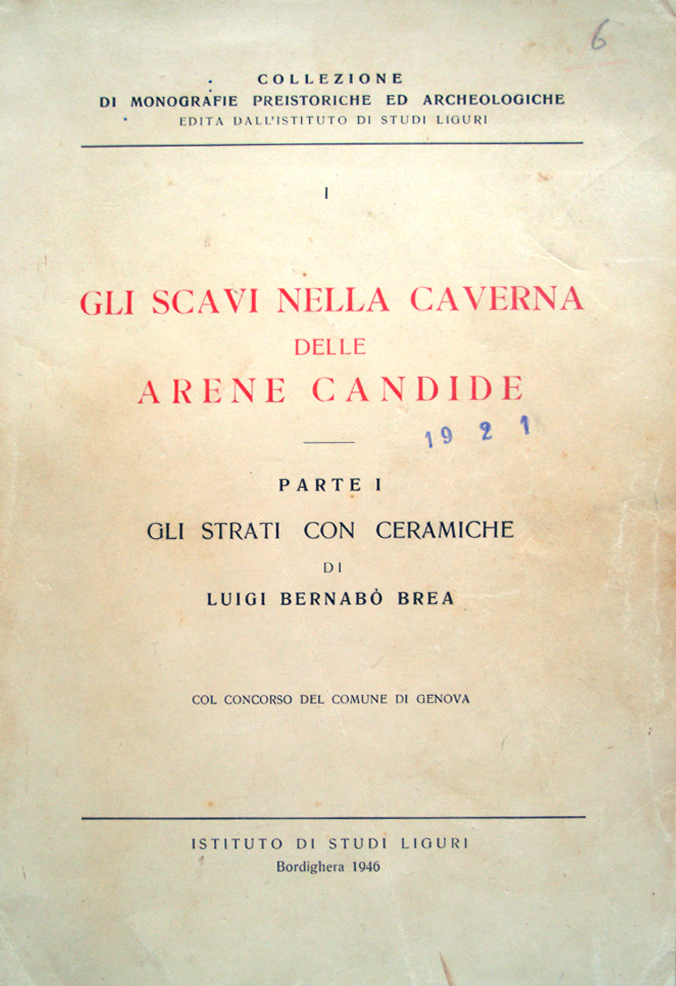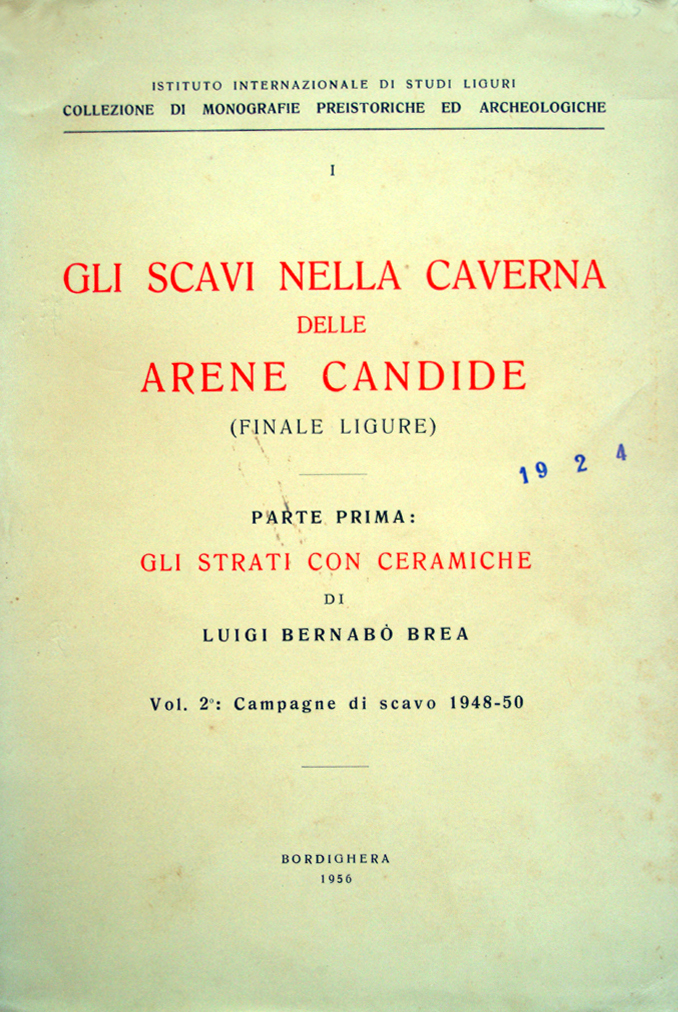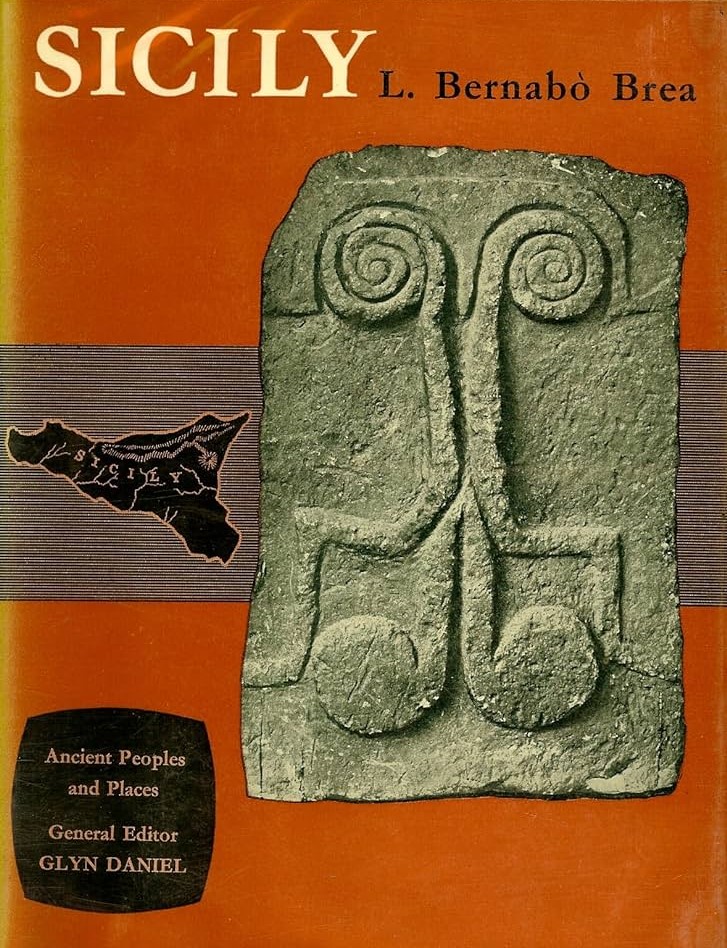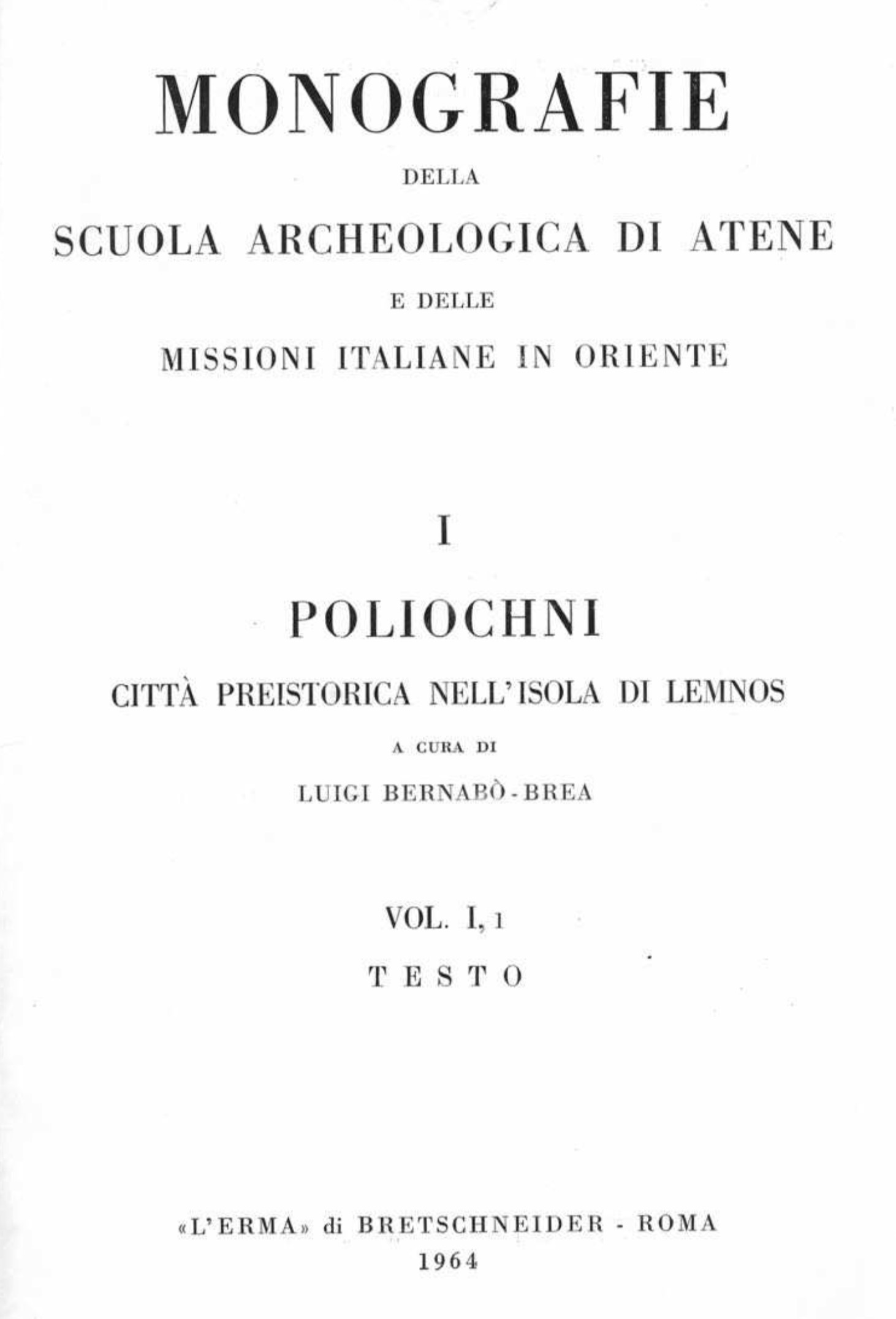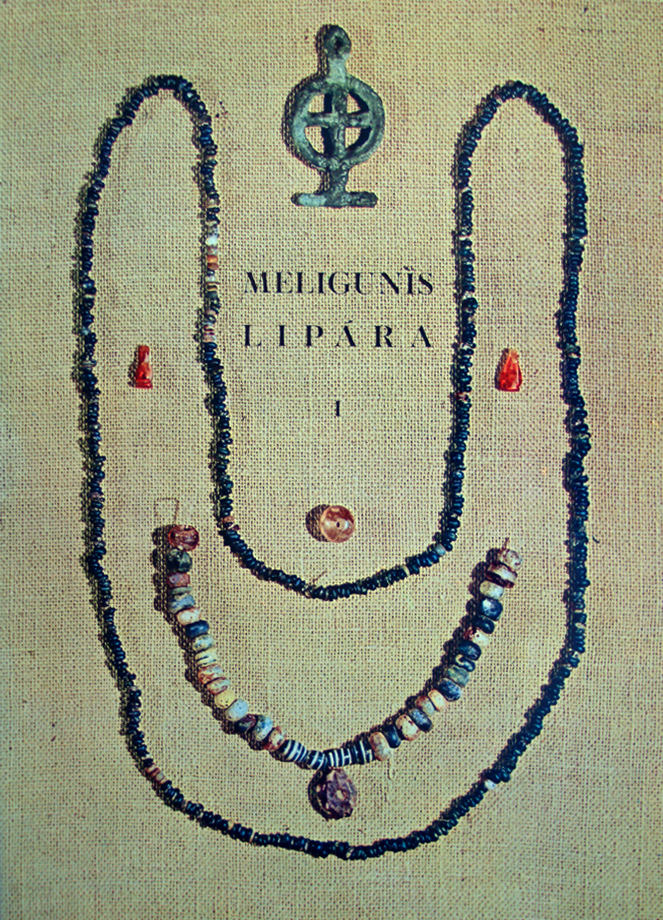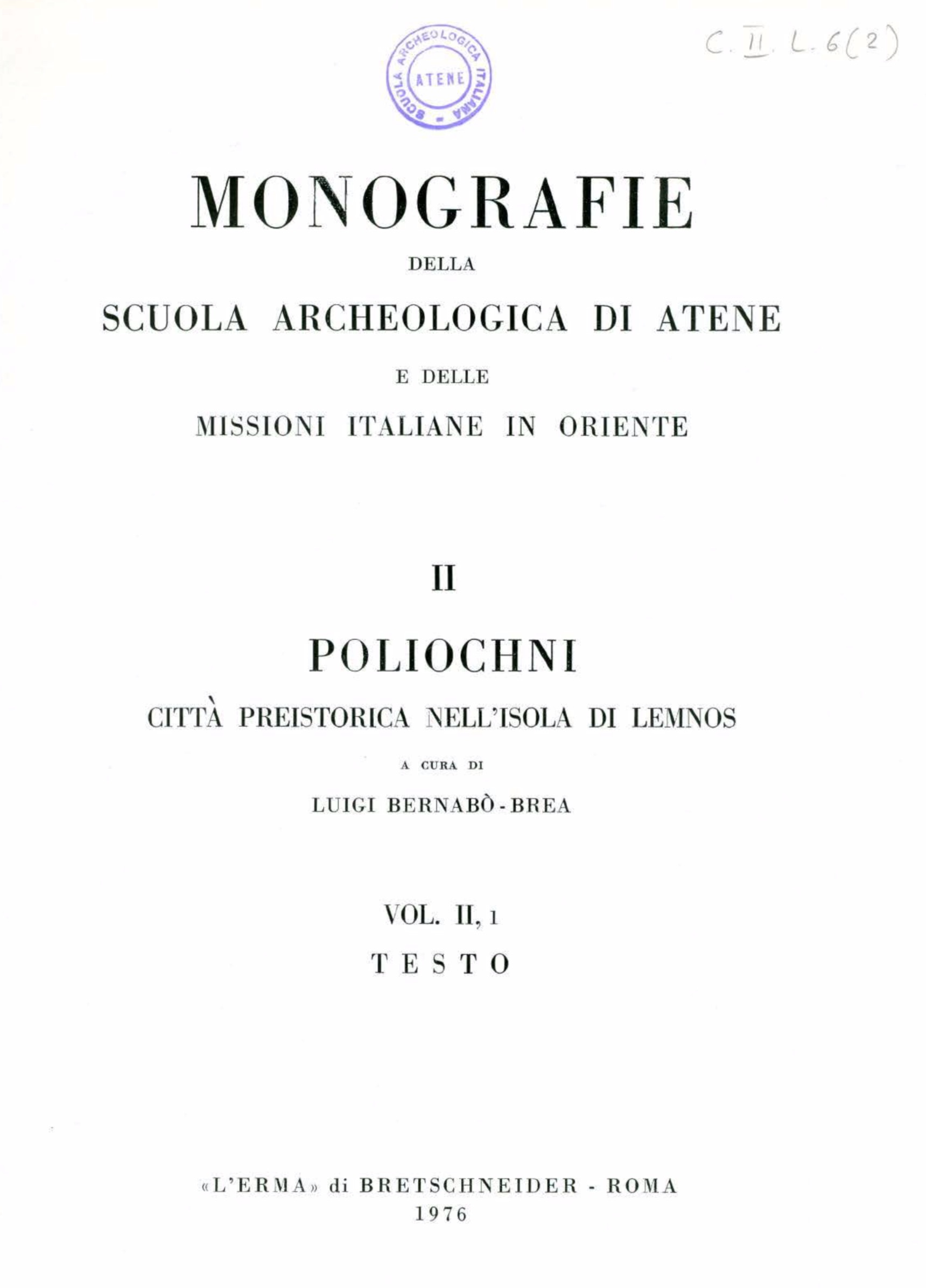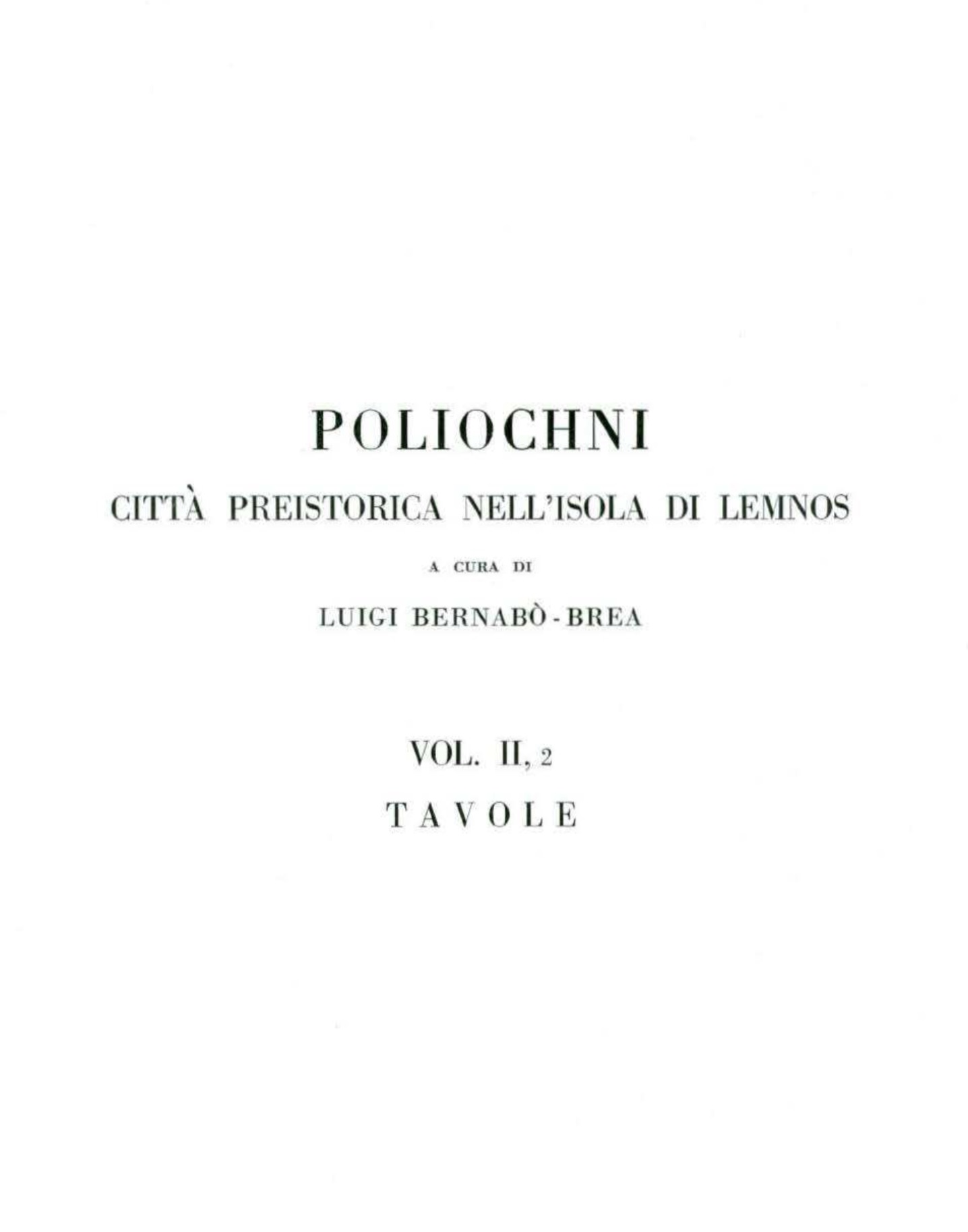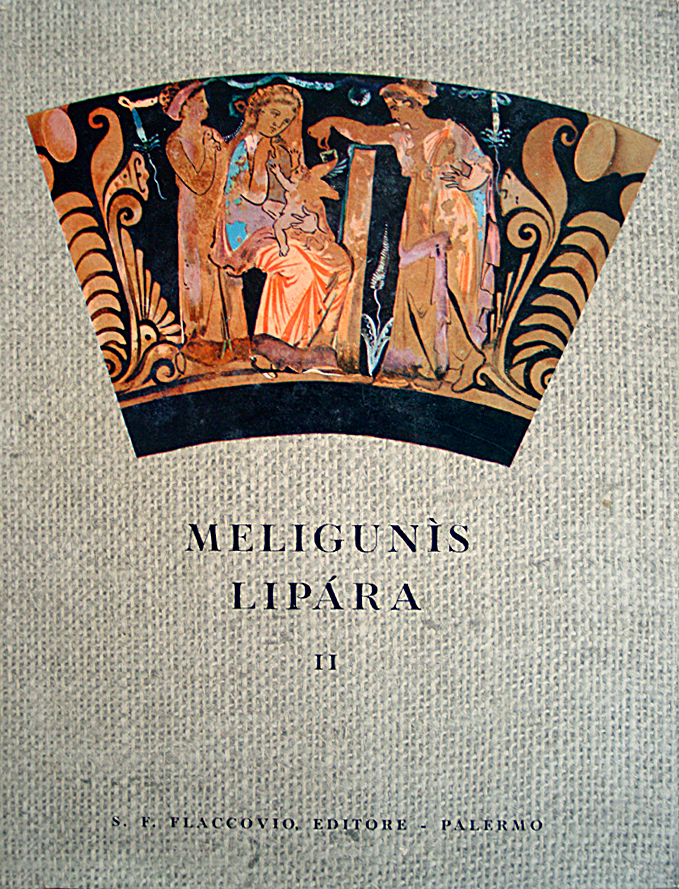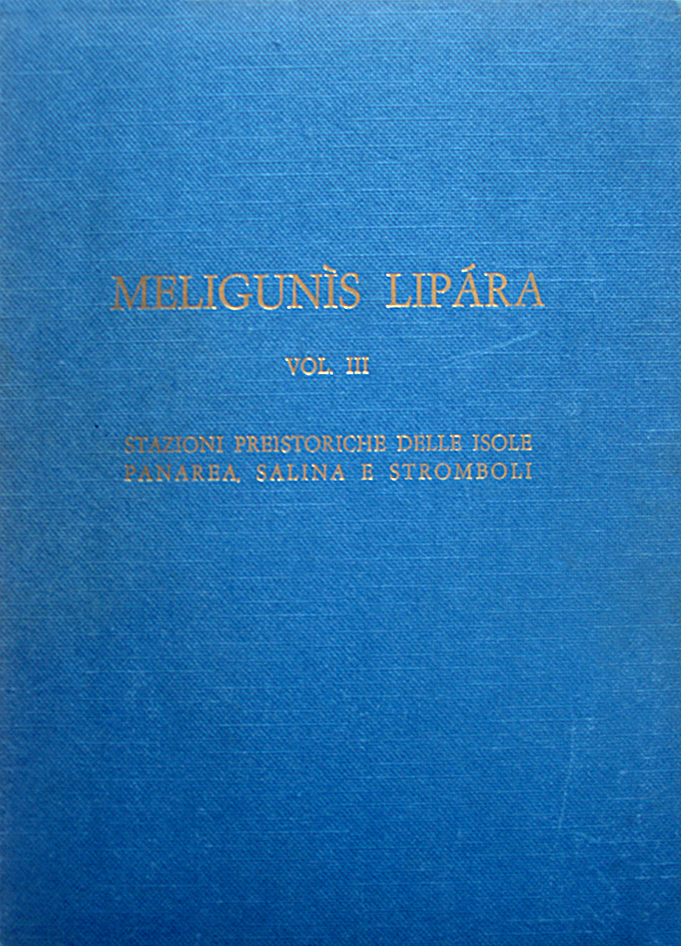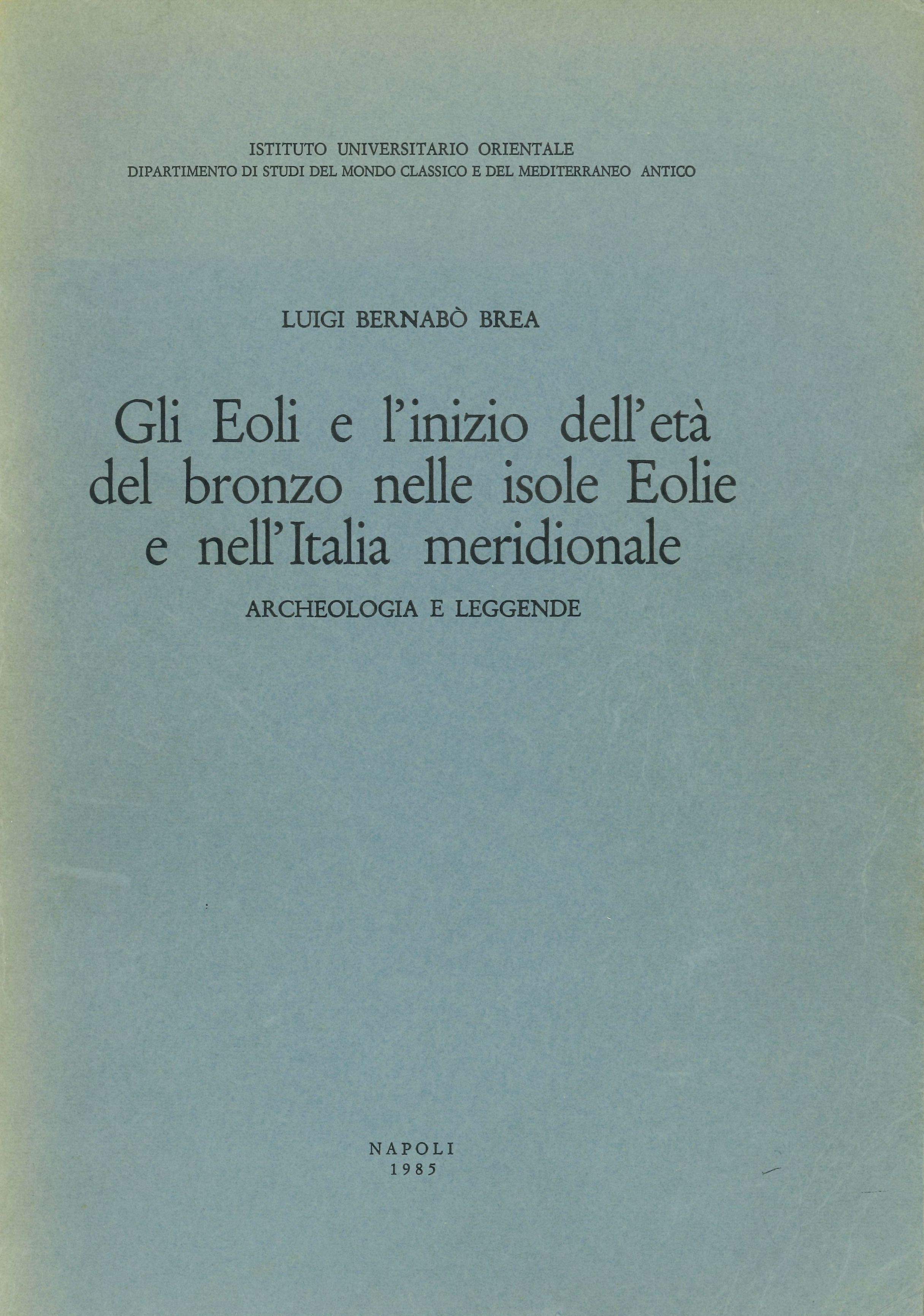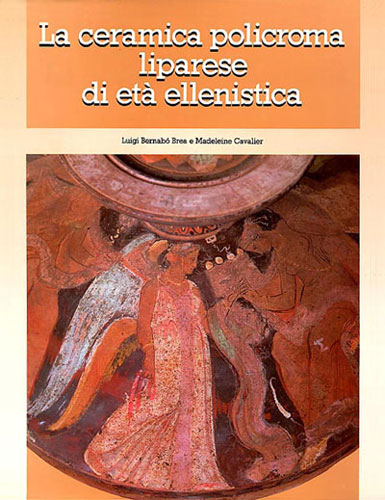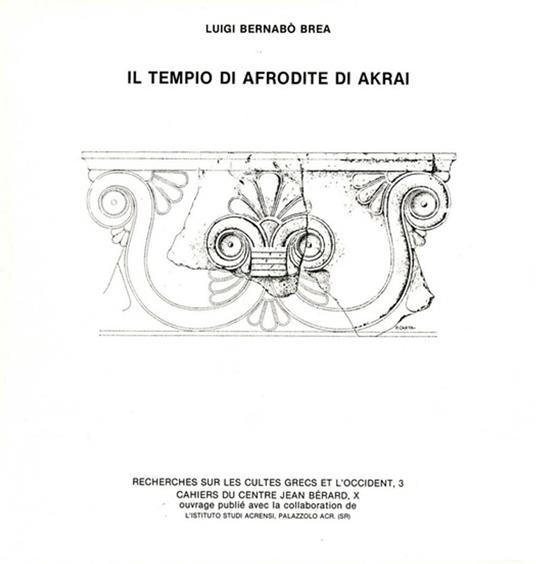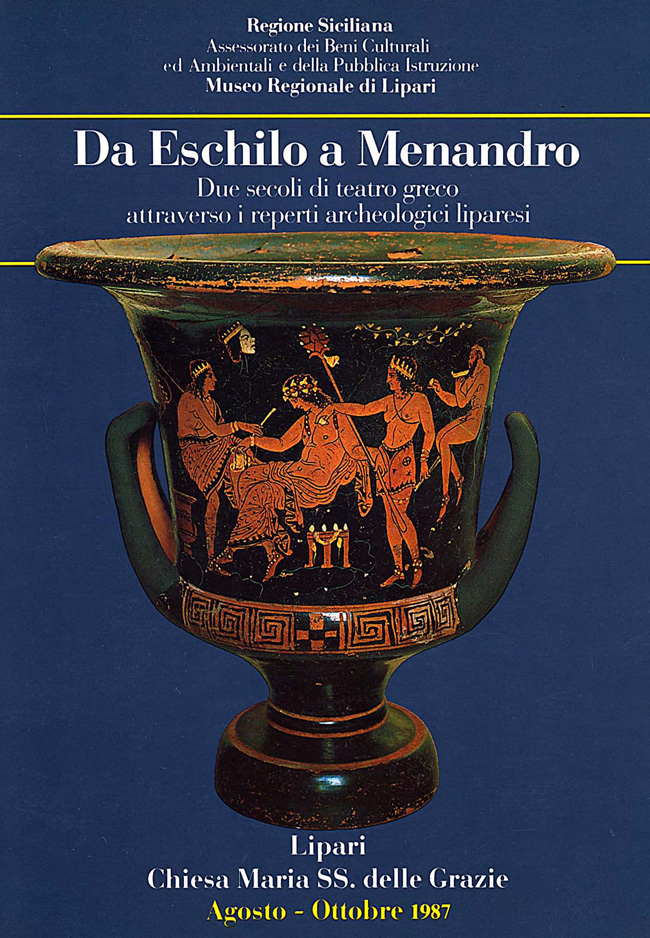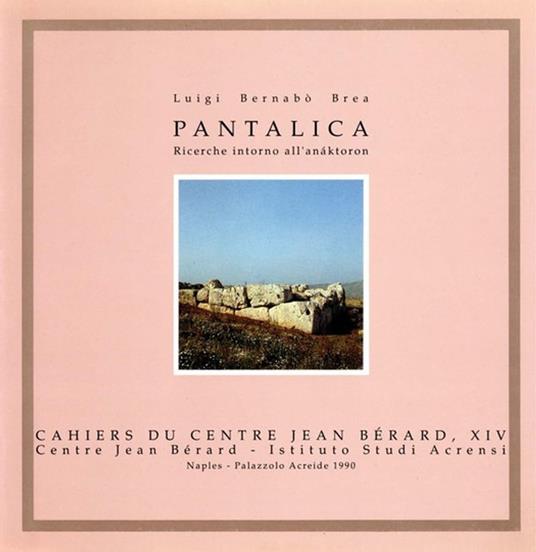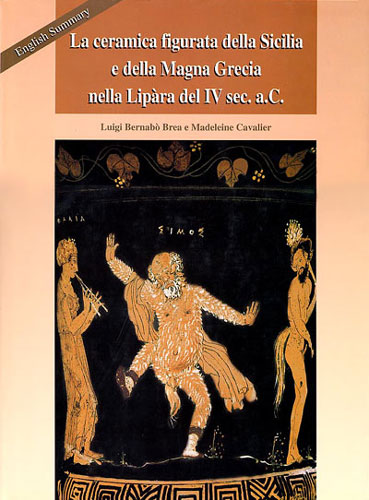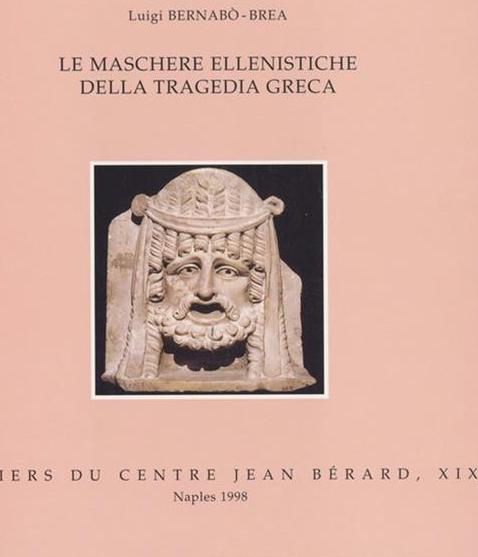VIDEO
This video "From Aeschylus to Menander" was realized between 1992 and 1996 by the Museo Regionale Archeologico Eoliano on Lipari, coordinated by Prof. Luigi Bernabò Brea and Madeleine Cavalier, and in collaboration with the Director of the Museum, Umberto Spigo. It was directed by Giovanna Bongiorno. The great educational value of the video, testified by many prizes received at the most prestigious international shows of archaeological cinematography, is also one of the most extraordinary and vivid memories of the great scholar after whom the Museum of Lipari is now named. In the video Luigi Bernabò Brea personally recounts the extraordinary story of the ancient Greek terracotta sculpture of Lipari. It testifies to the man as we remember him, a man of great scholarship and rare intellectual coherence: a Master of whom this video also captures for posterity his irony, his spontaneity, his humour.
Title: From Aeshylus to Menander
Production: Regione Siciliana, Assessorato Regionale Beni Culturali ed Ambientali, Museo Archeologico Eoliano
Realization: Kronos s.r.l. - Immagini per la Cultura e l'Ambiente, Author and Director: Prof. Giovanna Bongiorno
Lenght: 26 min. 32 sec.
BIOGRAPHY
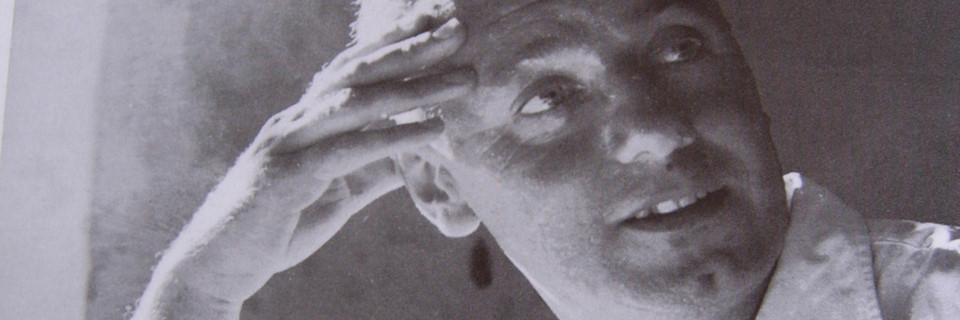
From the start of his career up to 1973
Luigi Bernabò Brea, born in Genoa on 27 September 1911, completed his education in that city, where he graduated in Jurisprudence in 1932. Subsequently, in pursuit of his own vocation, he matriculated in the University of Rome and graduated in Archaeology in 1935, under Prof. G.Q. Giglioli. He was a pupil of the Scuola Archeologica Italiana in Athens, then directed by Alessandro Della Seta, in the biennial periods 1935/36 and 1936/37, participating in the excavations on the island of Lemnos, at Poliochni (in 1936) and the Kabirion of Chloi on Lemnos (in 1937), which he himself had discovered.
On entering the Administration of the Antichità e Belle Arti dello Stato, he was appointed inspector of the Museo Nazionale at Taranto, directed by Ciro Drago, in October 1938, and in this role participated among other things in the excavations of Gnathia.
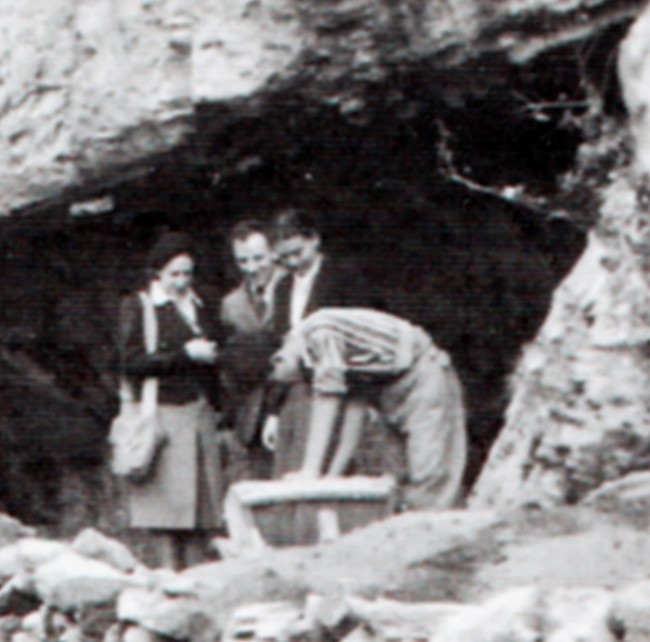
Luigi Bernabò Brea with his wife Chiara Chighizola (on the right) and Ginetta Chiappella (on the left), in front of the Arene Candide cave, 1942 (after Cavalier, Bernabò Brea M. 2002, detail).
In June 1939 he was called to establish and direct the newly created Soprintendenza alle Antichità della Liguria (De Lachenal, Maggi 2012). He was also appointed by the comune of Genoa to the post of Director of the Museo Civico di Archeologia Ligure di Genova-Pegli, a post he retained down to 1951, first making provision for the museum's evacuation in response to the dangers of war, and then its re-organization
The archaeological activity conducted in the field by Luigi Bernabò Brea in Liguria, apart from minor excavations conducted in the Iron Age burial site at Rossiglione and at Castelliere di Pignone, especially consisted of his excavations in the Arene Candide cave at Finale Ligure, which revealed a stratigraphic sequence of fundamental importance, especially for our knowledge of the Neolithic and Upper Palaeolithic. These excavations, conducted in collaboration with Luigi Cardini of the Istituto Italiano di Paleontologia Umana, were continued down to 1951. Bernabò Brea published a report on the strata and pottery that fell within his direct competence in two volumes between 1946 and 1956 (Bernabò Brea 1946; Bernabò Brea 1956).
At the end of 1941 Luigi Bernabò Brea was transferred to Syracuse, to the Soprintendenza alle Antichità della Sicilia Orientale, which he directed for 32 years until his retirement in 1973, dedicating to it the greater part of his life as a scholar and administrator.
Having arriving in his new job in the middle of the war, his first task was to complete the evacuation of the Museum in Syracuse, already in large part implemented by his predecessor G. Cultrera. His first scientific task was the study of the monuments of ancient Akrai, later published in 1956.
Once the war had ended, Bernabò Brea immediately dedicated himself to repairing and restoring the monuments devastated in the war and re-organizing the Museum of Syracuse in its new seat in the Piazza Duomo, partially reopening it in 1947 and totally in 1949. At the same time he was also able to begin his first activities in the field, especially aimed at the exploration of the regions most distant from the headquarters of the Soprintendenza and those archaeologically least known, such as the province of Enna (prehistoric cemeteries of Calascibetta) and the Tyrrhenian zone of the province of Messina (Milazzo, Longane, San Basilio di Novara, Tindari, Alaesa). His first surveys in the Aeolian Islands and excavations at Piano Quartara and the village of Milazzese on Panarea took place between 1947 and 1950.
The re-organization of the prehistoric materials mainly excavated in their time by P. Orsi and I. and C. Cafici, undertaken in view of the Museum's new display, led him among other things to the identification of some deposits of the Upper Palaeolithic and Mesolithic, not hitherto recognized, in some of which, such as Grotta Corruggi, he was able to conduct trial excavations. More especially, however, the reordering of the Museum's artefacts permitted him to lay the foundations for a total reconsideration of the succession of prehistoric and protohistoric cultures in Sicily, also formulated on the basis of new explorations in the field, notably in the Aeolian Isles. The most complete formulation of this succession was later published in his book Sicily before the Greeks in 1957.
Despite his intensive Sicilian activity, Luigi Bernabò Brea also resumed, after the interruption of the war, his excavations in the Arene Candide cave between 1948 and 1950. A study trip to southern France and Spain in 1948, after the long closure of the frontiers caused by the war, provided him with the opportunity to amplify the coordinates of the cultural development of the Western Mediterranean that he was in the process of defining.
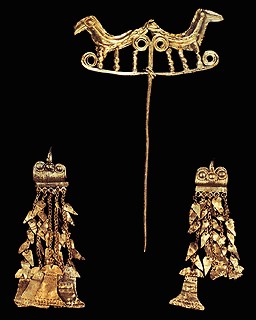
Poliochni (Lemnos). Gold pin and earrings from the treasure. Athens, National Archaeological Museum. Hellenic Ministry of Culture/ARF. Scuola Archeologica Italiana di Atene (ed.), Lemnos. Ipolitis Poliochnis, Hellenic Ministry of Culture-ARF, Athens 1987, cover picture and p. 6. © Hellenic Ministry of Culture.
In 1951 Luigi Bernabò Brea was commissioned by the Scuola Archeologica Italiana in Athens, directed by Doro Levi, to resume the excavations of the Bronze Age settlement site at Poliochni on the island of Lemnos. This campaign then led to the publication of the earlier excavations conducted by the School on the site between 1930 and 1936. The new excavations at Poliochni, conducted in 1951 and in 1956, permitted him to identify the sequence of cultural phases since the origins of the settlement. A particularly fortunate event was the discovery of a treasure of gold jewellery in 1956; it is roughly of the same date as and has close affinities with the great treasure of jewellery found at Troy.
The mission on the island of Lemnos ended in 1961 with two important events: the inauguration of the Museum of Myrina in 1961, in which were gathered the finds from Poliochni and those yielded by the excavations of Efestia, the Kabirion of Chloi, Myrina itself, and those on the islands of Imbros and Tenedos; and the publication of two important reports of the excavations in 1969 and 1976 Bernabò Brea 1969 e Bernabò Brea 1976.
Activity of Superintendent Luigi Bernabò Brea in Eastern Sicily
It is impossible to sum up briefly the intensive archaeological activity performed by Luigi Bernabò Brea from the end of the war to 1973, as head of the Soprintendenza alle Antichità della Sicilia Orientale, in the five provinces that fell under his jurisdiction. His various activities covered the safeguard, conservation and restoration of archaeological monuments, field exploration, excavation, the creation of organized archaeological zones, of the antiquaria relating to them, and the setting up of local museums.
It should not be forgotten, in fact, that these years were also marked by a formidable expansion of building and industrial development in Sicily which Bernabò Brea had to counter, in defence of the archaeological heritage. His struggle to defend that heritage was unremitting and uncompromising. At the same time the difficult administration of the huge sums that the Cassa per il Mezzogiorno, in particular, was then investing in the cultural field put to the test his remarkable administrative gifts. Thanks to his commitment, many restorations and reconstructions of monuments were carried out, and archaeological parks established; they attest to an unconventional approach, though with absolute respect for the monuments in question, and a remarkable attention to the legitimate needs of the public. It is enough to recall in this regard, the setting up of the "Parco della Neapolis" at Syracuse comprising the main classical monuments of the city, from the Greek Theatre to the ancient quarries of Latomia; the restoration of the Theatre of Taormina; the excavation and restoration of the Roman city of Tyndaris; that of the great Roman villa at Piazza Armerina; and the reorganization of the antiquities of Akrai (Bernabò Brea 1985; Voza 2002).
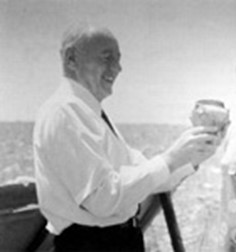
Luigi Bernabò Brea in Thapsos with a Mycenaean vase from excavations in the 1970s (photo G. Voza. After Cavalier, Bernabò Brea M. 2002, detail).
Given the impossibility of personally following the scientific research on the too vast territory covered by the Soprintendenza, while maintaining in his role as Soprintendente responsibility for and surveillance of all the activities taking place, he delegated a number of important tasks to his assistants, including Gino Vinicio Gentile, Paola Pelagatti, Giuseppe Voza and the present writer. He also encouraged collaboration with foreign Institutes, such as the Ecole Française in Rome which had begun at this time its excavations at the Greek site of Megara Hyblaea, those of the University of Princeton at Morgantina and many more
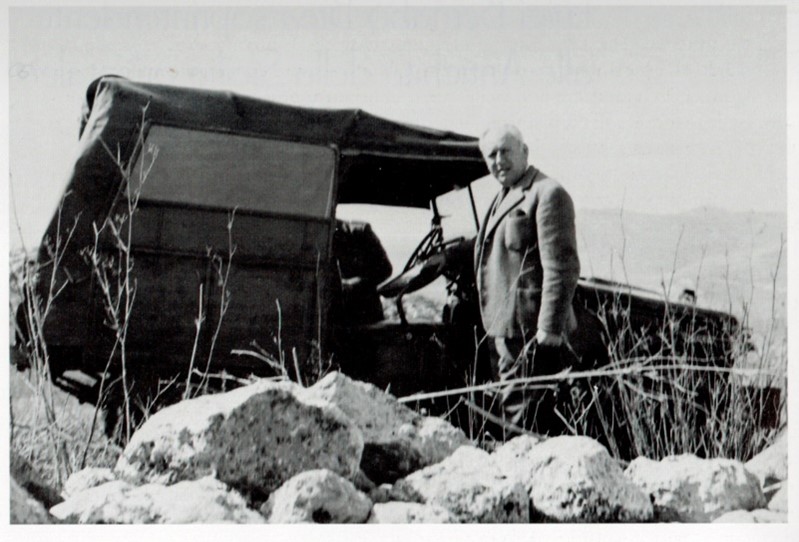
Superintendent Luigi Bernabò Brea on a survey in Rodì, 1968 (after Cavalier, Bernabò Brea M. 2002).
Among the innumerable archaeological digs conducted by the Soprintendenza during these years, we may record here the main ones in the prehistoric field:
- in the province of Messina, the excavations of the Riparo della Sperlinga, of the settlement sites of Tripi, Tindari, Longane, Monte Scurzi and Naxos, of the burial site of Rodi and Milazzo , of the villages of Milazzese at Panarea, Capo Graziano, Filo Braccio, Casa Lopez at Filicudi, Serro dei Cianfi and La Portella at Salina, Castellaro Vecchio, Piano Conte, Diana and Castello at Lipari, and the cemeteries of Piazza Monfalcone at Lipari and Milazzo;
- in the province of Enna, the excavations of the burial sites of Malpasso, Realmese, Calcarella and Valle Coniglio at Calascibetta;
- in the province of Catania, the excavations of the caves of Novalucello, Pellegriti, Pietralunga and Maccarone, of the "Sapienza" burial site, of the settlements of the contrade Zorio, Marotta, Naviccia, the village of Predio Garofalo, the huts of Poggio dell'Aquila at Adrano, the settlements of Palikè, the necropolis Luigi Bernabò Brea e sua nipote Mariaof Grammichele, the trial digs on the acropolis of Paterno and the finds at Biancavilla
- in the province of Syracuse, the excavations of the huts of Metapiccola and the tombs of the Valle di S. Eligio at Lentini, the villages of Stentinello and Ognina, the caves of Conzo, Chiusazza, Genovese, Palombara, Masella di Buscemi, and Calafarina at Pachino, the necropolis of Thapsos, that of Pantalica and the restoration of the Anaktoron.
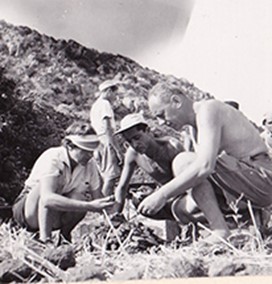
Luigi Bernabò Brea and Ginetta Chiappella on the excavation of the Montagnola di Capo Graziano site, on Filicudi, 1952 (after Cavalier, Bernabò Brea M. 2002).
For his part, Luigi Bernabò Brea concentrated his own interests as a scholar especially on the Aeolian Isles and the zones close to the province of Messina (Milazzo, Tyndaris) where he was able to avail himself of my assistance since 1951, when I established myself on Lipari, and began, and ensured the continuity and systematic conduct of, the exploration of the island, which has been pursued uninterruptedly since then.
Luigi Bernabò Brea's career from 1973 to 1999
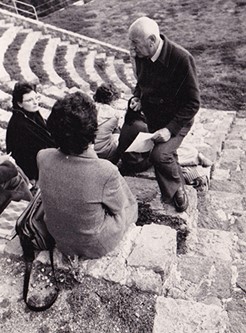
A lesson by Luigi Bernabò Brea to the students of the University of Catania's School of Specialisation, in the theatre he built on the Castle of Lipari on a Greek model.1983 (after Cavalier, Bernabò Brea M. 2002).
Ever since he officially retired from his post in January 1973, Luigi Bernabò Brea dedicated himself almost entirely to the Aeolian Isles and the Museum of Lipari.
Due to a series of favourable circumstances, the excavations on the Aeolian Isles were particularly fortunate. At Lipari, as far as prehistory is concerned, excavations on the Castello and the plain below it produced a complete and undisturbed stratigraphic sequence. This permitted Bernabò Brea to reconstruct the cultural evolution of the island from the onset of the middle Neolithic to the historical era. His reconstruction represents to this day the paradigm for the cultural evolution also of Sicily and Southern Italy.
The minor sites of Lipari and the settlements of Filicudi, Panarea and Salina provided extremely important confirmations of and complements to the cultural sequence defined on the basis of the stratigraphy revealed by the excavations on the site of the Castello of Lipari
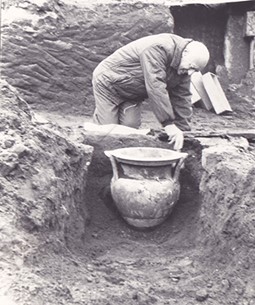
Luigi Bernabò Brea during excavations in the contrada Diana necropolis, 1984 (after Cavalier, Bernabò Brea M. 2002).
As a result of the same geological phenomenon that had given rise to the exceptional stratigraphy of the prehistoric site of the Castello, the huge necropolis of Cnidian Lipára has also survived virtually intact. It continued to develop, without interruption, right down to the Late Roman period. Extending over the Contrada Diana, it was buried under metres of volcanic sediments, laid down by successive eruptions; it is unique among the great contemporary cemeteries of Sicily, Magna Graecia and Etruria in having escaped the depredations of tomb-robbers over the centuries. The systematic excavation of the necropolis (over 2600 tombs of the Greek and Roman periods have so far been excavated) has represented an inexhaustible source of information in the most diverse fields and yielded a huge mass of artefacts, sometimes of high art-historical quality, as well as of archaeological interest, especially in the field of red-figure pottery, initially of Attic production, then, in the 4th century BC, of Siceliot or Campanian manufacture.

Luigi Bernabò Brea describes a group of statuettes found in a tomb in the necropolis in the contrada Diana. 1993 (after Cavalier, Bernabò Brea M. 2002).
The excavation of the necropolis also revealed two distinctive local crafts: that of polychrome pottery, which flourished in the first half of the 3rd century BC and is the work of the Lipari Painter and other potters of his circle (Bernabò Brea 1986; Bernabò Brea 1997, and that of terracottas representing theatrical themes (miniature models of the masks used in the performance of tragedies, and those associated with the satirical drama and comedy, statuettes of comic or satirical actors) which began in the early years of the 4th century and developed over a period of one and a half centuries. The over 1300 pieces found provide an exceptionally rich and complete documentation on the stage costumes of the Greek theatre, the art of the theatrical mask and their evolution (Bernabò Brea 1987) , (Bernabò Brea 1988).
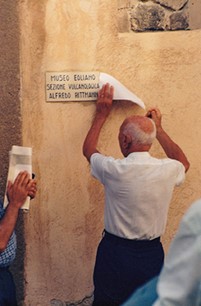
Luigi Bernabò Brea affixes a plaque to the temporary volcanological section of the Lipari Museum. 1995.
The end-result of all this field work was the creation of the Aeolian Museum, which is in constant and rapid expansion within the various pavilions on the Castello of Lipari.
The reports of the Aeolian excavations have been published in the series Meligunìs Lipàra, begun in 1960. The series has now reached Volume XII, while a series of monographic studies and specialized articles has been devoted to the various classes of Aeolian finds, prehistoric, classical and medieval.
Study and publication of the prehistoric and historical remains of Lipari did not, however, exhaust the activity of Luigi Bernabò Brea during these years; with my collaboration, he also wished to gather the scientific legacy of his master and friend Luigi Cardini, editing the publication (1989 and 2000) of Cardini's excavations on behalf of the Istituto Italiano di Paleontologia Umana in the caves of Praia a Mare (Calabria).
Other interests of Luigi Bernabò Brea
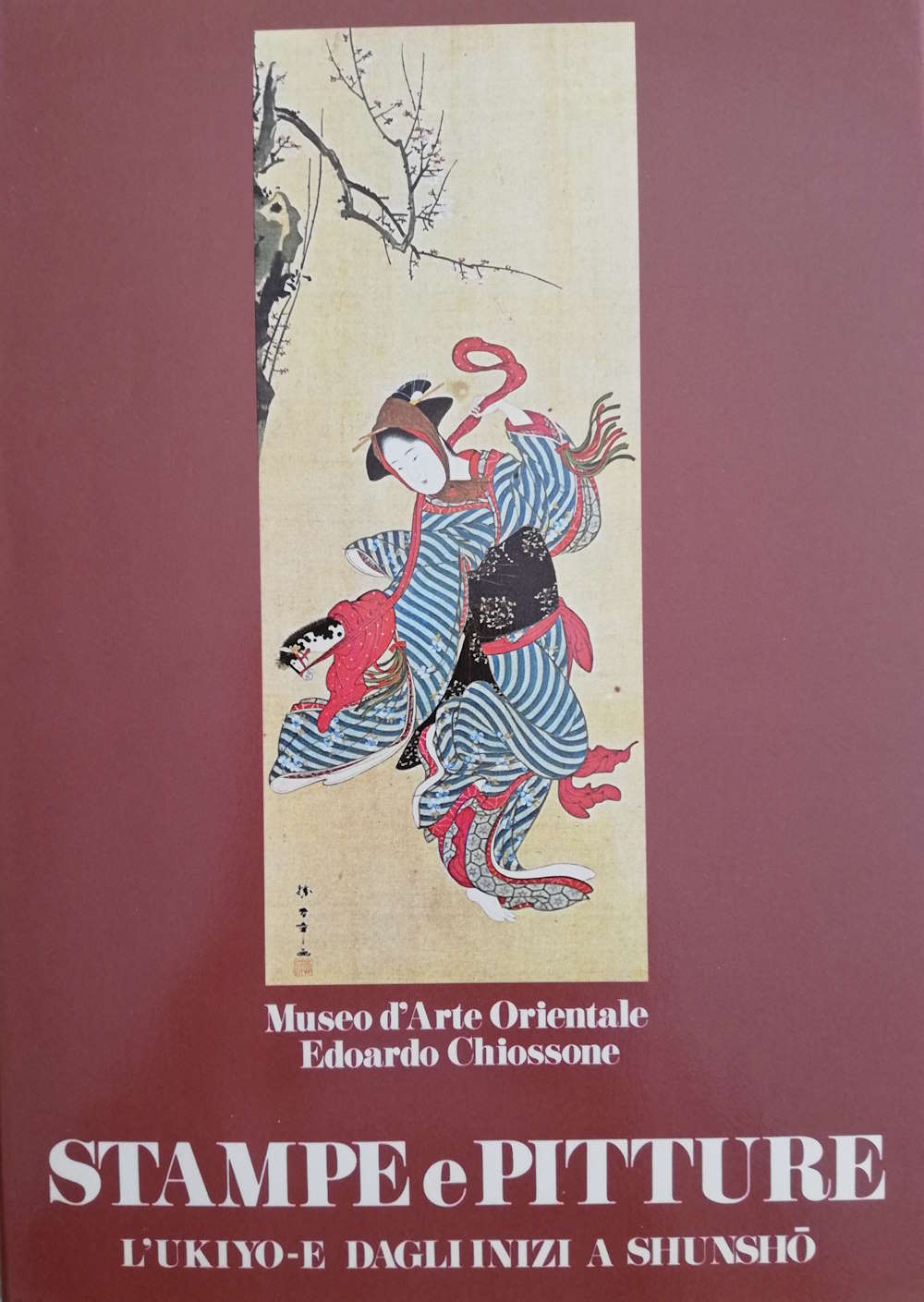
The cover of the volume on Ukiyo-e prints published by Luigi Bernabò Brea and Eiko Kondo in 1979.
Since Bernabo Brea's cultural horizons were not limited to Mediterranean archaeology, it is worth mentioning, lastly, the work he pursued in the field of Japanese art, a field in which he had shown an interest ever since his early youth.
The depth of this interest is testified by a catalogue of the works of Ukiyo-e in the collection of the Museo d'Arte Orientale E. Chiossone in Genoa , published in 1979 in collaboration with the Japanese scholar Eiko Kondo.
Luigi Bernabò Brea died on 4 February 1999, while he was working on Volume XI of Meligunìs Lipára.
Il Museo eoliano “Luigi Bernabò Brea”
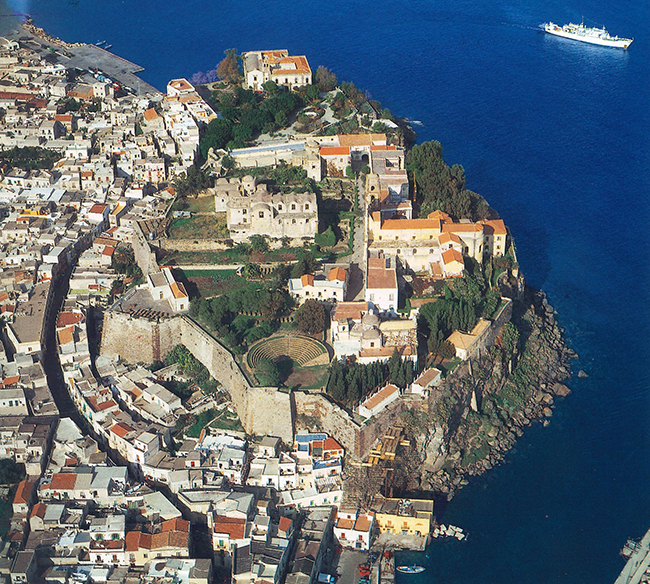
Aerial view of the Lipari Castle.
The Aeolian Museum, which since 2000 has been named after Luigi Bernabò Brea, collects material from the archaeological excavations which have been carried out since 1947 on the Aeolian Islands and in Milazzo.
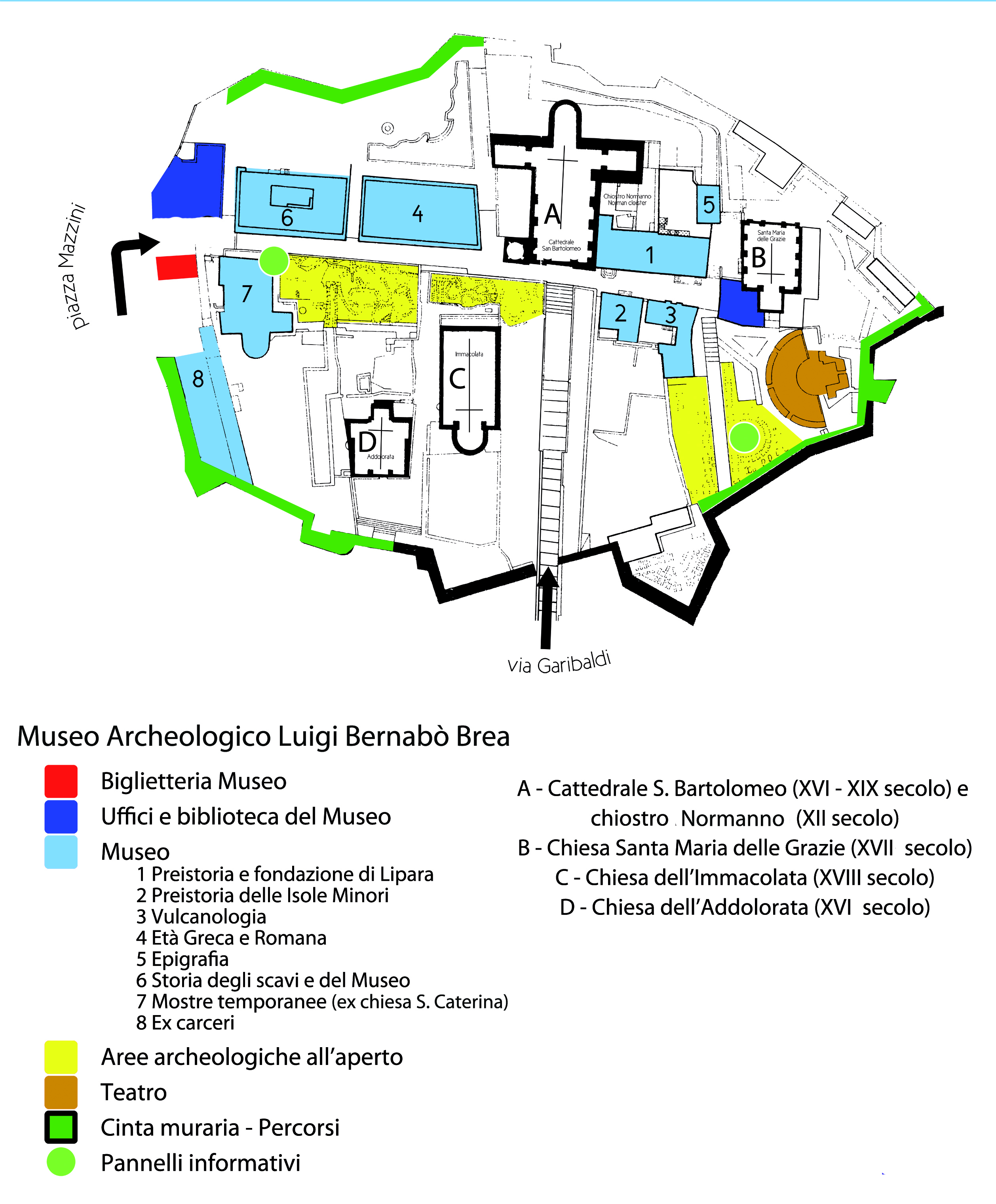
Plan of the Lipari Castle.
The official opening date of the museum is 1954. At that time, it was located in the old Bishop's Palace, now housing the prehistoric section. In the following years, it expanded to other buildings in the Castle, with exhibition rooms, storerooms and workshops, as both the renovation of the buildings and archaeological research progressed. From the archaeological excavations on the Castle, in Contrada Diana and on the smaller islands, an enormous quantity of artefacts from different periods has in fact flowed in.
The museum is therefore distributed over several buildings, housing various sections. Passing through them, one can trace the stages of the many millennia of civilisation on the Aeolian islands, from when man first set foot on them in search of obsidian (before 5.000 B.C.), until the Christian and Byzantine period (V-VI century A.D.).
The sections are:
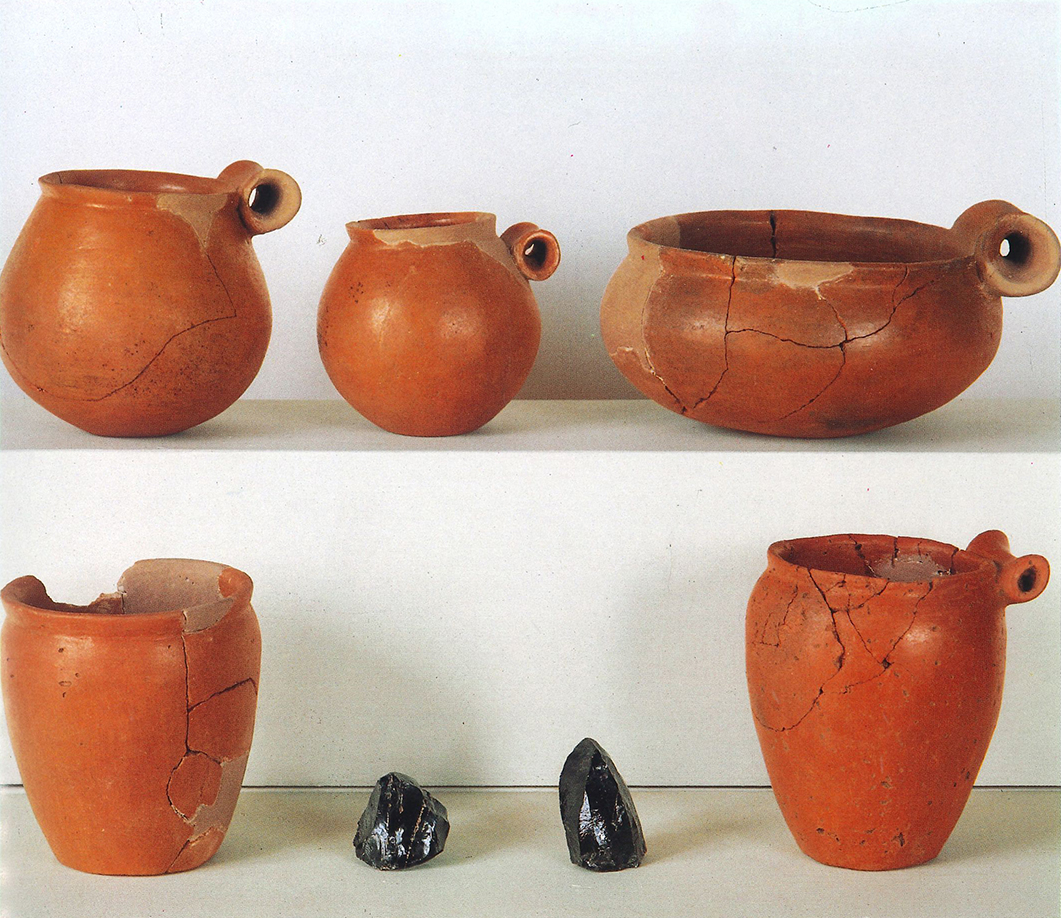
Neolithic vases of Diana style and obsidian cores. – fine V mill. a.C.
- The prehistoric section (from the Neolithic to the final Bronze Age) and the Greek foundation of Lipari (580-576 B.C.)
- The section on the prehistory of the Minor Islands, updated on 2015 by M.C. Martinelli with the results of recent excavations in the Bronze Age villages of Salina, Filicudi and Stromboli
- The section on the archaeology of Milazzo, with its Bronze Age and Greek Age necropolises
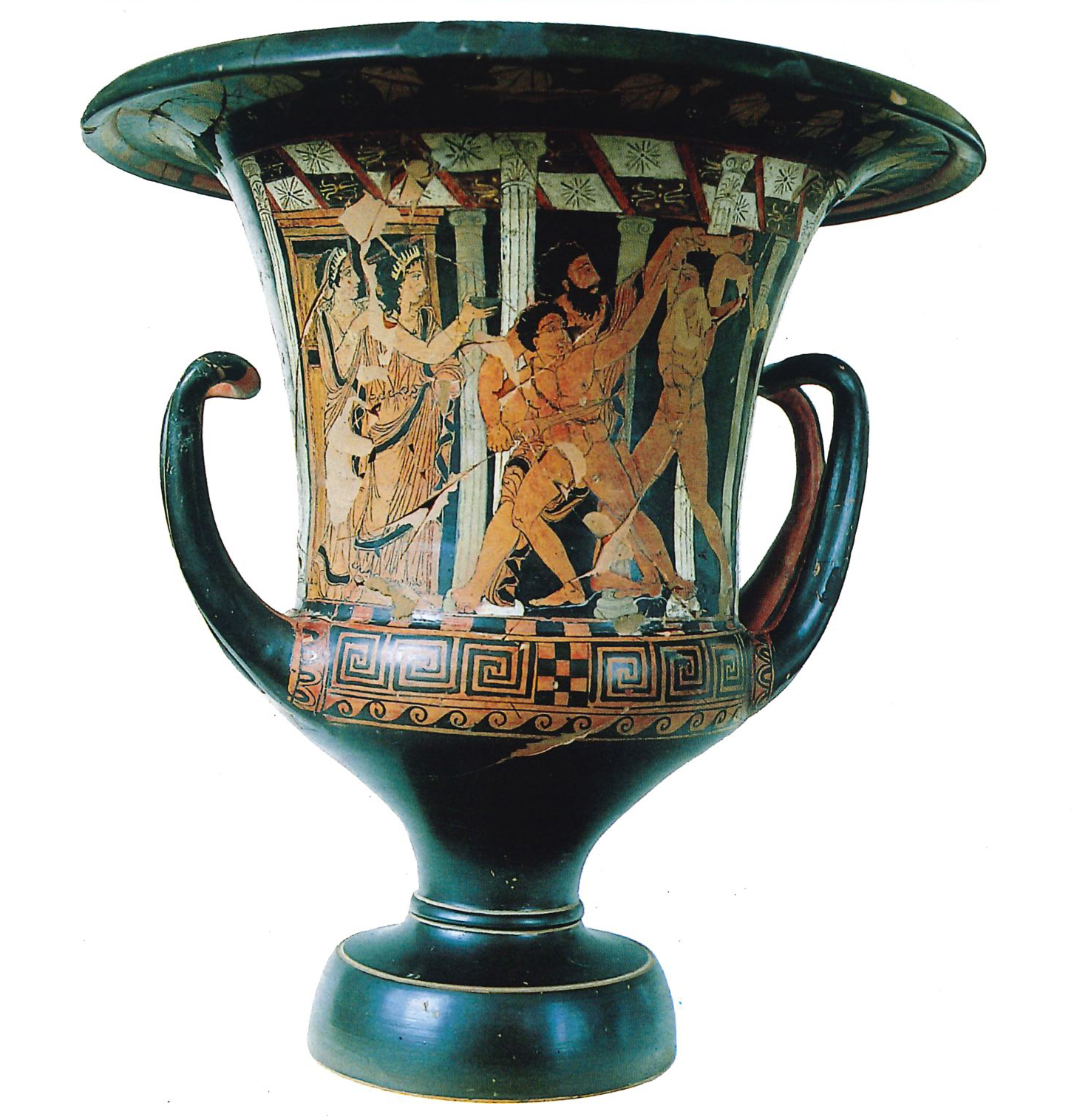
Adrasto divides Tideo and Polinice. Crater of Sicilian style, middle of the 4th century B.C.
- The section of the Greek and Roman necropolises in contrada Diana, with wonderful Greek painted pottery and the extraordinary collection of theatre masks models.
- The section of Underwater Archaeology, exhibiting artefacts from around 20 wrecks found around the Aeolian Islands (from the Bronze Age to the 17th century)
- The Museum of Memory, which traces the history of the first archaeological researches in the Aeolian Islands and the museum's foundation.
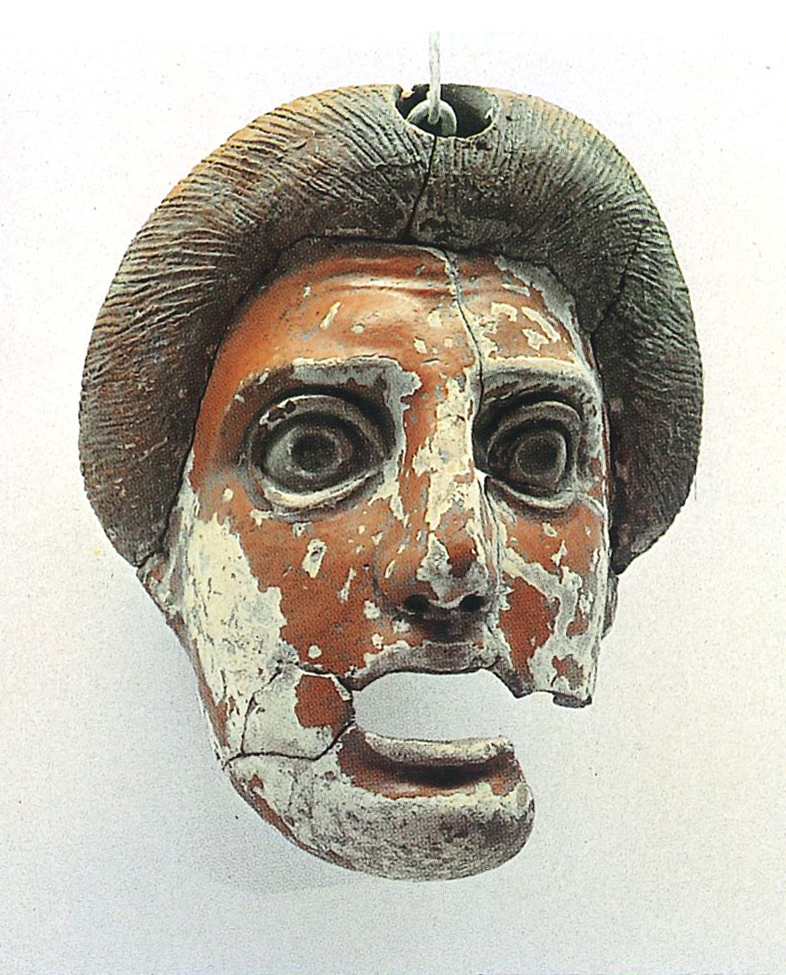
Mask-characters of the new comedy: the young man (first half of the 3rd century B.C.
As in numerous archaeological studies, Luigi Bernabò Brea was a forerunner in the field of museography, in the attention he paid, as early as the 1950s and 1960s, to making exhibitions comprehensible and interesting for all, in the awareness of the public's right to know and understand the documents of their remote history.
In the Museum of Lipari, where Luigi Bernabò Brea's museographic conception is fully realised, the exhibition has been realised with deliberate simplicity, in order to highlight the materials on display, supplemented by captions and short panels that provide essential information. The display of materials is accompanied by some reconstructions of the excavation areas: the cemeteries of Piazza Monfalconeand and a sector of the Greco-Roman necropolis of Contrada Diana in Lipari, those of Piazza Roma and Predio Caravello in Milazzo; a short section of the seabed in the Underwater Archaeology section.
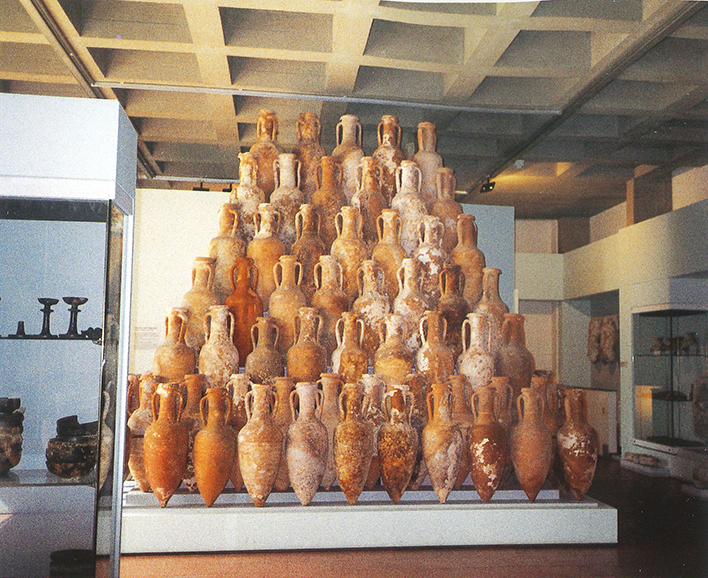
Amphoras from Capo Graziano of Filicudi, wreck A. 2nd century B.C.
The visit to the museum is completed by the remains visible outside it, that is, the stratigraphic succession of prehistoric huts brought to light on the Castle of Lipari and the archaeological areas visible in various parts of the island of Lipari: the Greek and Spanish walls, the Roman baths, the archaeological park in Contrada Diana, the late Roman hypogea, the Mycenaean tholos in San Calogero.
Finally, outside Lipari, in the spectacular sites on the islands of Salina, Filicudi and Panarea, the structures that have been preserved in view provide an in-depth insight into a Bronze Age village.
The Luigi Bernabò Brea Museum is an Institute of the Regione Sicilia, Department of Cultural Heritage, and is part of the Archaeological Park of the Aeolian Islands (https://parchiarcheologici.regione.sicilia.it/isole-eolie/en).
All images are taken from the book L. Bernabò Brea, M. Cavalier, Il Museo Eoliano di Lipari. Milazzo, Oreste Ragusi editore.
"Their use is authorised by the Regional Archaeological Park of the Aeolian Islands, in accordance with the regional normative of Regione Sicilia on the reproduction of cultural heritage. We thank the Director of the Park, Arch. Rosario Vilardo, for authorisation."
Bibliographic references:
- L. Bernabò Brea, M. Cavalier, Il castello di Lipari e il museo archeologico eoliano, Palermo, Flaccovio ed., 1977.
- L. Bernabò Brea, M. Cavalier, Il Museo Eoliano di Lipari. Milazzo, Oreste Ragusi editore, 1980.
- L. Bernabò Brea, M. Cavalier, Isole Eolie. Vulcanologia e archeologia. Muggiò, Oreste Ragusi editore, 1992.
- L. Bernabò Brea, M. Cavalier, U. Spigo, Lipari, Museo Archeologico Eoliano , Palermo, Ed. Novecento, 1994.
- U. Spigo, M.C. Martinelli, a cura di, Dieci anni al Museo Eoliano (1987-1996). Ricerche e studi, Quaderni del Museo Archeologico Regionale Eoliano,1 , Regione Siciliana, Assessorato Beni Culturali, Messina, 1996.
Luigi Bernabò Brea and
the Japanese culture

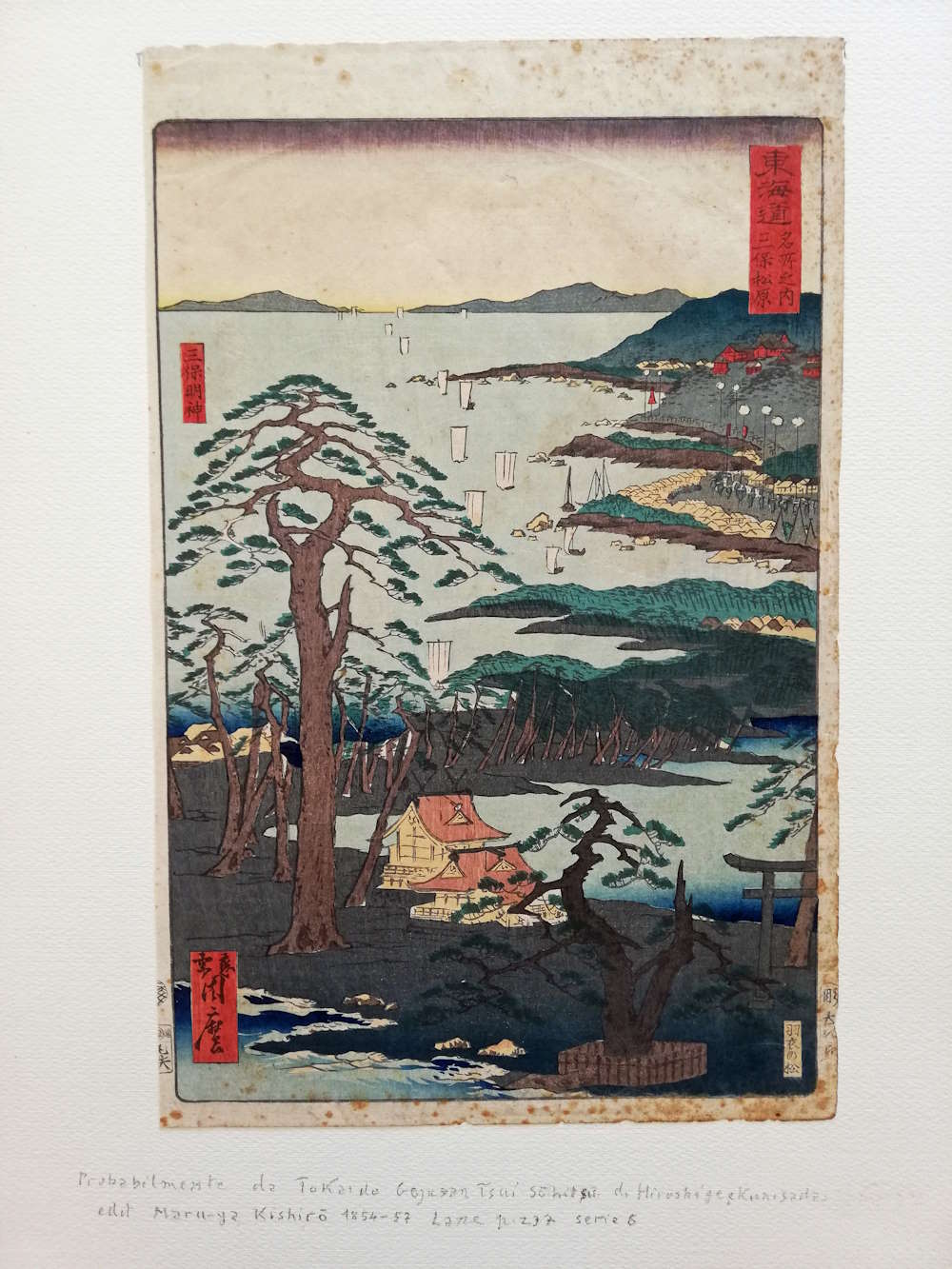
Kawanabe Kyōsai (1831–1889). Station 58 of the series: "Famous Places of the Tōkaidō" Around 1863 (L. Bernabò Brea collection).
In the early 1930s, Luigi Bernabò Brea, very young at the time, came into contact with the Museo d' Arte Orientale "Edoardo Chiossone" in Genoa and its heritage, which is one of the most important in Europe. He began to take an interest in cataloguing the splendid polychrome woodcuts of the Edo period, which had been left in the shadows by research until then (Failla 2004, p. 206). He began a thorough investigation, which was made extremely complex by the lack of instruments available in Italy, and continued it until 1935, when his professional engagements forced him to leave Genoa.
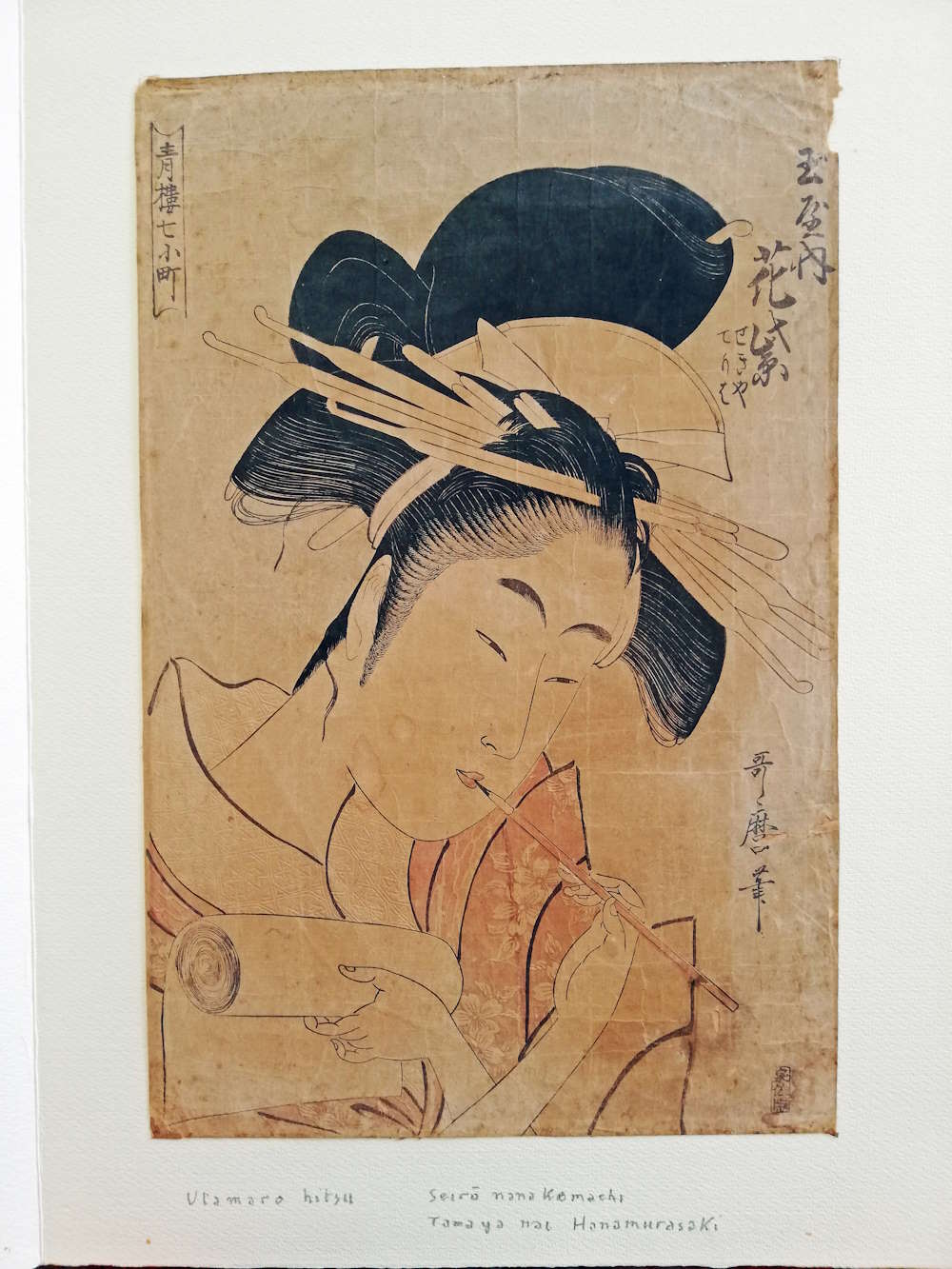
Utamaro hitsu (1753-1806) - The oiran Hana Murasaki is about to write a letter. She holds a roll of paper in one hand and the paintbrush to her lips with the other. Around 1790 (L. Bernabò Brea collection).
He could only resume this work in 1971, when the Chiossone Museum was finally reopened, after the long years following its clearing out during the war, and experienced a happy moment of rebirth. In cooperation with the Museum Director, Luigi Bernabò Brea organised a series of exhibitions related to individual authors or specific themes.
It would be an underestimation to reduce the significance of this work to a mere aesthetic interest: "It is important to remember that these exhibitions and their catalogues, for the first time in Italy, had the merit of presenting the Ukiyoe for what it really was - that is, in the full sense, an artistic, historical and customary phenomenon that reflected the great change in urbanism and the formation of the bourgeois class - and not just the simple figurative side of the life of the urban people..." (Failla 2004, p. 207).
From 1974, after his retirement, his collaboration with the Japanese scholar Eiko Kondo allowed Luigi Bernabò Brea to complete the work with the desired critical rigour and thus publish the catalogue begun in the 1930s (Bernabò Brea, Kondo, 1979, Ukiyo-e Prints and Paintings from the Early Masters to Shunsho). Before, in fact, although he applied to this study his usual scientific acumen, “ 'the lack of philological preparation set me drastic limits, forcing me to stick almost exclusively to western sources, which were also often non-existent in Italian libraries'. The Japanese scholar's specific competence made it possible 'to recover the work I had done, [ after] subjecting it to ... critical revision ... and substantial updating' (Bernabò Brea, Kondo 1979, Introduction, p. 9).
The book, still considered valid and quoted today, was a precursor: 'the classification and ordering begun by Bernabò Brea in the 1930s anticipated by at least twenty years the rediscovery and re-evaluation of Ukiyoe art in the post-war period by the most experienced European and American scientific circles' (Failla 2004, p. 208).
Luigi Bernabò Brea's interest in Japan never waned even during the years of his intense professional engagements as Archaeology Superintendent, as testified by the library of around 300 volumes that he collected, together with a small collection of prints. On two occasions he had the opportunity to travel to Japan, in 1978 and 1984, to accompany two exhibitions organised by the Italian Cultural Institute of Tokyo in collaboration with the Archaeological Superintendence of Syracuse (G. Voza): 'Pre-Hellenic and Hellenic Sicily' and 'Exhibition of Greek Sicily' (Calafato 2018, pp. 97-103). Of his second trip, which allowed him to visit numerous places, a short diary remains, which was published by Gunhild Avitabile (Avitabile 2002, pp. 298-317).
In 2017 Madeleine Cavalier, honouring the wish of Luigi Bernabò Brea, donated to the Chiossone Museum its library of books on Japan, some sketchbooks by Japanese masters and some prints.
Bibliographic references:
- Avitabile G., 2002, Amore della gioventù. Passione per la vita. L’archeologo Luigi Bernabò Brea e la sua passioni per le “Immagini del mondo fluttuante”, in Cavalier M, Bernabò Brea M., a cura di, In memoria di Luigi Bernabò Brea, Palermo, Grispo Editore, 2002, pp. 289-333.
- Bernabò Brea L., Kondo E., 1979, Stampe e pitture. L’Ukiyo-e dagli inizi a Shunshō, Genova, Sagep editrice, 1979.
- Calafato E., 2018, Il fascino discreto del mondo fluttuante: Luigi Bernabò Brea e il suo “caldo innamoramento” per il Giappone, in Chiesa F., a cura di, 2018, Akaito. Archeologi e Antropologi all’ombra del Sol Levante, Mimesis Edizioni, Milano-Udine, 2018, pp. 81-106.
- Failla D. 2004, Il contributo di Luigi Bernabò Brea alla conoscenza e alla valorizzazione dell’arte giapponese Ukiyoe del Museo Chiossone di Genova, in Pelagatti P., Spadea G., a cura di, Dalle Arene Candide a Lipari. Scritti in onore di Luigi Bernabò Brea, Atti del convegno di Genova , 3-5 febbraio 2001, Bollettino d’Arte, vol. speciale, Roma, 2004, pp. 205-212.
HAVE WRITTEN ABOUT HIM

The following contributions on the life and work of Luigi Bernabò Brea appeared during his lifetime:
Luigi Bernabò Brea on himself:
- L. Bernabò Brea, Biografie e bibliografie degli accademici lincei, Accademia Nazionale dei Lincei, Roma 1976, pp. 729-732.
- L. Bernabò Brea, Ricordi Akrensi, studi Akrensi I, Palazzolo Acreide, 1980-'83, pp. 23-29.
- L. Bernabò Brea, La Sicilia nella mia vita, in L'Accademia Selinuntina di Scienze, Lettere ed Arti di Mazara del Vallo ed il premio Selinon 1984, 1985, pp. 33-45.
HAVE WRITTEN ABOUT HIM:
- S.L. Agnello, Luigi Bernabò Brea: abbozzo per un ritratto, in L'Accademia Selinuntina di Scienze, Lettere ed Arti di Mazara del Vallo ed il premio Selinon 1984, 1985, pp. 47-57, ripubblicato in Archivio Storico Siracusano s. III, II, 1988, pp. 173-184.
- N. Bonacasa, Omaggio a Luigi Bernabò Brea: nelle maschere teatrali liparesi i connotati di una storia umana, in L'Accademia Selinuntina di Scienze, Lettere ed Arti di Mazara del Vallo ed il premio Selinon 1984, 1985, pp. 71-75.
- G. Monaco, Luigi Bernabò Brea e l'istituto per il Dramma Antico di Siracusa, in L'Accademia Selinuntina di Scienze, Lettere ed Arti di Mazara del Vallo ed il premio Selinon 1984, 1985, pp. 81-83.
- G. Voza, Luigi Bernabò Brea: soprintendente alle Antichità della Sicilia orientale, in L'Accademia Selinuntina di Scienze, Lettere ed Arti di Mazara del Vallo ed il premio Selinon 1984, 1985, pp. 59-70.
- V. Tusa, Uno studioso che ha dato un volto nuovo alla preistoria del Mediterraneo, in L'Accademia Selinuntina di Scienze, Lettere ed Arti di Mazara del Vallo ed il premio Selinon 1984, 1985, pp. 77-79.
- G. Traversari, Luigi Bernabò Brea: in Premio Internazionale "I cavalli d'oro di San Marco", IX edizione, Fondazione "Centro Veneto Studi e Ricerche sulle Civiltà Classiche e Orientali", Venezia, 1993.
- ARCIPELAGO IN, luglio-settembre 1996, Luigi Bernabò Brea e Madeleine Cavalier cittadini delle Isole Eolie
The main contributions published after his death include the following:
- L.S. Agnello, Luigi Bernabò Brea dalla filologia alla storia, La provincia di Siracusa, anno IV, 2, aprile 1999, pp. 26-27.
- G. Iacolino, Un cuore che non cesserà mai di battere, in Arcipelago-in,Anno XIII, n°1,1999, p. 9.
- V. La Rosa, II vento se l'è preso, l'ultimo degli eolidi, Magna Graecia, 2, 1999, pp. 6-12.
- J.P. Morel, Luigi Bernabò Brea (27 septembre 1910-4 février 1999), Revue Archéologique, 1999,1, pp. 103-105.
- "Nuove Effemeridi", rassegna trimestrale di cultura, Anno XII, n. 46, 1999. Numero dedicato a Luigi Bernabò Brea.
- M. Saiya. Luigi Bernabò Brea: in memorian. Il Museo Eoliano nella prospettiva del Turismo culturale, in Arcipelago in, Anno XIII,n°1, 1999, p.8
- La Società Siracusana Di Storia Patria, Marzo-Maggio 1999, dà la notizia della morte di Luigi Bernabò Brea.
- U. Spigo, Il Museo Archeologico Regionale Eoliano in Nuovi Effemeridi, II, n.46, 1999, pp.88-98.
- V. Tusa, Ricordo di Luigi Bernabò Brea, Kalòs, anno 11, gennaio-febbraio 1999, pp. 1-3.
- C. Doumas, Luigi Bernabò Brea (1910-1999), Archaiogeosia, 10, 1999-2000, pp. 267-272.
- M. Bernabò Brea, U. Spigo a cura di , Ricordando Luigi Bernabò Brea in "Archeologia Viva", XIX, n. 81, pp. 82-85.
- G. Buongiorno, Ricordando Luigi Bernabò Brea, in "Archeologia Viva", XIX, 2000.
- G. Lamagna, Terracotte di argomento teatrale da Adrano. Alla memoria di Luigi Bernabò Brea in ricordo di un indimenticabile lezione "al Paolo Orsi " di Siracusa, in Sicilia Archeologica, XXXIII, Fasc. 98, pp. 221-246.
- S. Mammini, La via maestra delle Eolie, Archeo n. 186, 2000, pp. 50-55.
- M. Pacciarelli, Ricordando Luigi Bernabò Brea, Archeologia Viva, maggio-giugno 2000.
- A. Sardella - M.G. Vanaria, L'Istituto di Preistoria a Lipari sul ricordo di Bernabò Brea, Magna Grecia, Anno XXXV, n. 1-2, 2000.
- V. Tusa, a cura di, Per Luigi Bernabò Brea, Sicilia Archeologica, XXXIII, 2000;. pp. 7-8.
- G.M. Bacci, U. Spigo, Luigi Bernabò-Brea e la Soprintendenza ai Beni culturali di Messina: Qualche ricordo. In Meligunìs Lipàra X, Palermo 2000, pp.483-486.
- A.M. Bietti Sestieri, Ricordo di Luigi Bernabò Brea, in Preistoria e Protostoria della Toscana, Atti della XXXIV Riunione Scientifica dell'IIPP, Firenze (29 settembre / 2 ottobre 1999), 2001 pp. 15-19.
- M.C. Martinelli - U. Spigo, a cura di, Studi di preistoria e protostoria in onore di Luigi Bernabò Brea, Quaderni del Museo Archeologico Regionale Eoliano "Luigi Bernabò Brea", Supp. I, Messina, 2001, pp.1-346.
- M. Cavalier - M. Bernabò Brea, In memoria di Luigi Bernabò Brea, Palermo, Grispo Editore, 2002.
- L.H. Barfield, The contribution of L. Bernabò Brea to North Italian Neolithic and considerations on the problems of establishing a chronology, in M. Cavalier, M. Bernabò Brea, In memoria di Luigi Bernabò Brea, Palermo, 2002, pp. 13-26.
- G. Voza, L. Bernabò Brea soprintendente alle Antichità della Sicilia Orientale, in "In memoria di L. Bernabò Brea" a cura di M. Cavalier e M. Bernabò Brea, Palermo, 2002, pp.250-257.
- M.C. Martinelli, U. Spigo. Studi di archeologia classica in onore di Luigi Bernabò Brea, Quaderni del Museo Archeologico Regionale Eoliano "Luigi Bernabò Brea", Supp. II, Messina 2003, pp. 1-343.
- Atti della XXXV Riunione scientifica. Le Comunità della preistoria italiana. Studi e Ricerche sul neolitico e le età dei metalli, Castello di Lipari 2-7 Giugno 2000. In memoria di Luigi Bernabò Brea; Istituto italiano di Preistoria e Protostoria, Firenze 2003; vol. I, pp. 1-535; vol. II, pp. 536-1151.
- L. De Lachenal, Dalle Arene Candide a Lipari, Scritti in onore di Luigi Bernabò Brea, in Magna Graecia Anno XXXVIII, N°1-4, 2003, p.58.
- D. Cocchi - R. Peroni, Ricordo di Luigi Bernabò Brea, in Congresso Nazionale "L'Età del Bronzo recente in Italia", Lido di Camaiore (26/29 ottobre 2000). Viareggio, 2004, pp. 11-14.
- P. Pelagatti G. Spadea, a cura di, Dalle Arene Candide a Lipari. Scritti in onore di Luigi Bernabò Brea. Atti del Convegno di Genova 3-5 Febbraio 2001, in Bollettino d'Arte, volume speciale, 2004, pp. 1-227.
- A. Segre, Luigi Bernabò Brea in "Quaternaria Nova", VII, 2004.
- G. Avitabile, Amore della Gioventù .Passione per la vita. Der Archaologe Luigi Bernabo Brea und Seine Leidenschaft fur das Ukiyo-e in Ostasiatische Zeitschrift, N.S. N°9, Fruhjahr 2005, pp.33-4o.
- M.L. Ferrara 2010 – Il contributo scientifico di Luigi Bernabò Brea alla conoscenza e tutela dell’archeologia della Sicilia orientale, in Auditorium.info, 11 dicembre 2010.
- L. de Lachenal, R. Maggi, 2012, Luigi Bernabò Brea, in Dizionario biografico dei Soprintendenti Archeologi (1904-1974), Ministero per i Beni e le Attività Culturali, pp. 131-141.
- Many contributions mention the activity of Luigi Bernabò Brea in the volume: R. Panvini, A. Sammito, a cura di, 2017 - Archeologia in Sicilia fra le due Guerre, Atti del Convegno di Modica, 5-7 Giugno 2014, Archivum Historicum Mothycense nn. 18-19 (2014-2015).
- M. Cultraro, L’archivio Luigi Bernabò Brea presso la Soprintendenza regionale BB.CC.AA. di Siracusa (1941-1973), in A. Pessina, M. Tarantini, a cura di, Archivi dell’Archeologia Italiana, Atti della giornata di studi Archivi dell’archeologia italiana. Progetti, problemi, prospettive, Firenze, 16 giugno 2016, Ministero Per i Beni e le Attività Culturali, Direzione Generale Archivi, 2020, pp. 291-309.
- Many contributions mention the activity of Luigi Bernabò Brea in the volume: R. Panvini, F. Nicoletti, a cura di, 2020 - Archeologia in Sicilia nel Secondo Dopoguerra, Palermo, Regione Siciliana, Dip. Beni Culturali e dell’Identità Siciliana, Soprintendenza Beni Culturali e Ambientali Catania.
- Luigi Bernabò Brea e la Sicilia: bilancio e prospettive di ricerca a un quarto di secolo della sua scomparsa – Melilli, 17/18 febbraio 2024, in corso di stampa.
Events in honour of Luigi Bernabò Brea:
- L'alun de Méditerranée. Colloque international organisé par le Centre Camille Jullian, Le Centre Jean Bérard de Naples, l'unité de Recherche"Histoire et Archéologie des Mondes Chrétiens « avec le soutien : Regione Campania, Assessorato ai Beni Culturaki, Centre National de la Recherche Scientifique, Ecole Française de Rome, Institut Français de Naples, Museo Archeologico Regionale Eoliano « Luigi Bernabò Brea » Lipari ; Naples 4-6 Juin 2003- Lipari 7-8 Juin 2003 : Collection du Centre Jean Bérard, 23, Naples-Aix en Provence, 2005, pp. 1-352.
- In occasione della IV settimana dei Beni culturali, il Comune di Palazzolo Acreide ha tenuto una serata culturale "In ricordo dell'Archeologo prof. Luigi Bernabò Brea, Intervenuto Prof. G. Voza, 24, 3, 199.
- A conclusione della Mostra Archeologica "Dalla Sicilia all'Adriatica. L'Impero dei due Dionisi" il Museo Archeologico Regionale di Agrigento ha organizzato una tavola rotonda in ricordo di Luigi Bernabò Brea, il 30 Aprile 1999.
- Intitolazione Museo Archeologico Regionale Eoliano "Luigi Bernabò Brea" Decreto dell'Assessorato ai Beni Culturali e mbientali e P.I. del 1-10-1999. Assessore On. Prof. Salvatore Morinello; Direttore Generale. Giuseppe Grado.
- XXXV Riunione scientifica dell’ Istituto italiano di Preistoria e Protostoria “Le Comunità della Preistoria italiana. Studi e Ricerche sul Neolitico e le età dei metalli” In memoria di Luigi Bernabò Brea. Lipari 2-7 Giugno 2000.
- Il Museo della Memoria. 50 anni di scavi archeologici sulla Rocca del Castello di Lioari, Lipari 1-13 Ottobre 2002. Mostra organizzata e allestita a cura del Centro Regionale per la Progettazione e il Restauro, Palermo.
- Siracusa. Il Settore "Preistoria" del Museo Paolo Orsi" è stato intitolato a Luigi Bernabò Brea, 23 Luglio 2005, con le testimonianze della Dott.ssa Concetta Ciurcina, Direttrice del Museo Paolo Orsi, del Prof. Giuseppe Voza, già Soprintendente ai Beni Archeologici, e dell'Arch. Mariella Muti Sovrintendente ai Beni Archeologici e Ambientali. Assessore Pagano.
- Soc. Siracusana Storia Patria, 27.9.2010, Per Luigi Bernabò Brea. Nel centenario della nascita.
- Soc. Siracusana Storia Patria, 27.9.2010, Per Luigi Bernabò Brea. Nel centenario della nascita.
- Placement of the plaque in memory of Luigi Bernabò Brea on the facade of the Soprintendenza di Siracusa, P.za Duomo, settembre 2011.
- 17 e 18 febbraio 2024. Melilli omaggia Luigi Bernabò Brea, il grande Maestro archeologo e funzionario della Soprintendenza alle Antichità della Sicilia Orientale
- 4-5 luglio 2024 - Lipari, Chiesa di S. Caterina. Settant’anni del Museo Archeologico Regionale Eoliano Luigi Bernabò Brea. In collaborazione tra Parco Archeologico Isole Eolie-Museo Luigi Bernabò Brea e Istituto Italiano di Preistoria e Protostoria.
- 10 ottobre 2024 – Chiavari. Società Economica di Chiavari – Luigi Bernabò Brea a 25 anni dalla scomparsa. Giornata di studi. Col patrocinio di Università degli studi di Genova, Soprintendenza di Genova e La Spezia, Istituto Italiano di Preistoria e Protostoria, Museo archeologico regionale Luigi Bernabò Brea di Lipari, Istituto Internazionale di Studi Liguri . Evento in preparazione.
Bibliography
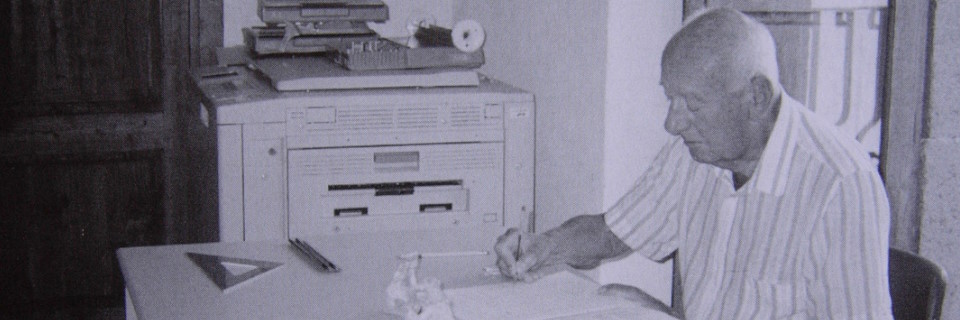
Through this module it is possible to surf the huge bibliography of Luigi Bernabò Brea. Searches can be made through the title of the publication, a keyword, or both together.
Meligunìs Lipàra
The series of volumes 'Meligunìs Lipàra', the first project of which dates back to at least 1960, comprises 12 volumes edited by Luigi Bernabò Brea and Madeleine Cavalier between 1960 and 2003. They constitute the complete and detailed publication of the discoveries that were made in the Aeolian Islands from 1946 to 2003, as well as the scarce previous evidence.
Of these monographs, two deal with the prehistory of Lipari (M.L. I and IV), three with the prehistory of Panarea, Filicudi and Salina (M.L. III, VI and VIII), and five are about the Greek and Roman necropolis in contrada Diana (M.L. II, V, VII, XI, XII). Finally, one volume concerns the topography of Lipari in the Greek and Roman age (M.L. IX) and one the discoveries made in the urban area of Lipari (M.L.X).
The last three volumes (M.L. X, XI and XII), which at the time of Luigi Bernabò Brea's death (1999) had been started but in various stages of elaboration, were completed and edited by Madeleine Cavalier.
- Meligunìs Lipàra I - La stazione preistorica della contrada Diana e la necropoli protostorica di Lipari, 1960.
- Meligunìs Lipàra II - La necropoli greca e romana nella contrada Diana, 1965.
- Meligunìs Lipàra III - Stazioni preistoriche delle isole Panarea, Salina e Stromboli, 1968.
- Meligunìs Lipàra IV - L’Acropoli di Lipari nella preistoria, 1980.
- Meligunìs Lipàra V - Scavi nella necropoli greca di Lipari, 1991.
- Meligunìs Lipàra VI - Filicudi. Insediamenti dell’età del Bronzo, 1991.
- Meligunìs Lipàra VII - Lipari. Contrada Diana. Scavo XXXVI in proprietà Zagami (1975-1984), 1994.
- Meligunìs Lipàra VIII - Parte I. Salina. Ricerche archeologiche (1989-1993); Parte II. Fonti per la storia dell'Arcipelago Eoliano in età greca, 1995.
- Meligunìs Lipàra IX - Topografia di Lipari in età greca e romana. Parte I. L'Acropoli. Parte II La città bassa, 1998.
- Meligunìs Lipàra X- Scoperte e scavi archeologici nell'area urbana e suburbana di Lipari, 2000.
- Meligunìs Lipàra XI - Gli scavi nella necropoli greca e romana di Lipari nell'area del terreno vescovile, 2001.
- Meligunìs Lipàra XII - Le iscrizioni lapidarie greche e latine delle isole Eolie, 2003.
Meligunìs Lipàra I
- L. Bernabò Brea, M. Cavalier - Meligunìs Lipàra I
La stazione preistorica della contrada Diana. La necropoli protostorica di Lipari, Palermo, 1960.
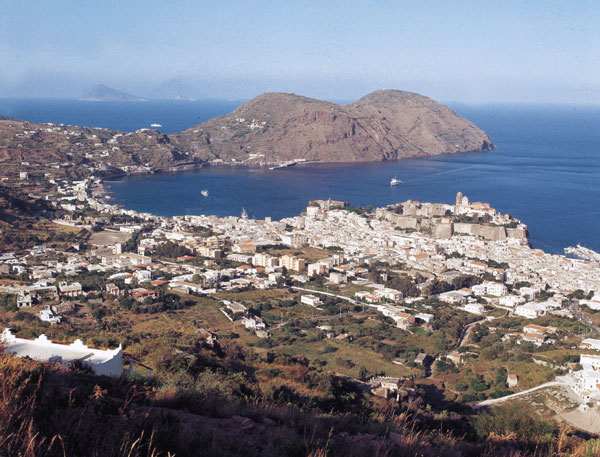
Lipari. The Contrada Diana seen from the sea
This volume marks the beginning of the publication of the archaeological excavations conducted by the Soprintendenza alle Antichità della Sicilia Orientale in the Aeolian Isles.
In the Neolithic period the prosperity of these islands depended on the exploitation of one of the raw materials then most in demand: obsidian, the natural volcanic glass with a very sharp cutting edge erupted by the volcanoes of Lipari. Obsidian could be shaped into effective cutting tools and was widely exported. The island grew rich on this trade and became populated with flourishing villages. These settlements included, towards the end of the Neolithic period, that of the Contrada Diana, which is described in the first part of this book.
Thanks to these discoveries, the Aeolian Neolithic is revealed as a very sophisticated civilization endowed with an advanced artistic sensibility, especially expressed in the elegant forms of vases and in the perfect smoothing of their monochrome surfaces.
With the spread of metal technology, the demand for obsidian declined and the Aeolian Isles felt the economic consequences of the changed conditions of life; this was a period of transition from the Neolithic to the age of metals. Renato Peroni says: "Meligunìs Lipàra I gives us in the first place a complete definition and a reliable classification of the Diana culture".
The second part of the book describes the tombs, with their rich grave goods of bronze, amber, glass paste and gold, of the Ausonian conquerors of the islands. They brought with them the rite of inhumation. This is an important contribution to our knowledge of the end of the Bronze Age in Italy, which Renato Peroni regards as a "great step forwards in our historical understanding of this period".
Meligunìs Lipàra II, V, VII, XI
- L. Bernabò Brea, M. Cavalier - Meligunìs Lipàra II
La necropoli greca e romana nella contrada Diana, con appendici di A.D. Trendall, T.B.L. Webster, e di M.T. Currò, Palermo 1965.
- L. Bernabò Brea, M. Cavalier - Meligunìs Lipàra V
Scavi nella necropoli greca di Lipari, Roma 1991.
- L. Bernabò Brea, M. Cavalier - Meligunìs Lipàra VII
Lipari Contrada Diana. Scavo XXXVI in proprietà Zagami (l975-1993) Palermo,1995.
- L. Bernabò Brea, M. Cavalier, F. Villard - Meligunìs Lipàra XI
Gli scavi nella necropoli greca e romana nell'area del Palazzo vescovile, in due volumi, Palermo 2001.

Lipari. Necropoli greca. Lo scavo XXXV 1974
These four volumes dedicated to Aeolian archaeology describe the finds from the Greek and Roman necropolis of Lipari whose excavations, directed by the authors, continued from 1948 to 1993.
Some 2500 grave assemblages, dating over a period of nine centuries, from the 6th century BC to the 3rd century AD, offer a comprehensive picture of the evolution of funerary rites, pottery forms, the styles of their decoration, the various types of figurative terracottas, bronze objects, gold jewellery and so on, over this long period.
In the field of pottery, imported wares from distant pottery-making centres in Greece itself, first Corinth in particular, later Athens (its pottery studied by François Villard), were succeeded in the course of the 4th century BC by wares from kilns in Magna Graecia (the Greek colonies in southern Italy), Sicily and Lipari itself. The pottery from Magna Graecia comprises large kraters (wine-mixing bowls with pedestals and handles under the rim) painted with figural decoration, often presenting rare mythological scenes or episodes from so-called Phlyax plays, outstanding among which are those attributable to the hand of the leading potter from Paestum, Asteas.
In the second half of the 4th century BC this local pottery production continued. It reached the highest point of its development in the early 3rd century BC with the accomplished products of a master whose name is unknown, but who is conventionally called the "Lipari Painter" and his pupils. An unusually vivid polychromy is often preserved in all its freshness on the vases of these masters.
In the field of terracotta sculpture the discovery of a huge number of small figured terracottas with theatrical motifs: miniature theatrical masks, tragic and comic, statuettes of the dramatis personae of satyr plays, of ancient comedy and satire, and of masks of the New Comedy (exemplified by Menander). Their production stretched from the mid-4th century BC to the destruction of Lipari by the Romans in 252-251 BC.
These terracottas represent as a whole not only one of the largest and most complete, but also one of the earliest, of the series of surviving monuments relating to the history of the Greek theatre. The archaeological finds show signs of decadence in the last years of the life of the city. They also attest to its weak revival after 252 BC, very far from its ancient splendours, but corroborated by various funerary assemblages that continued down to the Roman imperial period.
Finally, most of the inscriptions described in Meligunìs Lipàra XII can also be traced back to the Greek and Roman necropolis in contrada Diana.
Meligunìs Lipàra III
- L. Bernabò Brea, M. Cavalier - Meligunìs Lipàra III
Stazioni preistoriche delle isole Eolie Panarea, Salina, Stromboli, Palermo 1968.
PART I. Archaeological exploration of the islands of Panarea and Stromboli.
PART II. Palaeoethnological exploration of the island of Salina.
APPENDIX. Potter's signatures and marks on Aeolian Bronze Age pottery.

Panarea. Village on the promontory of Milazzese. Hut 1
The earliest evidence of human settlement so far found on the island of Panarea dates to the middle Neolithic period.
Significant evidence of the Upper Neolithic (second half of the 4th millennium BC) has been found at Calcara (lower level) and on the summit of the island (Piano Cardosi). The evidence consists in the main of pottery of the Diana style.
At Piano Quartara, a plateau above the beach of San Pietro, the traces of a small settlement of the final phase of the Aeneolithic (Copper Age) period (final centuries of the 3rd millennium BC) have been found. Tombs found in the area of Drauto (Panarea) and Malfa (Salina) can be dated, on the basis of correlations with equivalent finds on the Italian peninsula, to the beginning of the age of metal-working.
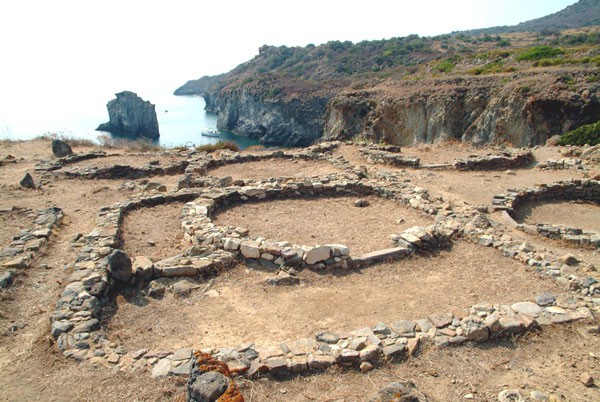
Panarea. Village on the promontory of Milazzese. Hut 8
The Capo Graziano culture (early Bronze Age, first half of the 2nd millennium BC) is represented at Panarea by a group of distinctive pits approximately 1 m in diameter uncovered overlying the Neolithic level on the southern margin of the fumarole basin of Calcara; perhaps votive offerings to a deity sacred to volcanoes or perhaps more probably a divinity of good health.
The prehistoric settlement on the promontory of Milazzese dates to the middle Bronze Age. A score of circular huts, save one which is rectangular, have been excavated here.
The characteristics of Aeolian material culture during this period can be defined on the basis of the pottery recovered from the site. The numerous fragments of Mycenaean pottery of styles IIIA and IIIB enable this village to be dated between the 15th and early 13th century BC.
Like all the other minor islands in the archipelago, Stromboli seems not to have been permanently settled until the Upper Neolithic. Pottery dating to the Upper Aeneolithic have been found scattered on the Timpone di Ginostra, above the existing settlement.
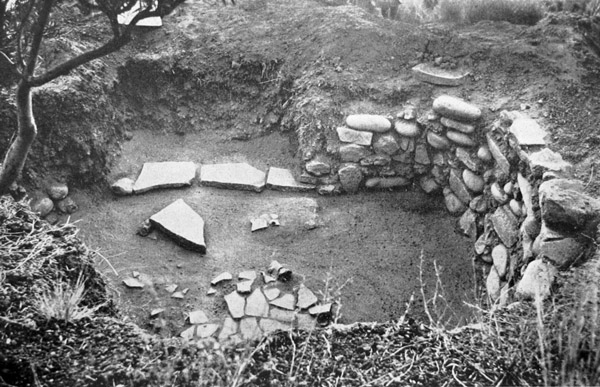
Salina. Village of La Portella. Hut H
At Salina the Capo Graziano culture is present at Serro dei Cianfi, a settlement only known from finds retrieved from a rubbish dump.
An important village of the Milazzese culture was brought to light at La Portella. The excavations have uncovered the foundations of ten or so huts built against the slope itself. As at Panarea, the violent destruction of the village has left evident traces, burying everything contained in the huts.
A catalogue of the potter’s marks found on Aeolian pottery of the Bronze Age follows. It has been extended to include similar potter’s marks found on pots excavated beyond the islands examined (Lipari, Filicudi and Milazzo).
Meligunìs Lipàra IV
- L. Bernabò Brea, M. Cavalier - Meligunìs Lipàra IV
L'Acropoli di Lipari nella preistoria, Palermo 1980, in tre volumi: testo; con appendici di L.W. Taylour, M. Garasanin, E, Contu, M. Alessio, F. Bella, C. Cortesi, B. Turi, J.L Williams, T. Mannoni; tavole e atlante
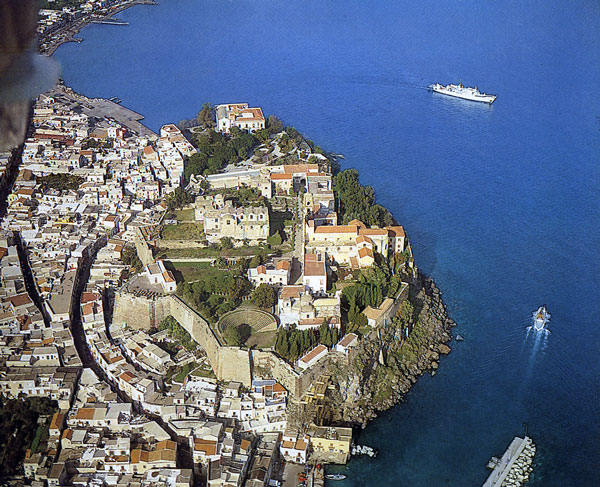
Aerial view of the Castello seen from the South with the circuit of Spanish walls dating to the 16th century
The very fruitful excavations on the Acropolis of Lipari have thrown a ray of vivid light on distant periods of prehistory and protohistory in the Western basin of the Mediterranean. They have revealed aspects of civilization so far barely glimpsed of the Neolithic, and of the whole of the Bronze Age, and documented very ancient relations with the Aegean world.
The earliest level of the settlement on the Acropolis is that of the Neolithic, attested by trichrome pottery. The settlement continued right to the end of the Bronze Age, with some significant pauses in the material evidence, though these can be integrated with artefacts from other areas of the island.
The phenomenon of discontinuity is already evident in the Neolithic: the settlement on the acropolis, documented by trichrome pottery, and that on the Serra d'Alto during a later phase, was abandoned for a period during the Upper Neolithic, only to return to the Acropolis right at the end of the Neolithic with signs of the first working of metal (slag from the casting of copper).
The following phase of Piano Conte is known from various settlement sites; it is a transitional period characterized by the import of Serraferlicchio wares from Sicily.
The phase of Piano Quartara represents another period of isolation that precedes the great flourishing of Capo Graziano culture in the early Bronze Age; relations with Sicily continued. The early Bronze Age is distinguished in two phases. In the first phase the settlements are situated in the plain, not far from the coast (Contrada Diana at Lipari, Piano del Porto at Filicudi).
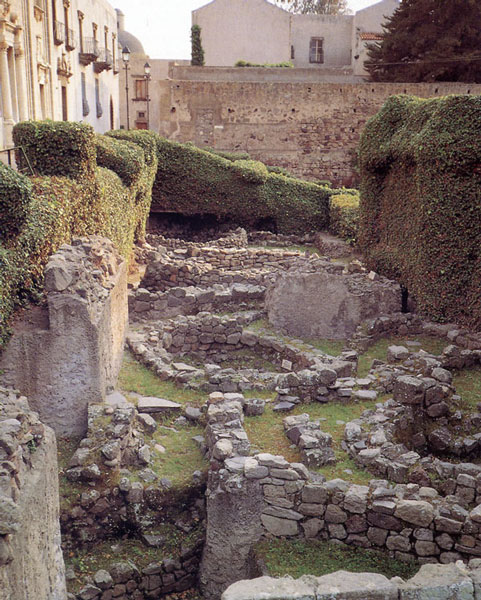
Lipari Castello. The southern zone of the excavations seen from the North
In a second phase the villages were removed to higher ground, clinging to naturally protected heights such as the Acropolis of Lipari and Capo Graziano at Filicudi.
It is in this second phase that intensive trading relations between the Aeolian Isles and the Aegean world began. These relations, with varying intensity, continued to the end of the prehistoric settlement, through the various phases of the middle, late and final Bronze Age which locally are respectively known as the Milazzese, Ausonio I and Ausonio II cultures.
The exploration of the Castello settlement on the acropolis of Lipari through all the villages that were superimposed over each other has so far been too limited in extension in relation to the whole area for us to be able to draw any definitive conclusions of an urbanistic character.
We must necessarily limit ourselves to partial observations. A score of huts belonging to the village of the Capo Graziano culture are oval, mainly elongated in form. They are rather small in size, and so would have provided rather cramped shelter to very small nuclear families.
Eighteen huts of the village of the Milazzese culture have been excavated. Almost all of them consist of a single room. Their stone-built walls have double facades and are remarkable for the precision of their structure; they are built of polygonal blocks in regular courses with a pronounced tendency to isodomy.
The architecture of Ausonio I is testified by the remains of a dozen huts, but only five of them are sufficiently well preserved to be able to identify their ground plan.
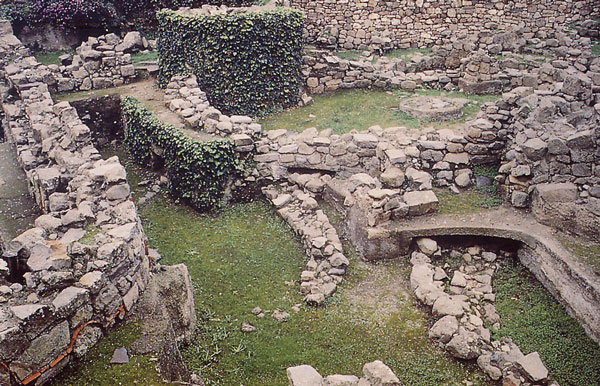
To the left a part of the large hut of Ausonio II, at the centre a hut of Ausonio I
There is great variety in the shape of the huts: huts that preserve the traditional type consist of a single oval room; others are rectangular in plan, one perhaps square with rounded corners.
Exemplifying Ausonio II we have a large monument which has survived sufficiently well to enable us to recognize not only its ground plan, but also the main characteristics of its superstructure.
Undoubtedly the architecture of this age represents a total change over the houses of the previous periods, an abandonment of all the former traditions and the introduction of new techniques extremely diverse in their origin.
The load-bearing structure must have been in timber. Pairs of vertical posts must have supported cross-beams on the long axis of the hut. The posts were firmly fixed in the ground and then encapsulated in a wall structure which would not have had any load-bearing function; it would have been an infill between the structural elements in timber.
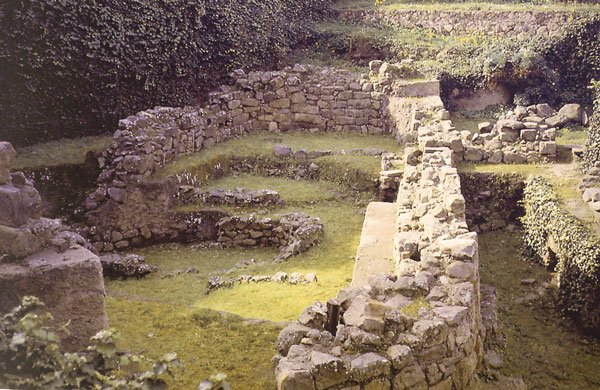
The large hut of Ausonio II
Some appendices complete the volume. The publication of the hoard of bronzes found buried in the earth below the floor of Hut Alfa II once again provides a measure of the island’s wide-ranging trade relations.
An examination of relations between the Balkans and the Appennines regions of Italy is provided by M. Garasanin. A study of Nuragic pottery is contributed by E. Contu.
Of particular interest is the study of J. Williams on the composition of Aeolian pottery, which demonstrates that in some cases this pottery was made with imported clays containing local aggregates. It is a measure of the specialization achieved in the making of pottery.
Meligunìs Lipàra VI
- L. Bernabò Brea, M. Cavalier - Meligunìs Lipàra VI
Filicudi, Insediamenti dell'età del bronzo. Appendici di R.M. Albanesi Procelli,
M.C. Martinelli, L. Vagnetti, P. Villari, J.L. Williams, Palermo 1991.
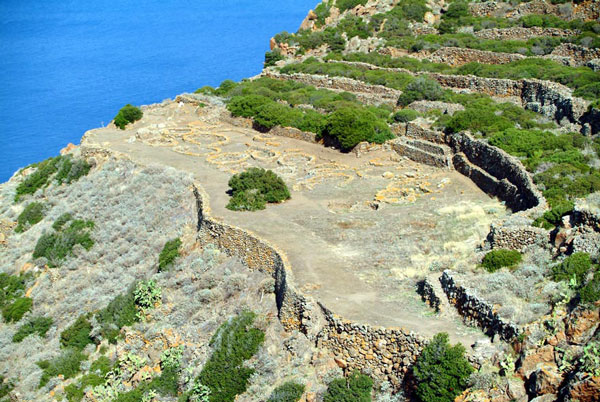
Aerial view of the village of Montagnola di Capo Graziano
By c.3000 BC the island of Filicudi must have had a stable population. This is demonstrated by the fragments of Diana style pottery found on the Montagnola di Capo Graziano and along the southern shoreline of the bay of Porto.
At the beginning of the Bronze Age, perhaps even before the third millennium, a large settlement arose on the island. Its inhabitants were undoubtedly newcomers, who had come from afar, and who settled here. We have recognized in them, we believe, the Aeolians of legend, whose name (derived from the Greek demigod of the winds Aeolus) the islands still bear.
This is a large village situated on the southern side of the Piano del Porto covering a longitudinal area of over 900 metres. The greatest density of huts is especially on the plain round the harbour (Piano del Porto).
Very limited excavations have been conducted near Filo di Lorani in the stretch called Filo Braccio.
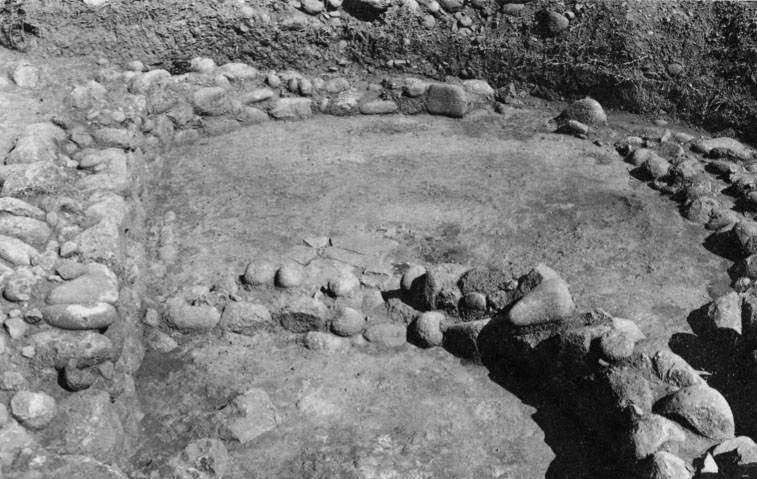
Filicudi Filo Braccio. Hut D
Two huts have been revealed, the one far larger than the other. They were built with pebbles from the Tyrrhenian beach. The foundations of these huts are laid over the remains of two older huts. The two huts were built beside them and in the interstice between them a group of little vases was found, perhaps a small votive pit.
The trench above the Lopez house revealed a well-preserved oval hut with walls built of pebbles from the fossil beach and clay.
The finding of these huts enables us clearly to define the pottery style of the initial phase of Aeolian culture in the early Bronze Age and to ascertain the resemblance of the ceramic forms to those of the cultures of the same period in continental Greece. They also provide us with a clue about the origin of the people to whom this culture is due.
Several centuries later, more precisely at the beginning of the second millennium BC, the settlement was transferred from the shoreline, impossible to defend, to higher ground: more precisely to the summit of the Montagnola di Capo Graziano overlooking the harbour. This site was a natural fortress, occupying a position that was far more suitable for defence.

The village of Montagnola seen from the South
The excavations have revealed the foundations of just under thirty huts on this site. They are closely packed together, testifying both to a numerous population and the restriction of the available space. They are oval huts built with local volcanic stone: irregularly fractured latitandesite.
Two periods, stratigraphically quite distinct can be recognized in the excavation of this settlement. The earlier of the two corresponds to the later more highly developed phases of the Capo Graziano culture successive to the transfer of the settlement. Only in the higher levels of the strata referable to the Capo Graziano culture do fragments of imported Aegean pottery begin to appear. These are wares corresponding to a meso-Helladic tradition prolonged in the Mycenaean period (i.e. late Helladic) or proto-Mycenaean painted pottery of styles I and II, which provide us with a very precise dating and enable us to recognize that the Capo Graziano culture continued to evolve right down to transition from Mycenaean style II to III, in other words down to c.1430.
The level of the Capo Graziano culture is superimposed by those of the Milazzese culture, characterized by a wholly different pottery repertoire, Sicilian in origin and type.
In the levels of the first phase of this new culture are also found fragments of imported Aegean pottery, now in the Mycenaean style III A1, dating to the late 15th and early 14th century BC.
The settlement of the Milazzese period, like all the other contemporary settlements in the Aeolian Isles, ended with a violent destruction, datable to the first decades of the 13th century BC.
Part III of the volume describes the burial site in natural ravines on the slopes of Montagnola di Capo Graziano.
They are tombs of artificial rock-cut (groticella or “oven”) type, copying the type of tomb excavated in the rock used in Sicily since Neolithic times. Tombs of this type, used for collective burials, were widespread not only in Sicily but also in the Italian peninsula during the same period.
The hardness of the rock precluded the hewing into it of regular burial chambers, and so attempts were made to adapt as best as possible to the same function whatever nature itself offered that was most similar.
The grave goods consist of little vases; their type shows they belonged to a rather early phase of the Capo Graziano culture.
Meligunìs Lipàra VIII
- L. Bernabò Brea, M. Cavalier - Meligunìs Lipàra VIII
Parte I Salina. Ricerche archeologiche (1989-1993), con appendici di J.L. Williams e S. Levi, M.C. Martinelli. pp. 1-190; Parte II di A. Pagliara, Fonti per la storia dell'arcipelago Eoliano in età greca, pp.1-129. Palermo 1995

The Neolithic hut of Rinicedda
A large section of Meligunìs Lipàra Vol. III had been dedicated to the excavations conducted on the island of Salina in 1956, in the Bronze Age settlements of Serro dei Cianfi and La Portella.
For many years after these excavations, no significant finds, especially for the prehistoric period, were made in the island.
A strong revival of interest in the archaeology of the island has however taken place in recent years. It was prompted by a series of striking discoveries, following which new excavations were undertaken.
A stable settlement of people coming from Sicily had developed on the island of Salina since the onset of the middle Neolithic, contemporaneously with the first settlements of Castellaro Vecchio on the island of Lipari, in the final centuries of the fifth millennium BC.
The excavations conducted in 1989 revealed an oval hut recognizable in the excavation only due to the different compactness of the terrain. It was possible to identify its beaten earth floor on which were embedded shattered vases, fragments of obsidian, stone tablets, and so on.
An accumulation of stones right round the upper margin of its perimeter was undoubtedly all that remains of the straw roof that covered the hut. It is a very primitive type of habitation, of a kind known in southern Italy, but hitherto never found in Sicily and the Aeolian Isles.
Another settlement, somewhat later in date, was subsequently discovered (1990) on Serro Brigadiere, a crag on top of which the settlement of Santa Marina Salina is perched.
A group of huts was revealed by the excavation. They too are very primitive in type, dug into the ground and abutting onto a ridge of compact grey tufa. They were simple elongated pits with rounded corners, with floors of beaten earth. Sometimes their perimeter was completed by a scattering or row of broken stones which surrounded the upper edge of the pit; these stones undoubtedly formed part of the roofing of the huts.
These huts belonged to the Piano Quartara cultural phase (second half of the third millennium).
The pottery found on the site attests to the fact that this area was inhabited from the initial Aeneolithic or Copper Age (first half of the third millennium BC) and from the middle Aeneolithic (pottery of Piano Conte style, round about the middle of the third millennium).
The settlement continued until the following Capo Graziano cultural phase (onset of the Bronze Age).
At a slightly lower level a hut of the middle Bronze Age was built into the slope of the hill (Milazzese culture, 14th century BC).
A settlement of wooden huts on the steep ridge of the contrada, close to the Neolithic hut of Rinicedda, can be dated to the Capo Graziano cultural phase.
The second part of the volume is dedicated to the sources for the history of the Aeolian archipelago in the Greek period.
Meligunìs Lipàra IX
- L. Bernabò Brea, M. Cavalier, F. Villard - Meligunìs Lipàra IX
Topografia di Lipari in età greca e romana. Parte I. L'Acropoli, Parte II. La città bassa con appendici di M.A. Mastelloni, E. Messina, G. ANCONA, A. Ollà', L. Campagna, U. Spigo (con la collaborazione di F. Famularo). Palermo 1998
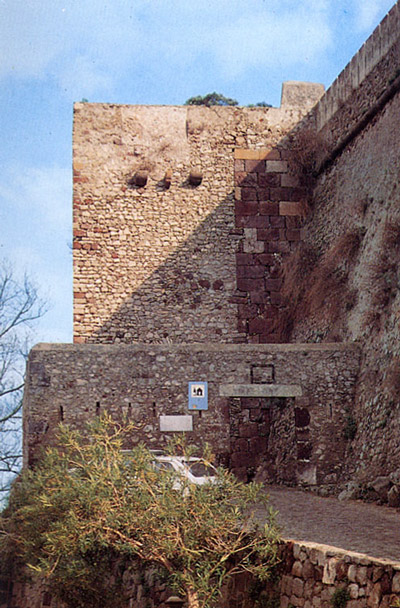
The tower of the Greek fortifications of the 4th century BC incorporated to the left into the gateway tower of the Roman period, to the right into the Spanish walls of the 16th century AD
Part I
The vestiges of Greek Lipari that have been conserved and that came to light during the excavations are meagre.
The Cnidians and Rhodians who re-founded the city in 580 BC undoubtedly established themselves on the acropolis surrounded right round by very high cliffs, which were eminently suitable for defending the site from the incursions of Tyrrhenian pirates. But of this period nothing was found other than a few votive pits (bothroi), especially the largest and finest of them in the sanctuary of Aeolus.
The area of the acropolis must soon have revealed itself as insufficient and so the city spread to La Civita. It expanded down from the slopes of the acropolis to the plain and towards the harbour of Marina Corta.
In the 4th century BC the fortifications of the acropolis, which now formed a fortress within the city, seem to have been reinforced, at least on the only side on which it was possible to gain access to it, i.e. on the side towards La Civita. For here we find incorporated into the later fortifications of the 13th and 16th century AD the remains of a Greek tower presenting no less than twenty-three courses of ashlared blocks, very similar in structure to that of the walls of Diana.
The Romans, after their conquest and destruction of Lipari (252-251 BC), transformed the acropolis into a fortress, probably razing all the previous buildings to the ground. Only a century later, once the political situation in the lower Tyrrhenian had changed, and once the Aeolian Isles had lost all their strategic value, did the acropolis once again resume its role as a residential centre.
The excavations conducted on the acropolis have revealed evidence of a regular town plan (“per strigas”), of which we can reconstruct at least the essential lines for the part that remains. Even if some parts still remain to be determined.
A wider main street (decumanus) began from the only entrance to the acropolis, situated on the North side (and exactly corresponding with the existing entrance). It ran in a straight line along the North-South axis throughout the length of the citadel, i.e. for over two hundred metres. This street was intersected, not precisely orthogonally, but with a slight obliquity, at regular intervals of a hundred feet (32.50 m), by minor streets (cardines) roughly ten feet in width (c. 2.80 m).
The decumanus proceeded along a slightly uphill gradient in the first stretch of some eighty metres, corresponding to insulae I-III, and then levelled out in the following stretch of c. 100 metres, corresponding to insulae IV-VI. We don’t know how it ended to the far South, now profoundly changed in its topography.
A circumvallation, or surrounding road, must also have run round the margins of the rock.
The individual houses were reconstructed, often more than once, over the centuries of the Republican and Imperial periods.
Part II
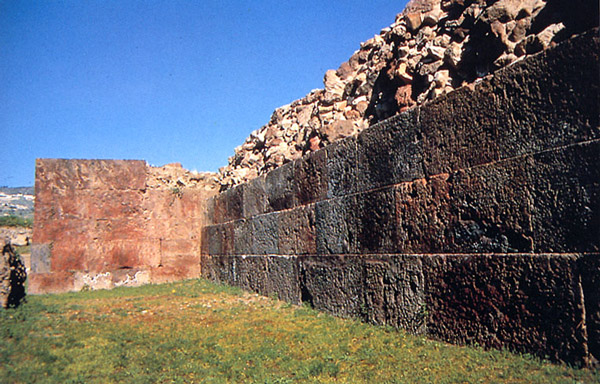
The Greek walls of the first half of the 4th century BC
In c. 500 BC the lower city – the city at the foot of the acropolis – was surrounded by robust fortified walls in polygonal masonry, a stretch of which was discovered in what is now the Piazza Monfalcone in 1954.
Roughly a century later, in the early years of the 4th century BC, the city, whose population had considerably increased, spread to the margins of the plain; towards the West, it spread beyond the periphery of the urban centre of present-day Lipari.
A new and impressive circuit of walls was then constructed. It defended the city with a rectilinear curtain, blocking it off from the Ponte torrent to the South to the Santa Lucia torrent to the North. It must then have followed the course of these torrents to the sea, i.e. respectively to the beaches of Marina Corta and Marina Lunga.
Some fifty metres of this wall has been uncovered. Its superstructure was c. 3.75 m thick. It was faced (both on the outside and inside) with ashlared blocks of Monte Rosa stone in isodomic courses. Square towers would have protected the main gates leading into the city.
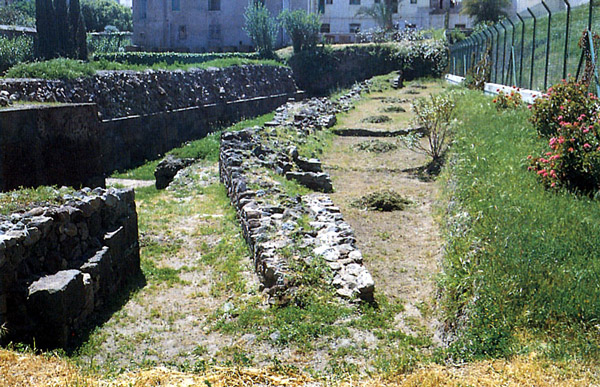
The ramparts erected during the civil war between Sextus Pompeius and Octavian
The Aeolian Isles resumed their great strategic importance at the time of the civil war between Octavian, who dominated mainland Italy at this time, and Sextus Pompeius (son of Pompey the Great), who was master of Sicily. During this conflict the ancient Greek walls, which had in large part been destroyed and had largely been buried below alluvial and wind-blown deposits, were reinforced by a new system of fortification: a rampart crudely built in great haste with unmortared rubble and sometimes with reused blocks.
The Roman city never extended beyond the limit marked by the ancient Greek walls and by the new rampart, though with the exception of one or two isolated buildings.
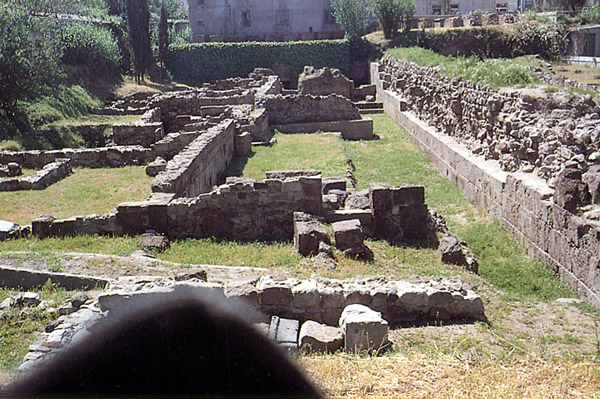
The Roman city of the 2nd century AD
Within the circuit of walls the excavations brought to light remains of houses successively reconstructed between the 2nd and 1st century BC and the 4th century AD. But none of the houses could be excavated in its entirety because buried below existing buildings.
The excavations found traces of two parallel streets (cardines) dividing the various insulae. The pronounced raising of the ground level over the centuries was also observed, so that rooms that had been built on the ground floor became, at the end of this long period, semi-interred.
A wide street of circumvallation (pomerium) remained free of buildings until the end of the 2nd century AD, but later this too was built over.
Meligunìs Lipàra X
- L. Bernabò Brea, M. Cavalier - Meligunìs Lipàra X
Scoperte e scavi archeologici nell'area urbana e suburbana di Lipari, Palermo, 2000.
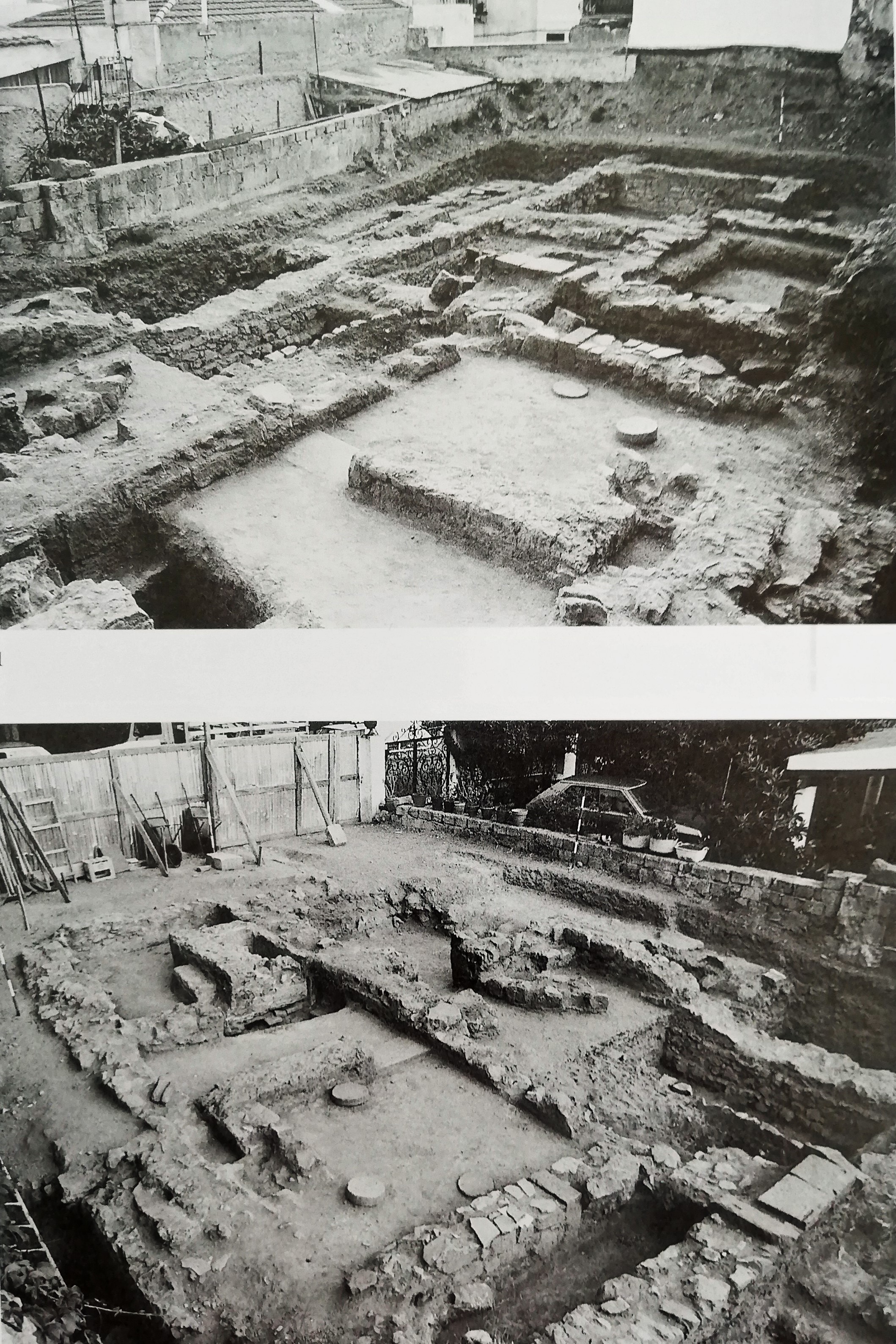
Roman thermal baths unearthed in the urban area of Lipari
This volume brings together the reports on four different excavations conducted in the urban and suburban area of Lipari at different times and in different sites, without any relation between them.
The first, that of the suburban sanctuary, perhaps a Koreion (shrine for the worship of Kore), and remains of a rustic arena superimposed over it in the Roman period, is an old excavation dating to the years 1955-56, of which some preliminary information has been presented on various occasions, but which is now published in complete and systematic form.
This was probably a sanctuary sacred to the Eleusinian deities (Demeter and Kore). They were at once goddesses of the harvests and of the infernal regions, whose rites were celebrated in spring, at the time of the reawakening of nature, and after the harvesting, i.e. at the end of the agricultural cycle, when Kore (or Persephone), once her beneficent gifts to mankind had ended, celebrated her sacred nuptials with Hades and began with him her reign in the underworld.
The other three are more recent excavations conducted in the 1990s following discoveries made during building work in the urban area: (a) Corso Vittorio Emanuele, (b) Via Franza, and in the suburban area (c) Contrada Portinenti.
- The excavations (1995-1996) revealed the edge of a Roman insula and the streets that delimited it in the context of the topography of the urban centre in the Roman imperial period
- Excavations (1993-1996) of a Late Roman building complex on the Via Franza
- Excavations of waste dumps of a Roman kiln (1993-1995) and of Greek burial sites in Contrada Portinenti (1981 and 1993-95)
Precisely because these were different and unrelated excavations, which gave rise to different problems, each of the four reports is presented as a self-contained monographic study.
Two of these reports are followed by particular studies:
- A. Sardella and M.G. Vanaria: Le terracotte figurate di soggetto teatrale del santuario dell'ex proprietà Maggiore di Lipari. Ph. Borgard: L'atelier de potier du vallon de Portinenti. A. De Filippis and L.M. Rendina: Ceramica di uso comune della discarica.
- G. Acona, E. Messina: Altri tipi di anfore nella discarica.
- M. Denaro: Vasi punici dalla necropoli greca di Portinenti.
- L. Campagna: Le anfore della necropoli in contrada Portinenti.
Meligunìs Lipàra XII
- L. Bernabò Brea, M. Cavalier, L. Campagna - Meligunìs Lipàra XII
Le iscrizioni lapidarie greche e latine delle isole Eolie. Con la collaborazione di
F. Famularo. Palermo 2003
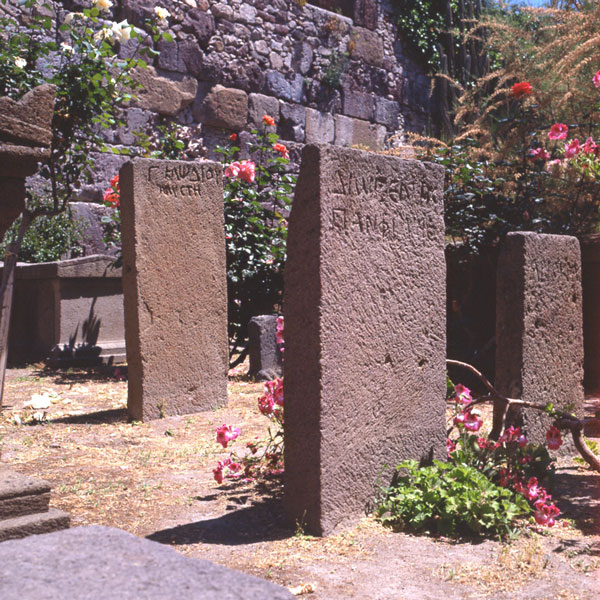
Tomb 913
This volume consists of the collection and comprehensive study of the stone inscriptions found in the Aeolian Isles from 1948 – when systematic archaeological excavations began – down to 2003.
Also comprised in the study are the funerary semàta previously and casually discovered, those found during the excavation conducted by Paolo Orsi in 1928 and those belonging to private collections and subsequently donated, with generosity and intelligence, to the Museum.
But the majority of the inscriptions come from the excavations conducted by the Soprintendenza in the great burial sites of Contrada Diana.
During these excavations many inscriptions were found sporadically in the ground or discarded in piles of rubble without any reference to the tombs that were gradually being discovered in the underlying strata. Evidently the inscriptions in this case were debris from the construction of the tombs themselves.
An even larger number of inscriptions were found reused in Roman tombs generally of the Augustan or Julio-Claudian period; in other words they were found reused in rough-built tombs built of masonry or in coarsely hewn sarcophagi sometimes completed by reused stelai; stelai or rather fragments of them were often placed in this period as a support for the tiles in tile-covered burials (tombe a cappuccina).
The reuse of ancient funerary stelai continued down to the Roman imperial period.
More rarely, in very particular cases (excavation XXIII, 1955 and 1985) the funerary semàta were found still in situ above the tombs to which they belonged and have given us the name of the deceased.
La Sicilia prima dei Greci
- L. Bernabò Brea - La Sicilia prima dei Greci
2° ed. Milano 1958.
Luigi Bernabò Brea dedicated this volume to archaeological exploration in Sicily, particularly intensive as regards the prehistoric period, i.e. the ancient civilizations that flourished in the Island before the Greek colonization.
To this are added the results of previous discoveries that had not yet been published, or had originally appeared in publications not always accessible to a larger public.
From this derives the high interest of this book (Sicily Before the Greeks) published in London in 1957 in the series "Ancient Peoples and Places" under the General Editorship of Glyn Daniel of the University of Cambridge (in English and German editions), and first published in Italian in 1958 in the series "Il Saggiatore".
This volume for the first time examines and sums up an enormous quantity of data, in part recently acquired and never before used in a general synthesis. It examines, one by one, or poses for the first time, the many complex problems of Sicilian prehistory, offering solutions that, in originality of views and the scale of the cultural context in which they are set, were destined to represent in this field a stage of fundamental importance and one that scholars still to this day cannot ignore.
The number of prehistoric sites covered by the book had in the meantime considerably increased, if we compare it with the one with which Paolo Orsi, "the great pioneer of Sicilian prehistory", concluded his half century of excavations and research. Alongside by now classic sites of Sicilian prehistory, other new ones now appear, such as the Cala dei Genovesi at Levanzo, Capo Graziano and Milazzese in the Aeolian Isles, the cave of Chiusazza in the province of Syracuse, Serraferlicchio in that of Agrigento, and so on: sites that were destined, in turn, to become famous. At the same time, the table of periods and cultural phases becomes far richer and more refined in its articulation.
Moreover, following the stratigraphic excavation of the Acropolis of Lipari and that of other sites, the serious gap in the evidence that made it almost impossible to provide a reliable chronology of the various “cultures” could finally be filled. Connections with the chronology of the Aegean area and continental Greece also permitted an absolute chronology of a precision that was hitherto unthinkable.
By a dense and continuous network of significant cross-references, Sicilian prehistory could thus be incorporated in the general framework of the prehistory of the Mediterranean basin as a whole. This ensured that Sicily, even in these remote periods of prehistory, could emerge as one of the most important crossroads of history: the meeting point, and in some periods the theatre of conflict or clash, between great cultural and expansionary movements coming from the East, the West and also from Central Europe through the Italian peninsula, as would also happen later in the island’s history.
Poliochni, città preistorica
nell'isola di Lemnos
- L. Bernabò Brea - Poliochni, città preistorica nell'isola di Lemnos
Monografie della Scuola Archeologica di Atene e delle Missioni italiane in Oriente, volume I: testo e tavole, Roma, 1964.
- L. Bernabò Brea - Poliochni, città preistorica nell'isola di Lemnos
Monografie della Scuola Archeologica di Atene e delle Missioni italiane in Oriente, volume II: testo e tavole, Roma 1976.
The prehistoric city of Poliochni is situated on the seafront, in the small bay of Vròskopo on the East coast of the island of Lemnos, close to present-day Kaminia.
Discovered by the Scuola Archeologica Italiana in Athens in 1930, excavations of the site were conducted down to 1936 by pupils under the direction of A. Della Seta and then in a renewed campaign from 1951.
The excavations have so far uncovered over half of the surface of the hill that represents a real tell, an artificial mound formed by the gradual accumulation and superimposition of archaeological remains reaching a depth of over nine metres. Exploration of the site has permitted the main lines of the urban topography to be identified, and its historical development to be traced through the early Bronze Age; the more recent strata (middle and late Bronze Age) had unfortunately been almost completely removed by erosion.
From a cultural point of view Poliochni is closely connected with Troy, far more so than with the great prehistoric site of Thermi on Lesbos. Yet, in the phases corresponding to Troy I and II, Poliochni was a good deal more extensive that Troy itself and not inferior to it in civilization and wealth.
Poliochni thus forms part of the extremely precocious Anatolian Bronze Age that probably lies at the origin of the European Bronze Age as a whole. It also maintained contacts with the Cyclades and with mainland Greece in the Helladic period.
Founded in a slightly earlier period that Troy, as a village of oval huts (Poliochni I, black), several times reconstructed (the excavations of 1933 and 1956 revealed no less than seven different strata of huts), the settlement was soon transformed into a real urban centre with houses of mégaron type, and with a large circuit of walls incorporating large warehouses, perhaps public granaries (Poliochni II, blue = initial phases of Troy I).
Whereas in period I metal in never attested, in period II it was already being worked with complex techniques such as cire perdue.
The most characteristic form among the glossy black impasto pottery is the tall pedestalled fruit-bowl.
The subsequent development of the site can be followed both through the many reconstructions of buildings and through changes in the types of pottery determined by the intensification of relations with the Cyclades and with the Proto-Helladic.
During Poliochni III, green (= middle phases of Troy I) and Poliochni IV, red (= end of Troy I and beginning of II) the city spread further with new quarters on the western slope of the hill and with the construction of a new and larger circuit of walls to enclose them.
A bronze hoard found in the ruins of a large mégaron-type house with many rooms dates to the end of Poliochni IV. The hoard comprised flat and conical axes, lances, daggers, awls, etc.
Volume II is devoted to Poliochni V, yellow (= late phase of Troy II) which is the best known phase in the city’s prehistory, because to it belongs the stratum that now forms the surface of the whole summit of the hill.
It presents a succession of large houses with central mégaron flanked by many rooms and facing on the south side onto a paved courtyard, aligned with the roadside of a wide principal thoroughfare which traverses the whole city longitudinally in the North-South direction, linking together two large squares, each furnished with a public well; the street then turns westward and leads out of the city into the countryside.
The individual insulae in the urban fabric are separated by narrow twisting alleyways.
Poliochni V was undoubtedly destroyed by an earthquake, perhaps the same that caused the destruction of Troy II g.
A rich hoard of gold jewellery found by Bernabò Brea in 1953 comes from the destruction layer, together with large amounts of pottery. It is a treasure second only to the Great Treasure of Troy.
No trace remains of the phases corresponding to Troy III and IV, but a small strip of deposit belonging to Troy V was discovered. Only the fill in one of the wells attests to the continuation of life in the city down to the threshold of Mycenaean civilization (16th century BC).
Il Castello di Lipari e
il Museo Archeologico Eoliano
- L. Bernabò Brea, M. Cavalier - Il Castello di Lipari e il Museo Archeologico Eoliano
Palermo 1977, pp. 214.
This small volume gives a summary but precise account of the events of which the Aeolian archipelago was the theatre from prehistory to recent times. It describes the archaeological zone of the Castello of Lipari. This naturally fortified height was inhabited since the Neolithic period. It has yielded a very important stratigraphy, especially for the sequences of prehistoric cultures. It has thus become an essential reference point for the whole of prehistory in the Western Mediterranean.
The cultural sequence of the archipelago is outlined in the pages dedicated to the Aeolian Museum, from the earliest settlements of the middle Neolithic down to the Ausonia culture in the late and final Bronze Age.
The destruction of the village of Ausonio II in c. 850 BC marks a period of abandonment of the archipelago which lasted until the start of the 6th century BC, when the Cnidian colony of Lipàra was founded.
The author then turns to the historical and archaeological testimonies of Greek and Roman Lipari through the necropolis and the Roman city of the Contrada Diana.
Of great interest are the pottery of the 4th century BC and the existence of two local pottery schools: that associated with the theatrical terracottas beginning in the late 4th century BC and that of the polychrome pottery of the Painter of Lipari and his pupils (3rd century BC).
Two chapters are dedicated to the prehistory and protohistory of Milazzo, closely linked to that of the Aeolian Isles, and to underwater archaeology particularly rich in testimonies ever since the early phases of the Capo Graziano culture (ancient bronze).
A copious bibliography and numerous plates at the end of the book complete this book which presents scholars and students with a useful synthesis of Aeolian archaeology from prehistoric to classical times.
Maschere e Personaggi del teatro
greco nelle terracotte liparesi
- L. Bernabò Brea - Maschere e Personaggi del teatro greco nelle terracotte liparesi
Roma 2001. Con la collaborazione di M. Cavalier.
This volume is devoted to an exceptional terracotta complex consisting of statuettes and masks in large part found in grave goods, but also recovered from votive deposits in the Greek necropolis of Lipari during the excavations conducted over a period of half a century.
More than a thousand finds of this kind were recovered. They are attributable to a period comprised between the late 5th and mid 3rd century BC, with a particular concentration in the 4th century, when particularly flourishing and highly accomplished pottery workshops were active in Lipari, dedicated to the production of figure-painted vases and terracottas.
This extremely interesting series of objects, reproducing actors or miniature masks, enables us to gain insights into the theatrical world of Antiquity. It throws light on stage costumes and characteristics of the Greek theatre at the time of the great tragedians associated with the New Comedy of Menander.
The theatrical mask developed in relation to the introduction into the Greek world of three types of theatrical performance, tragedy, satirical drama and comedy. It gave rise to various types, reflecting the various types of theatre; these are well exemplified in the terracottas of Lipari.
Very little is in fact known of the development of the masks used in the representation of tragedies in the time of Aeschylus and Euripides. Equally rare are contemporary artefacts illustrating stage costumes during this period. So a fragment of a statuette from Lipari dating to the last quarter of the 5th century BC is of particular interest.
We are very familiar, on the other hand, with the famous dramatis personae of the tragedies of Sophocles and Euripides and those that belong to tragedies which have been lost but whose subject is known to us.
The original masks, which the models of Lipari replicate in miniature, must have reproduced the types devised by tragedians themselves; these were handed down to posterity and maintained their fundamental character unaltered through the centuries.
It is more difficult to identify the personages represented by ancient comedy, with the exception of comedies of a mythological character in which mythical heroes and deities are caricatured.
Since no text has survived of the comedy that developed between the age of Aristophanes and that of Menander, so-called ‘Middle Comedy’, a group of comic statuettes from Lipari datable to the second half of the 4th century BC is particularly precious: they mark the transition from the Aristophanic tradition to the ‘New Comedy’.
Alongside male figures in phallic costumes with big bellies and prominent backsides, figures of slaves and courtesans, less buffoon-like in character, gradually came to the fore; they dominated the later comedy.
They belong to a type of comedy we could define as middleclass (characterized by a more realistic depiction of everyday life).
Theatrical masks underwent typecasting and standardization; they were reduced to some basic types, well characterized and clearly differentiated from each other, which would remain in use till the Roman period.
The terracotta models from Lipari present some forty different types, in which it is possible to identify the various personages described in the catalogue of Pollux (2nd century AD), ranging from the benevolent old man to the vainglorious soldier, from the beautiful courtesan to the double-dealing procurer, from the irascible servant to the elderly wet nurse.
The huge repertoire of such terracotta statuettes and masks gathered during the excavations conducted from 1978 onwards was published in the volume published in 2001. These excavations further permitted a precise dating of the material thanks to the associations of funerary assemblages. On this basis it was possible to reconstruct in more detail the development of terracotta sculpture in the workshops of Lipari.
An exhibition with the title “From Aeschylus to Menander. Two centuries of Greek theatre through archaeological finds from Lipari” was held in Lipari, in the church of Santa Marina delle Grazie in August-October 1987 thanks to the Assessorato ai Beni Culturali of Sicily. Its aim was to familiarise the public with the world of Greek theatre, not through the reading of the texts of ancient Greek tragedies and comedies, but through the material testimonies offered by the rich repertoire of terracotta statuettes and masks yielded by the necropolis of the Greek classical and Hellenistic period in Lipari.
La ceramica figurata della
Sicilia e della Magna Grecia
nella Lipàra del IV sec. a.C.
- L. Bernabò Brea - Maschere e Personaggi del teatro greco nelle terracotte liparesi
Muggiò Milano, 1997, pp. 1-189, figg. 1-218. (con riassunto in inglese)
This volume is devoted to the entire complex of figured pottery of the 4th century BC recovered by the excavations of the Greek necropolis of Lipari (1948 to today), and similar pottery coming from previous excavations conducted in Lipari in the 19th century, now in the museums of Cefalù and Glasgow.
It presents, in other words, almost the totality of material found in the necropolis of the ancient city which has survived virtually intact; it has escaped the wholescale plunder and tomb-robbing that has devastated all the Greek cemeteries of Sicily and Magna Graecia for centuries.
This is due to a unique geological phenomenon deriving from the action of wind that has determined the thick deposits of earth laid over it, thanks to which the necropolis has been protected through the ages.
These excavations have led to the discovery of a large quantity of artefacts which are intrinsically of great art-historical importance. But they have more especially permitted a long series of observations to be made about the organization of the necropolis: its progressive development, its funerary rites and funerary customs, its types of tombs and their development over time, also in relation to the socio-economic conditions of the city in the various periods and in relation to the religious ideas and beliefs about the afterlife that were diffused in the Greek world of the West.
The volume dedicated to A. D. Trendall faithfully follows his classifications and his attributions to the individual painters or stylistic groups.
The classifications proposed by Trendall thus constitute the basis for any subsequent research, including the work presented here. Nonetheless, the association of artefacts in the grave assemblages or also in the many votive deposits found in the area of the necropolis sometimes suggest different chronologies. This goes for the period of activity of Campanian masters, such as the Mad Man Painter and the NYN Painter who seem to belong not to the first but to the second half of the 4th century.
La ceramica policroma liparese
di età ellenistica
- L. Bernabò Brea, M. Cavalier - La ceramica policroma liparese di età ellenistica
Muggiò Milano, 1986, pp. 1-111, figg. 1-109.
The aim of this monograph is to trace the development of the figured pottery produced at Lipari between the beginning of the Hellenistic period and the terrible destruction of 252-251 BC, which, with its barbarous massacres to which Paulus Orosius refers, marks the end of all the traditional arts and crafts in the city.
It cannot be excluded that some production of figured potters had taken place in Lipari even earlier, from the mid-4th century onwards, or even earlier, but only the local workshop of the Cefalù Painter, in the last decades of the 4th century BC, seems well documented today.
In actual fact this master, though he strongly felt the influence of the new decorative style, the so-called Gnathian style, which was then developing, was still working in the “red figure” technique. But ever more clearly he appears to us as the initiator of the local school of pottery production that, in the following generation, with the Lipari Painter, would introduce full polychromy into vase decoration.
This local school of pottery flourished in a period in which the production of figured pottery had ceased or was at least on the verge of extinction in most other pottery-producing centres in Sicily and Magna Graecia.
Some fairly precise data on the development of polychrome pottery in the first half of the 3rd century BC is given to us by Menander with the masks of his comedies and even more so by his own portrait, of which we have numerous terracotta exemplars associated with fragments of painted vases in votive pits or rubbish dumps within the area of the necropolis.
Thanks to the Lipari Painter and his school, Lipari now seems to us the greatest centre for the production of polychrome pottery in the first half of the 3rd century BC. Perhaps it was the very centre in which this technique was created and perfected.
Menandro e il teatro greco
nelle terracotte liparesi
- L. Bernabò Brea - Menandro e il teatro greco nelle terracotte liparesi
Genova, 1981, pp.1-340, figg. 1-475.
This magnificent volume, essential for studies on the Greek theatre, has passed unperceived, no doubt due to its restricted distribution. The fact remains, however, that after the publication of A. D. Trendall and T.B.L. Webster, Illustrations of Greek Drama (London 1972), it is undoubtedly the richest and the most up to date on the subject. The author Luigi Bernabò Brea, together with Madeleine Cavalier, has worked for over thirty years on the excavations of Lipari and their divulgation (creation of a museum, publications etc.) and gives us here a summary of the contribution of Lipari to the history of Greek theatre. Pending a solution to the mystery of the reasons and modes of so vital a presence of theatre in Lipari in the 4th century BC, the author presents an ensemble of artefacts utterly unique in their number and quality. Contrary to what the title of the book might lead one to think, it is not just about the theatre of Menander, but the whole classical repertoire of drama that seems to have been performed and illustrated in Lipari as much as in Athens itself.
Greek tragedy was first present in a series of painted vases which have enabled us, as for other genres, to identify the terracotta masks (see in particular appendix III). The new tragedies of the 4th century BC of which only fragments have been preserved are difficult to identity. On the other hand, as we know from inscriptions, the dramas of Euripides and those of Sophocles were very often revived in the 4th century not only in Athens, but also in other regions of the Greek world and especially at Lipari. L. Bernabò Brea has been able to give to several of their tragic heroes the precise features of masks found at Lipari (cf. p. 313, Philoctetes, Paris, etc.).
The satirical drama is equally well represented. But it is comedy that is undoubtedly best described. This genre was almost a form of popular theatre in Southern Italy, the so-called ‘Phylax’ farces. Nonetheless it was the types of ancient comedy of Aristophanic type that L. Bernabò Brea identified in a remarkable series of masks and statuettes.
The majority of artefacts, masks and terracottas found in Lipari, however, presumably represent the genre of ancient theatre known as the ‘New Comedy’.
The author has been able to reconstruct the series catalogued by Pollux in his Onomasticon. But all these artefacts predate 251-250, the date of the destruction of the island by the Romans. Moreover, the presence of portrait masks of Menander in this series demonstrates the role played by this author in the creation of these new new types of masks which it was thought had been fixed far later. The originality of the masks of Lipari relating to the nea consists of their number illustrating the same types in several exemplars, their technical quality, and their rich polychromy. The presence of variants within the same series reveals that that it was decidedly an art in full creation, i.e. that it was not something fixed or ossified as it would subsequently become, for example in the mosaics of Mytilène in the 3rd century AD.
The questions that one might pose in response to this ensemble of material are far from having been answered. It is curious for example that the remains of a large theatrical building have not yet been found on the island. The identifications made by the author concerning in particular the masks of tragedy might perhaps be found surprising. The well-to-do clientèle of Lipari did not hesitate to order de luxe vases from Greece or Southern Italy. But most of the pieces presented in the book, especially those of terracotta, seem to be products of a local atelier.
The spread of theatre in the Greek world is a well known fact. But such an obsessive presence of the theatre in Lipari has something astonishing about it. It seems that here, more than elsewhere, the passion for theatre was bound up with reasons of a religious and funerary order since almost all the objects were discovered in tombs.
The masks of Lipari undoubtedly have not yet revealed all their mysteries. Experts of the theatre in the ancient world will therefore have in the present volume a document of major importance. But the enlightened amateur, curious about masks or simply “antiquarian” in mind, will also rejoice to have it in his library.
(Paulette GHIRON-BISTAGNE Transe et Théâtre, Cahiers du Groupe interdisciplinaire du théâtre antique, Université P. Valéry, Montpellier, n°4, 1988).
Gli scavi nella caverna delle
Arene Candide: Gli strati
con ceramiche
- L. Bernabò Brea - Gli scavi nella caverna delle Arene Candide: Gli strati con ceramiche
Bordiguera, 1946, pp 364, tavv. LXVIII.
Arene Candide has long been famous in archaeological literature owing to the rich finds made there by Issel and other paleontologists - notably the Englishmen Brooke and Wall between 1864 and 1895. Happily their operations, which though very productive of relics fell short of modern technical standards, have left substantial portions of the archaeological deposit still undisturbed. By careful stratigraphical excavations between 1940 and 1942 Dr. Brea, in company with Prof. Cardini, was able to establish a reliable culture sequence for the first time in the Apennine Peninsula. The deposit described in this volume was 2.70 to 3.6o m deep, and, below stratum 1 (.70 to .90 m. thick), which was full of bits of rock fallen from walls and roof, consisted of white limestone dust, free from natural stones, but interrupted by thin veins blackened by organic matter. The observation of these occupation layers, which ran continuously across the whole section, originally a shaft 8.10 x 6.20 m., enabled the excavators to distinguish 28 layers above the more stony layer, where pottery first appeared.
No strictly sterile layer separated the several strata, but some yielded far more relics than others. Brea ingeniously illustrated this point by giving the weights of sherds from each layer. The numbers of kilos fall progressively from 16,800 m. in layer 1 to 550 m. in layer 8 then rise to 8,300 m. in layer 12, fall thereafter to 1,100 m. in layer 14, only to rise again to 32,300 m. in layer 21. Below this there is a rapid, but not quite continuous decline to 400 m. in layer 29. This tabulation justifies the author's division of the sequence into six main cultural periods, which is based on changes in pottery and other relics.
Layer 1 yielded Roman and Byzantine sherds mixed with the splinters of rock and is assigned to the Roman period.
Layer 2 though Roman sherds were still found, contained chiefly hand-made pottery of the pre-Roman Iron Age. Strata 3-8 form a series assigned to the Bonze Age on the strenght of agreements in the pottery (mostly in sherds from the old unscientific excavations) with that from terremare and lake-dwellings of the Polada group. Surprising in this context is a segment from a rotary quern found in situ in stratum 3 and an axe-handle (ansa ad ascia) from layer 7.
A smilar handle came from layer 9. In Aude, Helena assigns such handles to his énéolithique III.
Apart from this object the series 9-13 (culminating in 12) yielded plain round-bottomed pots of what is called in Italy the Lagozza type with pan-pipe lugs. It agrees in a general way with the plain Western pottery familiar from Cortaillod, Windmill Hill, etc. But Brea, though he found no examples in his own excavation, assigns to the same horizon some flat-bottomed pots, which in Switzerland would be more at home in the later Horgen culture, two cranial amulets, likewise found before his excavations and the winged beads from Tana Bertrand. A priori the Lagozza culture in Liguria ought to be later than Cortaillod, but these unstratified objects do not prove it.
Below come the rich layers, 14-24, characterized best by the curious square-mouthed vases long known from the site. In them were found also socketed ladles, clay pintaderas (of the Italian form much narrower than the Danubian, Balkan and Anatolian clay stamps), clay figurines and bracelets of Spondylus shell, all reflecting some sort of "Danubian influence". But, when decorated the pottery is now "engraved" -scratched after firing- a device familiar on the one hand in South Italy, Sicily, Malta and Sardinia and on the other in the South of France and at the Camp de Chassey, where it is associated with the local analogues of Lagozza pottery.
But one such vase bears a spiral engraved and perhaps combined with excision in Rellini's "Apennine" style (Rellini regarded the latter as Bronze Age and subsequent finds suggest a quite late phase at that !).
Finally, from layer 20 came a single sherd with a stripe of white paint on the usual brownish clay ground. It may be a local product, but the neighbouring Caverna dell' Acqua produced a painted sherd certainly imported from the Ripoli region on the Adriatic side of the Apennines.
To the same horizon belonged six stone cists containing contracted skeletons and mostly dug down from layer 24 into the underlying deposit.
Already in layer 21 the excavators began to encounter sherds of rather rough pattern, incised or stamped with a shell-edge before firing or decorated with applied cordons. This "impressed ware" is alone found below 24- but one vase thus decorated from 24 was square-mouthed. It characterizes the oldest neolithic culture of Liguria as of Apulia and Sicily.
The round-bottomed Ligurian shapes appear, however, less sophisticated than those of South Italy (which are often flat-bottomed) and seem to agree better with the cardial ware of the Iberian Peninsula and Marocco. Brea discusses the distribution of such impressed ware exhaustively. It must have reached the Ligurian coast from the south. Significantly obsidian too appear first in the earliest neolithic levels though it was imported in all subsequent periods and was presumably derived from Sardinia or the Lipari Islands.
Having described the relics level by level in the order adopted in this review in part II, the author discusses in part III the material from the major groups invoking also relics derived from earlier excavations and other Ligurian caves.
Part IV finally deals with the place of Arene Candide in the general scheme of Italian and European prehistory and concludes with a chronological table. The reviewer has drawn on all four parts but the conclusion. In the table the lowest levels are equated with E.M. 1-11, Sesklo and Vinca I and put before Early Elladic or Danubian I.
Absolutely layers 3 to 28 would represent nearly 2000 years. But in historical times Liguria was a barbaric backwater. Should we not allow for a comparable retardation in prehistoric times too?. Be that as it may, the excavations conducted with such scientific precision and published which such commendable promptitude and completeness provide the fullest and most reliable culture-sequence yet available in the Western Mediterranean and thus provide a standard even for regions outside Italy. The second part will be eagerly awaited for it will describe equally important mesolithic and palaeolithic deposits including rich burials of both periods.
V. Gordon Childe, Proceedings of the Prehistoric Society, 1949.
Bellezza ed eleganza
femminile nella Lipari greca
ed ellenistica
- L. Bernabò Brea con M. Cavalier - Bellezza ed eleganza femminile nella Lipari greca ed ellenistica
Roma, 2005, pp 129, ed. ATON
The jewellery found in tombs of the necropolis of Contrada Diana, at Lipari, confirm the importance of the art of goldsmith’s work which contributed to female beauty during this period.
“In leafing through the pages of this volume, we pass through the principal classes, both in terms of form and function, of goldsmith’s work of the Hellenistic period, from the mid-4th century BC to the mid-1st century BC.
With the help of representations of women, both in paintings on red-figure vases and in statuettes of terracotta, finger rings, earrings, and necklaces no longer remain “museum pieces”, tidily ordered in glass cases, but re-acquire their original position in the complex of female embellishment in this remote period.
Sets of cosmetic utensils, from mirrors to balsamaria, permit us, in turn, to reconstruct in our imagination the procedure of dressing and personal adornment until it had reached its completion, as testified by the female images mentioned above.
We thus have before our eyes real women in Antiquity in all their integrity: not segments of them, whose mutual connection only the experts claim to be able to recompose.
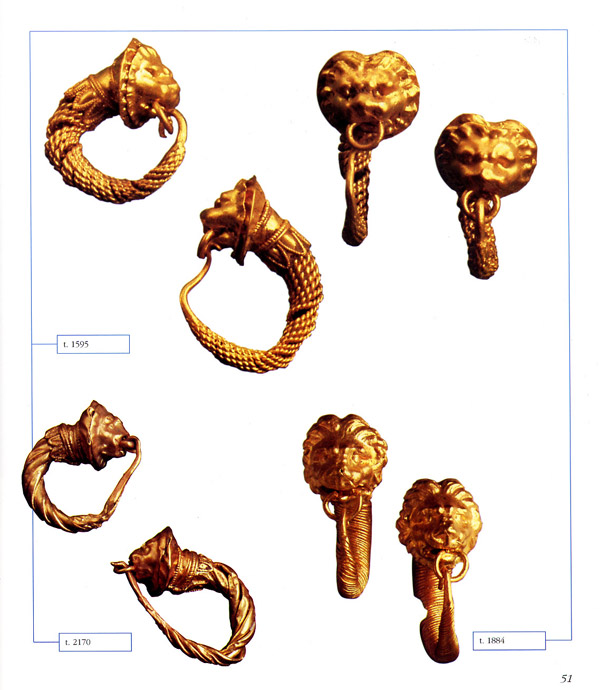
These are women who dressed up and adorned themselves to participate in every possible solemnity, displaying precious dresses and exquisite jewellery, and exploiting the skilful art of cosmetics and hairstyles, for the ceremonies that punctuated the principal phases of their life. And all these ceremonies, from weddings to religious festivities, also assumed a social significance: in so far as the whole community participated in them, and each citizen, whether man or woman, strove to prove equal to them, to the best of their respective possibilities. As for the splendour and elegance of the individual, they concurred to represent the overall prosperity and power of the community of which they formed part. And nonetheless even this pronounced community spirit did not suppress a desire to outshine others, by flaunting in public more precious dresses, more exquisite and lavish jewellery, and more sophisticated coiffeurs than others.”
(P.G. GUZZO
Archaeological Superintendent of Pompeii)
The places of his activity
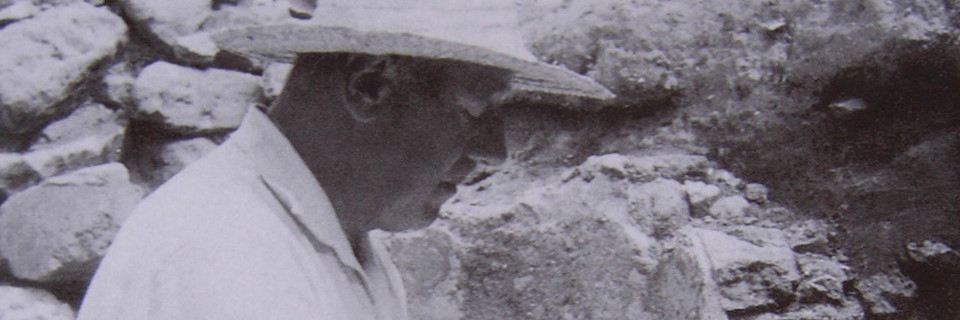
Liguria
Sicily
Aeolian Isles
Greece
Liguria.
The Arene Candide cave
(province of Savona)

Luigi Bernabò Brea with his wife Chiara Chighizola and Ginetta Chiappella in front of the Arene Candide cave, 1942.
The Arene Candide cave is situated on the southern slope of Monte Caprazoppa, which slightly projects into the sea from the coastal chain, forming a little promontory between Finale Marina and Borgio Verezzi. The cave, the largest of the many that perforate the mountains of the Ligurian littoral, forms a kind of natural loggia looking southwards through three large apertures on the long side, from which extensive views open up on the sea. Light-filled, warm, airy, sufficiently dry, at least in the cold season, and well sheltered from the cold northerly winds, the cave must have offered ideal conditions for settlement in prehistoric times. The cave now forms a large elongated cavity in the rock, on the East-West axis, parallel, that is, to the face of the rocky promontory in which it opens.
The palaeoethnological discovery of the cavern, and its first scientific explorations, were made by Arturo Issel, Genoese-born professor of geology and palaeontology, in 1864 and in the following years. In view of the long activity of excavations conducted in the cave, it was to be feared that precious little of the prehistoric deposit would have remained in situ. Nonetheless Luigi Bernabò Brea ever since his first exploration of the cave in 1940 could ascertain that undisturbed parts of the deposit still remained in various points; he then began a series of excavation campaigns, conducted in collaboration with Luigi Cardini of the Istituto Italiano di Paleontologia Umana.
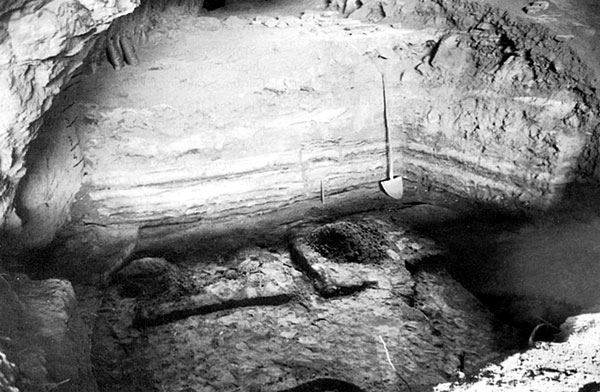
The Arene Candide cave. The trench of the excavation during the first campaign, 1942.
The stratigraphy of the deposits with pottery reached a depth of 2.70 m. The successive strata, from bottom to top, led from the remains of the early Neolithic, middle Neolithic, late Neolithic, the Bronze Age (only a few traces) and the Iron Age. In other words, the stratigraphy yielded one of the most important archaeological sequences for the prehistory of the Western Mediterranean.
The exploration and analysis of the Mesolithic strata throughout the whole area of the excavation were completed by L. Cardini during other excavation campaigns from 1941 onwards. Below the Mesolithic strata the existence of a Pleistocene deposit was ascertained; the excavations uncovered five hearths belonging to the Upper Palaeolithic and the burial of a young man with rich grave goods. The excavation then had to stop, having encountered large masses of rock impossible to remove at a depth of 8.50 m.
Four new excavations (V-VIII) could be completed between 1948 and 1950. With the exception of VII, mainly devoted to the exploration of the Mesolithic strata, these campaigns especially focused on the deposit containing pottery fragments which was excavated through almost the whole area of the eastern chamber.
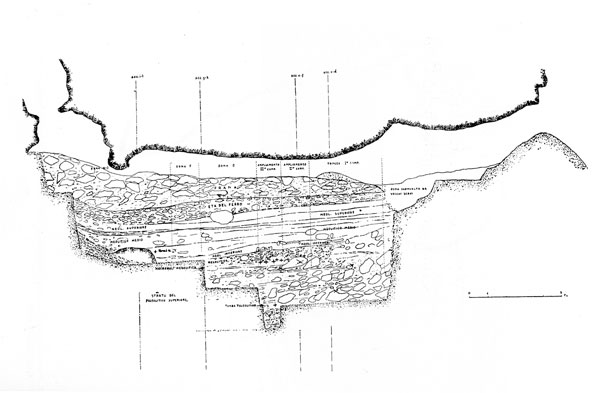
Arene Candide. The stratigraphic section revealed by the excavation in 1948-50.
Between 1972 and 1977, excavations in the Neolithic strata were resumed by Santo Tinè (University of Genoa; Tinè, ed., 1999) and then between 1997 and 2012 by Roberto Maggi (Soprintendenza Archeologica della Liguria; Maggi et alii 2023). In the meantime, the study of the lithic and faunal material integrally collected in the Bernabò Brea excavations was completed and, thanks to the quantity of charcoal preserved, the programme of radiometric dating was started (Maggi, ed., 1997).
The materials from the Arene Candide are on display in the Museo di Archeologia Ligure (Pegli -Genoa) and in the Museo Archeologico del Finale (Finale Ligure -Savona).
The cave is open to visitors (www.museoarcheologicodelfinale.it).
Bibliography:
- L. Bernabò Brea, Gli scavi nella caverna delle Arene Candide, Parte I. Gli strati con ceramiche, Bordighera 1946, pp. 1-364.
- V.G. Childe, Review of L. Bernabò Brea - Gli scavi nella caverna delle Arene Candide: Gli strati con ceramiche, 1946, in Proceedings of the Prehistoric Society, 1949.
- L. Bernabò Brea, Gli scavi nella caverna delle Arene Candide, Parte prima. Gli strati con ceramica, Vol. 2: Campagne di scavo 1948-50, Bordighera 1956, pp. 1-296.
- R. Pittioni, Review of Bernabò Brea Gli scavi nella caverna delle Arene Candide vol II, 1956, Archaeologia Austriaca 1957, p. 104.
- A. Bietti, The Upper Pleistocene deposit of the Arene Candide Cave (Savona, Italy) new studies on the 1940-42 excavations, Quaternaria Nova IV, Roma 1994.
- R. Maggi, Arene Candide: A functional and Environmental assessment of the Holocene sequence (Excavations Bernabò Brea - Cardini 1940-1950), in Memorie dell'Istituto Italiano di Paleontologia Umana, Nuova serie, Roma 1997, pp.1-643.
- S. Tinè (a cura di), Il Neolitico nella caverna delle Arene Candide (scavi 1972-1977), Bordighera, 1999.
- L.H. Barfield, The contribution of L. Bernabò Brea to North Italian Neolithic and considerations on the problems of establishing a chronology, in M. Cavalier, M. Bernabò Brea, In memoria di Luigi Bernabò Brea, Palermo, 2002, pp. 13-26.
- R. Maggi, Lo scavo di Luigi Bernabò Brea nella caverna delle Arene Candide nel contesto storico degli studi di Preistoria in Italia, in P. Pelagatti G. Spadea, a cura di, Dalle Arene Candide a Lipari. Scritti in onore di Luigi Bernabò Brea. Atti del Convegno di Genova 3-5 Febbraio 2001, in Bollettino d'Arte, volume speciale, 2004, pp.167-176.
- R. Maggi, L. Drieu, E. Bourgevin, A. Mazury, G. Boschian, V.S. Sparacello, Caverna delle Arene Candide. Scavi 1997-2012. Appunti sul Neolitico, in Preistoria e Protostoria della Liguria, Rivista di Scienze Preistoriche, LXXIII S3, 2023, pp. 419-466.
Akrai
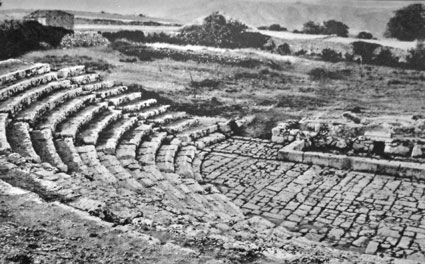
The theatre of Akrai seen from the air
Ancient Akrai, a colony of Syracuse founded in 664 BC, survived until the Arab period and was later replaced by medieval Palazzolo. But conspicuous monuments remain of the Greek colony. They were explored by Gabriele Iudica in the 19th century. Luigi Bernabò Brea conducted important excavations on the site from 1950 on and especially from 1963, when the main lines of the town plan were revealed. The small theatre, certainly no later than Hiero II (3rd century BC), presents a regular plan. The orchestra had the form of a perfect semicircle. The cavea, the area of tiered seating, was also semicircular, rather than horseshoe shaped; it was hewn into the hillside and divided into nine segments by eight stairways. The scaena must have had a colonnaded or pilaster-fronted logeion. The theatre was remodelled in the Roman period, when the existing paving of the orchestra was done and when the stage (pulpitum) was moved forwards into the orchestra itself. Adjacent to the theatre is the bouleuterion, seat of the city's senate, which must have faced onto the agora, or forum, centre of the civil and political life of the city. The Temple of Aphrodite, the main deity of Akrai, stood on top of the hill overlooking the town.
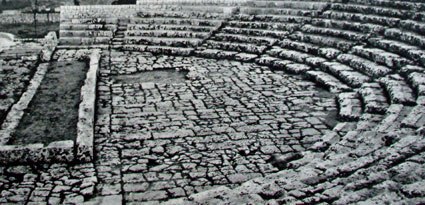
Il teatro di Akrai - Particolare dell'orchestra e della scena
The rock sanctuary of Cybele was situated on one of the spurs that branch out eastwards from the hill of Acre. The cult of Cybele, an Asian deity, was probably introduced into Sicily by Dionysius II, who had become a priest of the goddess during his exile in Corinth. Numerous images of the goddess, almost always seated, with two lions at her feet, with a panther in her hand and a drum in the other, are carved into the bare rock.
Bibliography:
- L. Bernabò Brea, con la collaborazione di G. Pugliese Carratelli e C. Laviosa. Akrai, Società di Storia Patria per la Sicilia Orientale, Serie III, Catania 1956, pp. 1-187.
- L. Bernabò Brea, D’angelo, Il tempio di Afrodite dell’antica Akrai, 1985.
- L. Bernabò Brea, Il tempio di Afrodite di Akrai, Napoli, Centre Jean Bérard, 1985)
- L. Bernabò Brea, Il tempio di Afrodite di Akrai, in Cahiers du Centre Jean Bérard, X. Napoli 1986, pp. 1-87.
Longane
This is an important Sicel site, which flourished in the archaic period and perhaps disappeared in the 5th century BC; this would explain the lack of any historical records of the site. Discovered thanks to the field work of the honorary inspector D. Ryolo, it was investigated by Bernabò Brea through extensive excavations, directed by G.F. Carrettoni. The settlement itself was not fortified, in contrast to its two acropolises. Of that to the South, the remains of a fortress built in the megalithic technique survive. The acropolis to the North (on Monte Ciappa 442 m) is more extensive; it is surrounded by a drystone agger (rampart) from which square towers or gateway-towers projected; at least their corners were constructed in ashlared blocks. A Bronze Age settlement existed on the site of the city, while a cemetery of artificial rock-cut tombs dating to the Iron Age (8th to 7th century BC) extended in the area of Rodì, on the opposite side of the valley.
Bibliography:
- D. Ryolo Di Maria, Il Longano e la sua battaglia, in Archivio Storico Siciliano, Palermo 1950.
- L. Bernabò Brea, La necropoli di Longane, in Bullettino di Paletnologia Italiana, N.S. XVIII, vol.76, 1967, pp.181-254
- L. Bernabò Brea, Longane, (con appendice di G.F.Carrettoni), in Quaderni di Archeologia, Università di Messina I,1,2000, pp. 7-57.
Mylai (Milazzo)
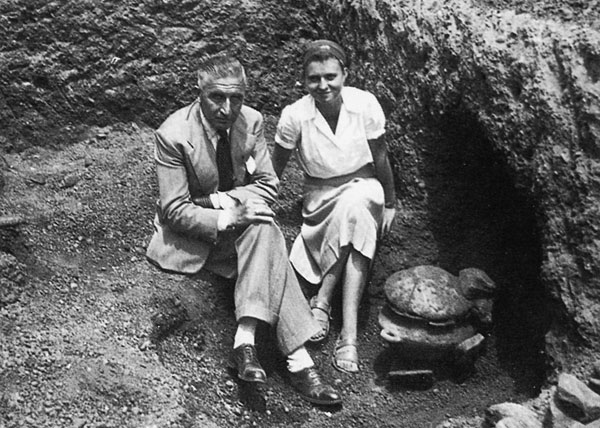
Domenico Ryolo and Madeleine Cavalier on the excavation of the necropolis on the Isthmus of Milazzo in 1950
The concurrence of a series of particularly favourable geographic factors turned Milazzo into one of the more suitable sites for human settlement in antiquity. The Acropolis of Milazzo is now dominated by the Castle dating to the Hohenstaufen and Aragonese period and surrounded by imposing fortifications of the 16th and 17th century, which turned the city into one of the military bastions to secure Spain's military domination over Sicily. Milazzo was the site of important settlements at least since the Bronze Age. In the period of Greek colonization Mylai was perhaps founded not as an independent polis, but as a colony and maritime fortress of the state of Zankle-Messana, which used it to defend its possession of the rich agricultural plain and the harbour. Its foundation is placed in 716 BC.
The excavations conducted by L. Bernabò Brea and M. Cavalier in the city's burial sites were particularly important for the reconstruction of the complex development of the settlement pattern of Milazzo. They demonstrated that Milazzo was closely linked to the Aeolian Isles both from a cultural and an historical point of view. The Greek necropolis of the isthmus is situated in the area of the isthmus. It was superimposed over the earlier proto-Villanovan burial site. The huge and rich cemetery of Predio Caravello in the district of Sottocastello, to the north of the Rocca, is dated to the Milazzese period (middle Bronze Age). Some little pots in the Capo Graziano style, and remains of tombs disturbed by later inhumations, found in the area of Piazza Roma, demonstrate that the burial site must have already been formed during the 16th or 15th century BC. Sporadic traces of Ausonio I (1260-1125 BC) were found instead in the Borgo on the eastern slope of the Castle. Explorations recently conducted by the Soprintendenza of Messina (G.Tigano) have regarded not only the cemetery on the isthmus, but also the Bronze Age settlement site.
Bibliography:
- L. Bernabò Brea,Bernabò Brea, Rinvenimenti nella Sicilia Orientale (Siracusa, Lipari, Salina, Panarea, Basiluzzo, Milazzo, Novara di Sicilia, Leonforte, Assoro, Agira, Nissoria, Piazza Armerina, Centuripe, Marina di Ragusa, Scicli, Comiso, ecc)”Notizie scavi 1947
- L. Bernabò Brea, M. Cavalier, Civiltà preistoriche delle Isole Eolie e del territorio di Milazzo, Bullettino di Paletnologia Italiana, 1956
- L. Bernabò Brea, M. Cavalier, Mylai, Società di Storia Patria per la Sicilia Orientale, Serie III, Monografie archeologiche della Sicilia-II, Novara 1959, pp. 1-136.
- L. Bernabò Brea, M. Cavalier , voce “Milazzo”, Bibliografia topografica della colonizzazione greca in Italia e nelle isole tirreniche, 1992
Pantalica
(province of Syracuse)

The anaktoron of Pantalica
Pantalica is the most conspicuous of the towns that flourished in Sicily in the Late Bronze Age and Early Iron Age. It is situated some twenty kilometres inland from Syracuse. The archaeological exploration of Pantalica was largely due to Paolo Orsi (1889-1897). Luigi Bernabò Brea conducted excavations especially in the area of the anaktoron between 1957 and 1971. The indigenous site of Pantalica can perhaps be identified with the ancient Hybla, whose king Hyblon permitted the Megarean colonists under their leader Lamis to found the Greek colony of Megara Hyblaea in a marginal area of his territory. The prehistoric settlement occupied an isolated rocky outcrop, surrounded all round by high cliffs, in large part inaccessible, that drop sheer to the river Anapo and its tributary Calcinara. Only the narrow saddle of Filiporto joins it to the plateau behind. So it was a real natural fortress.
At the centre of upland plateau, in an isolated position, stood the king's residence in megalithic structure (anaktoron), which is reminiscent in miniature of Mycenaean palaces and which also bears the traces of having been reused during the Byzantine period. The building, excavated by Orsi who also found the remains of a bronze foundry on the site, was subjected to an important study by Bernabò Brea. Countless artificial cave-tombs are concentrated on the rocky crags surrounding the town. Orsi counted some 5000 of them. They date between the 13th and 7th century BC. The grave goods found in these burials provide the basis for the chronology of the cultures of eastern Sicily between the late Bronze Age and the early Iron Age, as defined by L. Bernabò Brea on the basis of Orsi's periodization.
Bibliography:
- P. Orsi, Pantalica e Cassibile, in Monumenti Antichi dei Lincei, IX, 1899. col. 34 e segg.
- L. Bernabò Brea, Pantalica. Ricerche intorno all'anáktoron, XIV, Centre Jean Bérard - Istituto Studi Acrensi, Naples- Palazzolo Acreide, 1990, pp. 1-110.
- L. Bernabò Brea, voce “Pantalica”, Bibliografia topografica della colonizzazione greca in Italia e nelle isole tirreniche, 1994
The Theatre of Syracuse

The Greek theatre of Syracuse
The ancient Theatre of Syracuse, which is of exceptional importance in the history of the ancient theatre, is hewn into the limestone of the Temenite hill; its cavea (semicircular seating area) faces the great harbour (Porto Grande). Historical records of its existence exist since the early 5th century BC. We even know the name of its architect, Democopos, nicknamed Myrilla for having ordered the distribution of perfumes (myroi) on the day of its inauguration. It was the theatre in which the tragedies of Aeschylus and the comedies of Epicharmos were performed, but it was also there that meetings of the people of Syracuse were held and civic affairs were discussed in the presence of the assembled citizenry. The theatre underwent various modifications in the course of time; it was transformed during the Roman imperial period. The study conducted on it by Luigi Bernabò Brea was aimed at better defining its chronology, architectural characteristics and building phases.
Bibliography:
- L. Bernabò Brea, Studi sul teatro greco di Siracusa, in "Palladio" Anno XVII, n. I-IV – Gennaio Dicembre 1967, pp.97-154.
- C. Voza, Guida di Siracusa, Siracusa 1994, pp.193-200.
Syracuse.
The monumental zone of the Neapolis
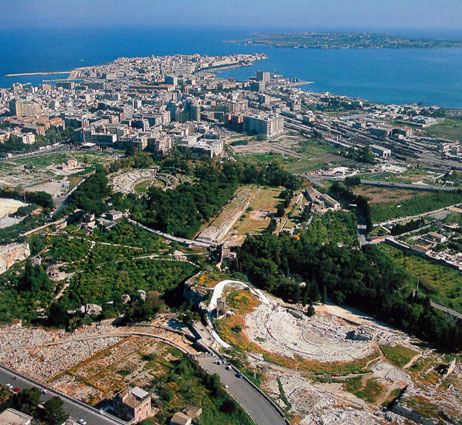
A view of the monumental zone of Syracuse
The great urban expansion of modern Syracuse sharply intensified in the 1950s. It had as its consequence that the monumental zone of the Neapolis, which until a few decades before had been situated in an idyllic and peaceful rural setting on the outskirts of the city, now found itself in the immediate periphery of the modern city, which progressively encroached upon it and even spread beyond it. Luigi Bernabò Brea realized the vital need to ring-fence this extremely important archaeological zone and properly incorporate it in the town planning of modern Syracuse. So between 1952 and 1955 he mounted a concerted and bitterly contested campaign aimed at safeguarding this zone and enabling its individual monuments to be reunited in a single "Parco della Neapolis": the Greek theatre, the sanctuary of Apollo, the altar of Hiero II, the quarries known as the Latomia del Paradiso, Latomia dell'Intagliatella, and Latomia di Santa Venera, the amphitheatre, and the so-called "Tomb of Archimedes" were all included in the Park. Almost all the areas between the individual monuments comprised in the Park were expropriated, and the individual monuments, wrested from the isolation to which they had been reduced, were joined together by green areas. Here systematic excavations were conducted. They demonstrated how the monuments were interconnected in antiquity, and restored them to the urban fabric of which they formed part. The successors of L. Bernabò Brea in the direction of the Soprintendenza have continued his work and devoted themselves energetically to the conservation and promotion of the Park and its access to the public, convinced of its importance: "... the Parco della Neapolis... is the achievement of an enormous effort to protect the ancient heritage, the result of an operation that has maintained its character of prestige not only for the city, but for the whole island of Sicily over these last fifty years" (G. Voza 2002, p. 256).
Bibliography:
Tyndaris
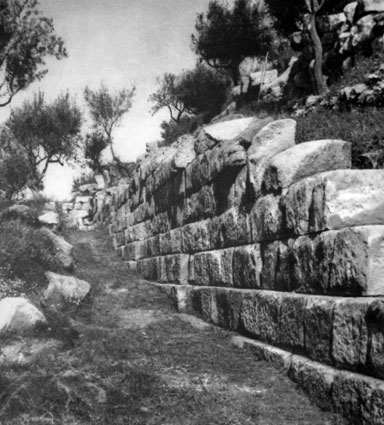
Tyndaris. A stretch of the ancient circuit of walls
The Greek city of Tyndaris was founded by Dionysius of Syracuse around 396 BC in part of the territory of the ancient Abacaenum. It occupied a formidable strategic position, once the site of a Bronze Age settlement (Rodì-Tindari-Vallelunga facies). Subjected by Rome after 257, it enjoyed a thriving development alternating with periods of crisis until it was eventually destroyed by the Arabs in 836 AD. Explored and studied already in the 18th and 19th century, it was subjected to systematic excavations and ambitious programmes of restoration between the end of the war and the 1970s, under the direction of L. Bernabò Brea and M. Cavalier and with the collaboration of N. Lamboglia of the Istituto di Studi Liguri.
THE CITY WALLS
The walls of Tyndaris, large parts of which were brought to light in 1955-56 (F. Barreca, N. Lamboglia) represent, also thanks to their fine conservation, one of the most imposing fortification complexes in Greek Sicily. Pierced by a series of posterns, they are interrupted by an imposing system of ramparts round the main gateway leading into the city, preceded by a semicircular outwork, or tenaille, protected by two large towers.
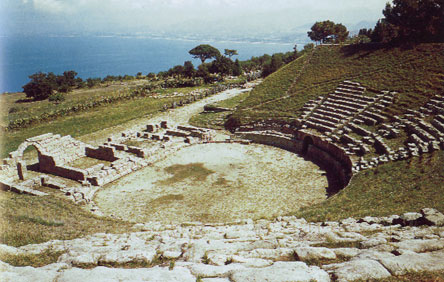
The teathre
THE THEATRE
Erected in the Greek period, probably during the 4th century BC, and considerably modified in the Roman imperial period, the theatre of Tyndaris is located in a scenic position, with the cavea (hemisphere of tiered seating) facing the sea. It was subjected to two demanding restoration campaigns in 1938 (G. Cultrera) and between 1960 and 1966 (L. Bernabò Brea).
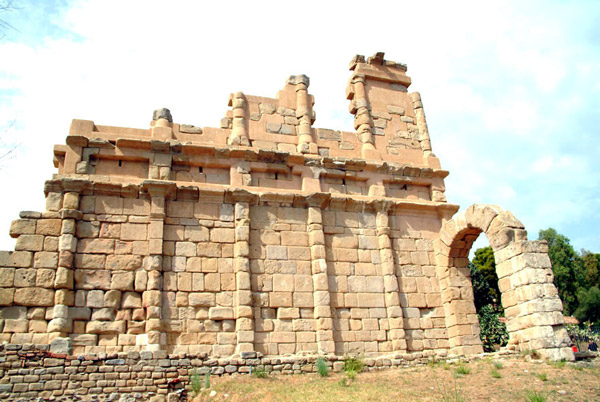
The north side of the "basilica" reconstructed in the 1950s
THE BASILICA
The monument, traditionally known as "Gymnasium" or "Basilica", is in actual fact a propylaeum (monumental entrance-gateway) of the great agora (forum) that formed the centre of civic life. The whole wall downhill from the great gallery, which had collapsed before the Byzantine period, but whose blocks had remained undisturbed on the slope, was re-erected in 1956, as too was the façade of the propylaeum facing towards the theatre; here too most of the blocks of its arches could be retrieved.
THE TOWN PLAN
The excavations conducted in the urban area between 1949 and 1956 permitted the essential lines of the town plan to be identified. It consisted of major parallel streets (decumani) orthogonally intersected by minor streets laid out on the steep slope (cardines).
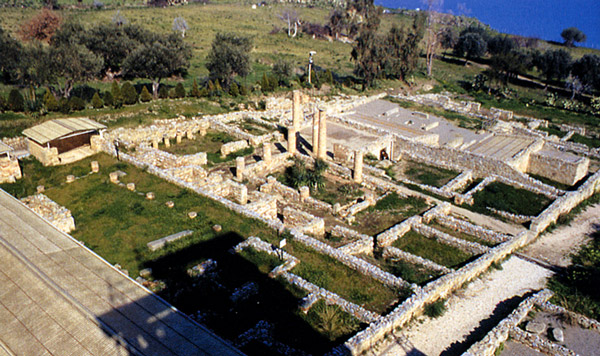
Insula IV. View from the South-East
INSULA IV
The excavation of insula IV was conducted by D. Restagno and M. Cavalier in the years 1950-1955. The insula is laid out on a steep slope and consists of a series of distinct buildings. On the lower terrace, at the level of the lower decumanus, is a series of six tabernae (shops). On the middle terrace is laid out a dwelling house equipped with a large square peristyle-courtyard with little garden in the middle. The tablinum opened up onto it. The upper part of the insula, lastly, was occupied by a single bath-house with fine mosaic pavement, which was laid out on two consecutive terraces placed on a slight gradient.
Bibliography:
- L. Bernabò Brea, Tindari (Messina) Restauro di un tratto delle mura greche, in Bollettino d'Arte, N. I-II, Gennaio-Giugno 1966, p.114; Scavo e restauro del teatro greco, p.114; Restauro della Basilica, p. 115.
- L. Bernabò Brea, Due secoli di studi, scavi e restauri del teatro greco di Tindari, in Rivista dell'Istituto nazionale d'Archeologia e Storia dell'Arte. Nuova serie, XIII-XIV. 1964-1965, pp.99-144.
- L. Bernabò Brea M. Cavalier, Scavi in Sicilia. Tindari.- Area urbana, L'insula IV e le strade che lo circondano, in Bollettino d'Arte del Ministero della Pubblica Istruzione. N. III-IV, Luglio-Dicembre 1965, pp. 205-209.
- U. Spigo, Tindari. L'area archeologica e l'antiquarium, Rebus edizioni, Milazzo 2005.
Lipari.
Acropolis.
Prehistoric villages
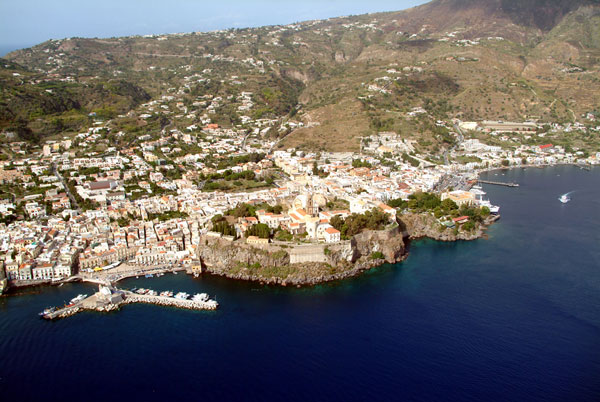
Lipari. The Castello seen from the sea
The Acropolis of ancient Lipàra geologically consists of a mass of rhyolite (fine-grained igneous rock), in part vitreous, which rises from the coastal plain of Diana and projects with precipitous rock walls into the sea, forming two little bays, two natural harbours: Marina Lunga to the North, Marina Corta to the South. The excavations conducted by Bernabò Brea and Madeleine Cavalier from 1950 onwards then uncovered on the upper plateau of the Castello the traces of the Greek and Roman city and the prehistoric villages that preceded them, revealing a stratification that reached a depth of nine metres at some points.
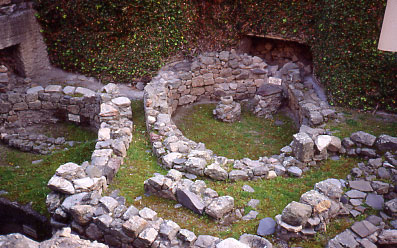
The Castello of Lipari. Detail of the huts of the middle Bronze Age superimposed over those of the early Bronze Age
The Cnidian colonists founded the new Lipàra here in the 50th Olympiads (580-576 BC). The area of the Acropolis must soon have proved to be insufficient, however, and so the city spread over its slopes down to the plain below. The Greek city was destroyed by the Romans in 252-251 BC. The Romans then transformed the acropolis into a fortress, probably razing all its buildings to the ground. This explains the almost total absence of buildings of the Greek period. Only a century later, once the political situation in the lower Tyrrhenian had changed and the Aeolian Isles had lost all their strategic value, the acropolis once again returned to be a residential quarter. Dating to this period is a town plan consisting of a series of rectangular blocks (insulae), divided by seven rectilinear streets (cardines), equidistant and running parallel to each other from East to West; each of them is 10 feet wide and furnished with an axial drainage channel. These streets were intersected orthogonally by a series of other wider streets (decumani) running from North to South. As far as the earlier periods are concerned, the building remains attributable to Ausonio II and Ausonio I (late Bronze Age) in the southern zone of the archaeological area are limited. By contrast, there are conspicuous remains of the village of the Milazzese period (middle Bronze Age) superimposed over the village of Capo Graziano (early Bronze Age). In the northern zone the huts of the Milazzese and Capo Graziano periods are equally numerous but less conspicuous, in part because overlaid by the huts of Ausonio I and Ausonio II. The archaeological deposit descends for a further four or five metres below the floor level of the huts of the early Bronze Age. The stratigraphy was explored by trial shafts, later filled in, sunk within the individual huts and with larger trial trenches opened to the West.
Bibliography:
- L. Bernabò Brea M. Cavalier F. Villard, Meligunìs Lipàra, vol. IX. Topografia di Lipari in età greca e romana. Parte I. L'Acropoli. Palermo 1998, pp. 1-265.
- L. Bernabò Brea M. Cavalier, Il Castello di Lipari e il Museo Archeologico Eoliano, Flaccovio, Palermo 1970, pp. 1-214.
- L. Bernabò Brea M. Cavalier, Meligunìs Lipàra IV. L'Acropoli di Lipari nella preistoria con appendici di W. Taylour, M. Garasanin, E. Contu, J.L. Williams, M. Alessio, F, Bella, C. Cortesi, B. Turi, T. Mannoni, Palermo 1979, (volume di testo) pp. 1-875 ; (volume di tavole) tavv. I-CCCXXII e l'atlante.
Lipari.
The Piazza Monfalcone
burial site
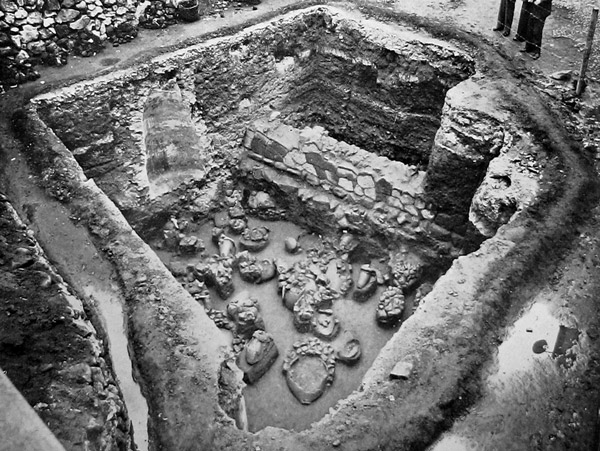
Lipari. View of the excavation of the Piazza Monfalcone burial site, with a stretch of the first Greek circuit of walls
Excavations conducted by Bernabò Brea and Madeleine Cavalier in the Piazzetta Monfalcone (now L.S. d'Austria) in 1954, at the centre of the present-day town, uncovered a stretch of the archaic city walls of Greek Lipàra, below which extended a huge burial site datable to the late Bronze Age. In it cremation tombs with the ashes gathered in situlae (burial urns), placed horizontally in the ground and closed with a stone slab, are superimposed over and intermixed with inhumation burials with skeletons huddled in large jars (pithoi).
Bibliography:
Lipari.
The Greek walls and
the agger of Sextus Pompeius

The exterior of the Greek walls with the square tower that protected the city gatewa
The first circuit of walls of Greek Lipàra was erected in the 5th century BC. However, rapid demographic expansion soon made the area it surrounded insufficient. So a new and far larger circuit of walls had to be built in the first half of the 4th century BC (340-300 BC): it almost doubled the urban area, connecting at its two ends the crag of the Castello to the South and that of La Cìvita to the North and running for over two hundred metres in the open plain.
The excavations conducted by Bernabò Brea and Cavalier in 1972 brought to light various long stretches of the rectilinear curtain protecting the city on the plain. The walls were stoutly built; they had a thickness of just under four metres and were faced on both the interior and exterior sides with perfectly ashlared blocks of purplish-red latitandesite from Monte Rosa, laid in isodomic courses; the rubble core of the walls consisted of an èmplekton of very compact small stones.
At least two robust square towers projected from the line of the walls, constructed with the identical technique, to defend the gateways leading into the city.
The new excavation campaign in 1984-1987 in the stretch between the Via Diana and the Vico Scudo revealed the ground level of the siege of 152-251 BC.
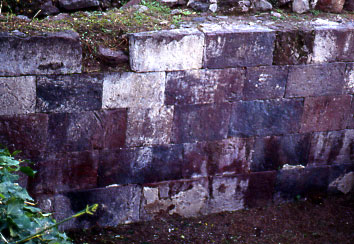
The Greek walls. Detail of the facing in ashlared blocks laid in isodomic courses
Parallel to the Greek walls on their external side, at a distance of some 6 metres, another system of fortification, far coarser in construction, was revealed by the excavations. This was an agger, or rampart, rather than a wall in the proper sense. It was built roughly of drystone rubble and reused blocks. It can be placed in relation to the civil wars between Octavian and Sextus Pompeius (43-36 BC).
Bibliography:
- L. Bernabò Brea, Le fortificazioni greche di Lipari, in Saggi in onore di Guglielmo De Angelis D'Ossat, Istituto di Storia dell'Architettura, Roma 1987, pp. 145-153.
- L. Bernabò Brea M. Cavalier, Meligunìs Lipàra IX. Topografia di Lipari in età greca e romana. Parte II- La città bassa; con allendici di M.A. Mastelloni, E. Messina, G. Ancona, A. Ollà, L. Campagna, U. Spigo, Palermo 1998, pp. 1-409.
Lipari.
The Greek and
Roman necropolis
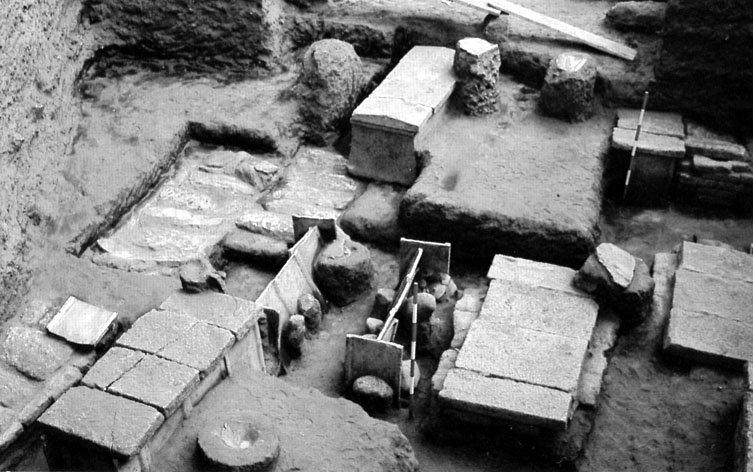
Lipari. Necropolis excavation XXIII, 1985
After the trial dig conducted by Paolo Orsi in 1928, Luigi Bernabò Brea and Madeleine Cavalier systematically conducted, from 1948 to 1995, the exploration of the necropolis laid out in the plain of Diana, extending between the Ponte ravine to the South to that of Santa Lucia to the North. Small groups of tombs were also excavated in the Contrada Sant’ Anna and at Portinenti.
The tombs of the necropolis range in date from the very foundation of the Greek city, i.e. from 580 BC, to the Roman imperial period.
They are not uniformly distributed through the Contrada Diana, but gathered in huge agglomerations, separated by unoccupied zones. Probably the burials took place in localized areas especially allocated to this purpose, perhaps the property of confraternities or associations of a funerary character. The land in question was situated outside the city walls, since it was the invariable rule in the Greek and Roman world for burials to take place outside the urban area. This explains the great density and overlaying of burials in several superimposed layers in delimited zones, the maintenance of the same orientation of the tombs, always with the head to the South, and their alignment in more or less regular rows.
Both in the Greek and Roman periods the necropolis presented a mixed funerary rite: in the former case the majority of burials were inhumations and the minority cremations, whereas in the Roman period this proportion was reversed.
Among the many aspects of particular interest, the wealth of the grave goods that accompanied the burials in the 4th century BC is worth emphasizing. The artefacts found in these funerary assemblages include significant examples of painted pottery and a very large number of theatrical masks (4th – 3rd century BC), which represent the largest complex of this type hitherto found in the Greek world./p>
Bibliography:
- L. Bernabò Brea M. Cavalier, Meligunìs Lipàra II, La necropoli greca e romana nella contrada Diana, Palermo 1965, pp. 1-380.
- L. Bernabò Brea M. Cavalier, Meligunìs Lipàra V, Scavi nella necropoli greca di Lipari, Roma,1991, pp. 1-199.
- L. Bernabò Brea M. Cavalier, Meligunìs Lipàra VII. Lipari. Contrada Diana.Scavo XXXVI in proprietà Zagami (1975-1984) con contributi di S.L. Agnello e F. Villard, Palermo 1994, pp. 1-288
- L. Bernabò Brea M. Cavalier, F. Villard, Meligunìs Lipàra XI, Gli scavi nella necropoli greca e romana di Lipari nell'area del terreno vescovile Parte I e Parte II, Palermo 2001,pp. 1-818.
- L. Bernabò Brea M. Cavalier, L. Campagna, Meligunìs Lipàra XII, Le iscrizioni lapidarie greche e latine delle isole Eolie, Palermo, 2003, pp. 1-275.
- L. Bernabò Brea, Menandro e il teatro greco nelle terracotte liparesi, Genova, 1981.
- L. Bernabò Brea, Maschere e personaggi del teatro greco nelle terracotte liparesi, Roma 2001.
Lipari.
The thermal complex
of San Calogero
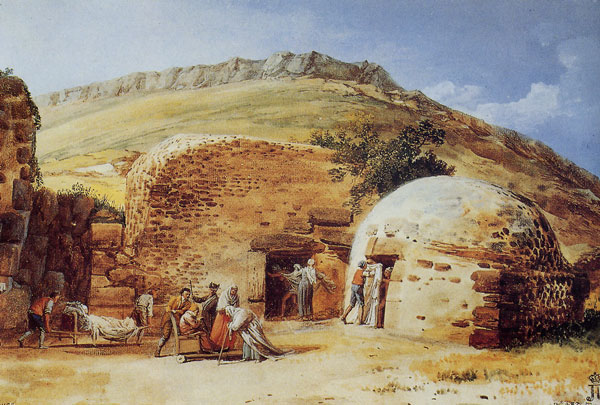
The thermal complex of San Calogero on Lipari, in a veduta painted by Jean Houel in 1776
The thermal springs of the island of Lipari, recorded by writers of the Greek and Roman periods, were so famous that one of the minor thermal establishments in Rome bore the name of Eolia.
There is no doubt that these classical citations of Lipari refer in particular to the hot spring of San Calogero, on the western side of the island, to which a carriageway now descends from Piano Conte.
The building over the spring is a pseudo-domed chamber, of the kind known as a tholos, roofed by a corbelled vault constructed with superimposed concentric rows of blocks in isodomic courses, the one projecting slightly over the other, and hence with a gradually diminishing diameter from bottom to top. The blocks are perfectly smoothed on the inside, but only rough-hewn on the rear side, given that the tholos, set into the hillside, was largely invisible from the outside.
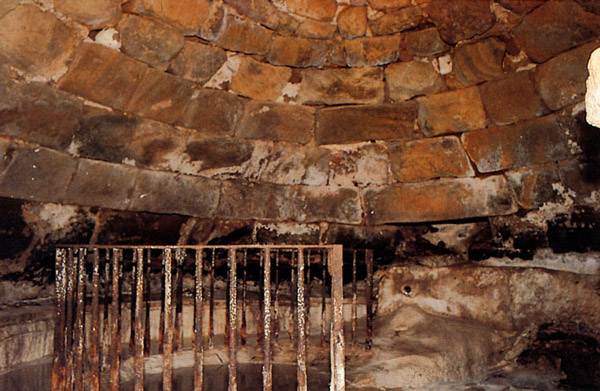
The interior of the thermal Tholos
This is a type of structure characteristic of Mycenaean architecture. Its small dimensions are in evident relation to the function itself of the bath-house for which it was built. Trial excavations conducted by Bernabò Brea and Cavalier in 1985, both on the inside and outside of the building, seem to confirm this opinion, already deducible from structural examination of the monument.
Bibliography:
- L. Bernabò Brea M. Cavalier, La tholos termale di San Calogero nell'isola di Lipari, Studi Micenei ed Egeo-Anatolici, 1991, pp. 1-78.
Filicudi.
Villages of the Bronze Age
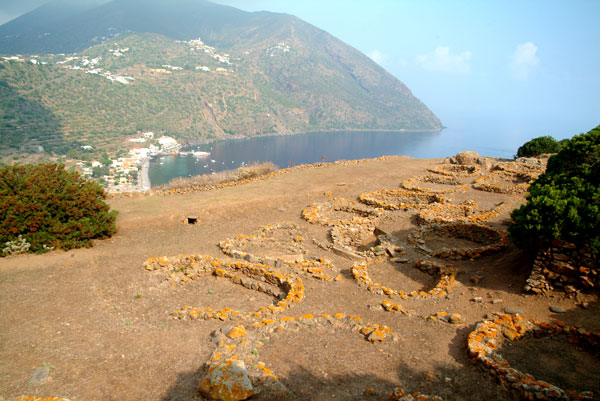
The Bronze Age settlement of the Montagnola di Capo Graziano seen from the south-east
On the island of Filicudi there are two large Bronze Age villages, established during the cultural phase of Capo Graziano (ancient Bronze Age, about 2300-1500 B.C.), named after one of them, the Montagnola del Capo Graziano.
The oldest village, called Filo Braccio and pertaining to the early phase of the culture (2300-1700 B.C.), is located on the southern side of the Piano del Porto, extending for about 900 m along the shoreline. It has been heavily damaged by erosion. The limited excavations conducted in 1959 by Bernabò Brea and Cavalier identified five huts (Bernabò Brea, Cavalier 1966 and 1991).
More recently, investigations were resumed by M.C. Martinelli, uncovering five more huts that provided significant material and important economic and environmental data (Martinelli et alii 2010).
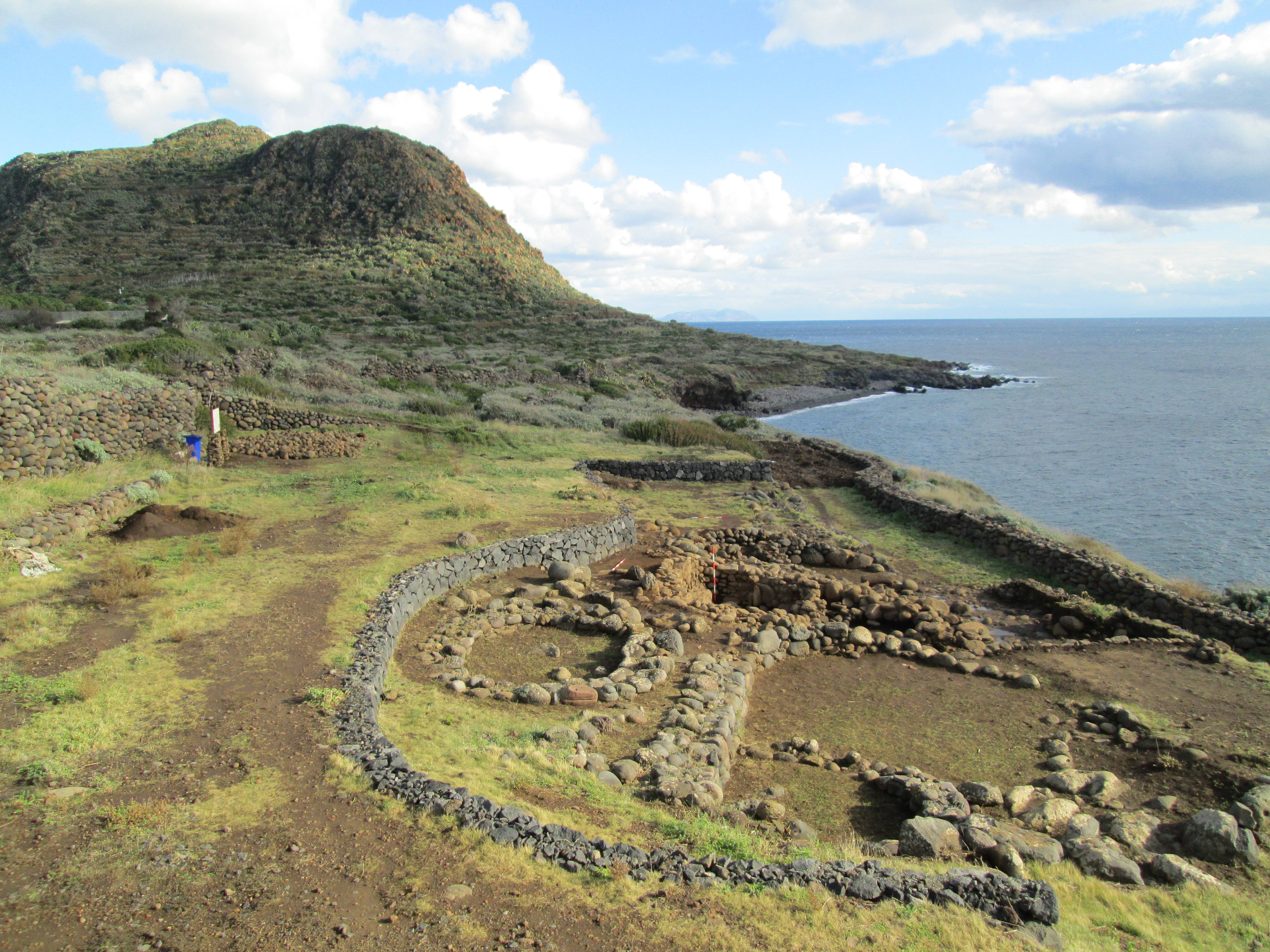
The Bronze Age settlement of Filo Braccio (the huts D, E, G, I and the open space L)
During the 17th century B.C., the settlement moved from the undefended Piano del Porto to the natural stronghold of the Montagnola di Capo Graziano (alt. 174 metres above sea level). From 1952 until 1964, Luigi Bernabò Brea and Madeleine Cavalier conducted extensive excavations there, which uncovered 26 huts.
The site has steep and extremely uneven sides; only on the eastern side, now terraced, is the slope less steep. The main nucleus of the village was concentrated on a flat area about 100 x 30 m wide, at 100 metres above sea level, but the huts must have extended to the top of the Montagnola.
The village developed during the second phase of the Capo Graziano culture (1700-1500 B.C.) and continued to flourish during the subsequent period of the Milazzese culture (1500-1300 B.C.), at the end of which it was abandoned.

The location of the Montagnola and Filo Braccio Bronze Age sites in the Filicudi Island.
Among the important materials found, the presence of Mycenaean pottery is remarkable (Bernabò Brea, Cavalier 1966 and 1991).
The structures of the villages of the Montagnola di Capo Graziano and Filo Braccio have been preserved in view and are part of the Archaeological Park of the Aeolian Islands.
The materials found are exhibited in the Museo Regionale Eoliano Luigi Bernabò Brea at Lipari.
Bibliography:
- L. Bernabò Brea M. Cavalier, Ricerche paletnologiche nell'isola di Filicudi, Bullettino di Paletnologia Italiana, n.s. XVII, vol. 75, 1966, pp. 143-173.
- L. Bernabò Brea M. Cavalier, Meligunìs Lipàra, Vol VI. Filicudi. Insediamenti dell'età del bronzo con appendici di Rosa Maria Albanese Procelli, Maria Clara Martinelli. Pietro Villari, John L. Williams, Palermo 1991, pp.1-352.
- M.C. Martinelli, G. Fiorentino, B. Prosdocimi, C. D’Oronzo, S.T. Levi, G. Mangano, A. Stellati, N. Wolff, Nuove ricerche nell’insediamento sull’istmo di Filo Braccio a Filicudi. Nota preliminare sugli scavi, Origini, XXXII, 2010, pp. 285-314.
- M.C. Martinelli, Isole Eolie. Filicudi nell’età del Bronzo. Regione Siciliana, Assessorato dei Beni Culturali e dell’Identità siciliana, Palermo, 2015
Salina.
Village of Portella
(middle Bronze Age)
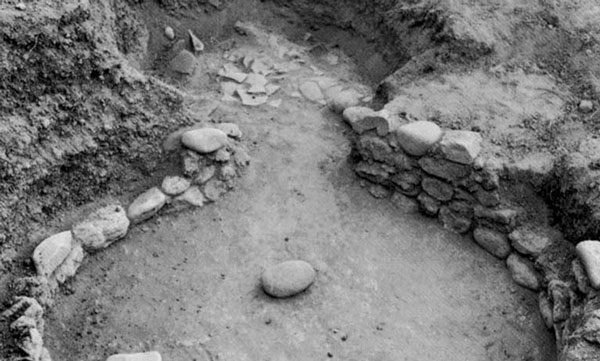
Middle Bronze Age settlement of La Portella (excavated in 1956) - Hut A
In the course of the 14th century BC, while the Milazzese culture was flourishing, the Bronze Age settlement on the island of Salina, like that on Filicudi, had to move to safer ground, evidently in response to the growing danger of enemy incursions. In fact it was transferred to an extremely inconvenient but impregnable position on the summit of a narrow crest of land between two deep ravines with almost inaccessible vertical walls on all sides.
A substantial part of the site was explored by Bernabò Brea and Cavalier in 1955. They uncovered ten circular huts built into the steep slope of a terrain composed of compacted pumice and lapilli; the huts were semi-interred on the mountain side and built over raised foundations in drystone walling on the side facing the sea. The village presented evident signs of having been violently destroyed, in many cases by fire.
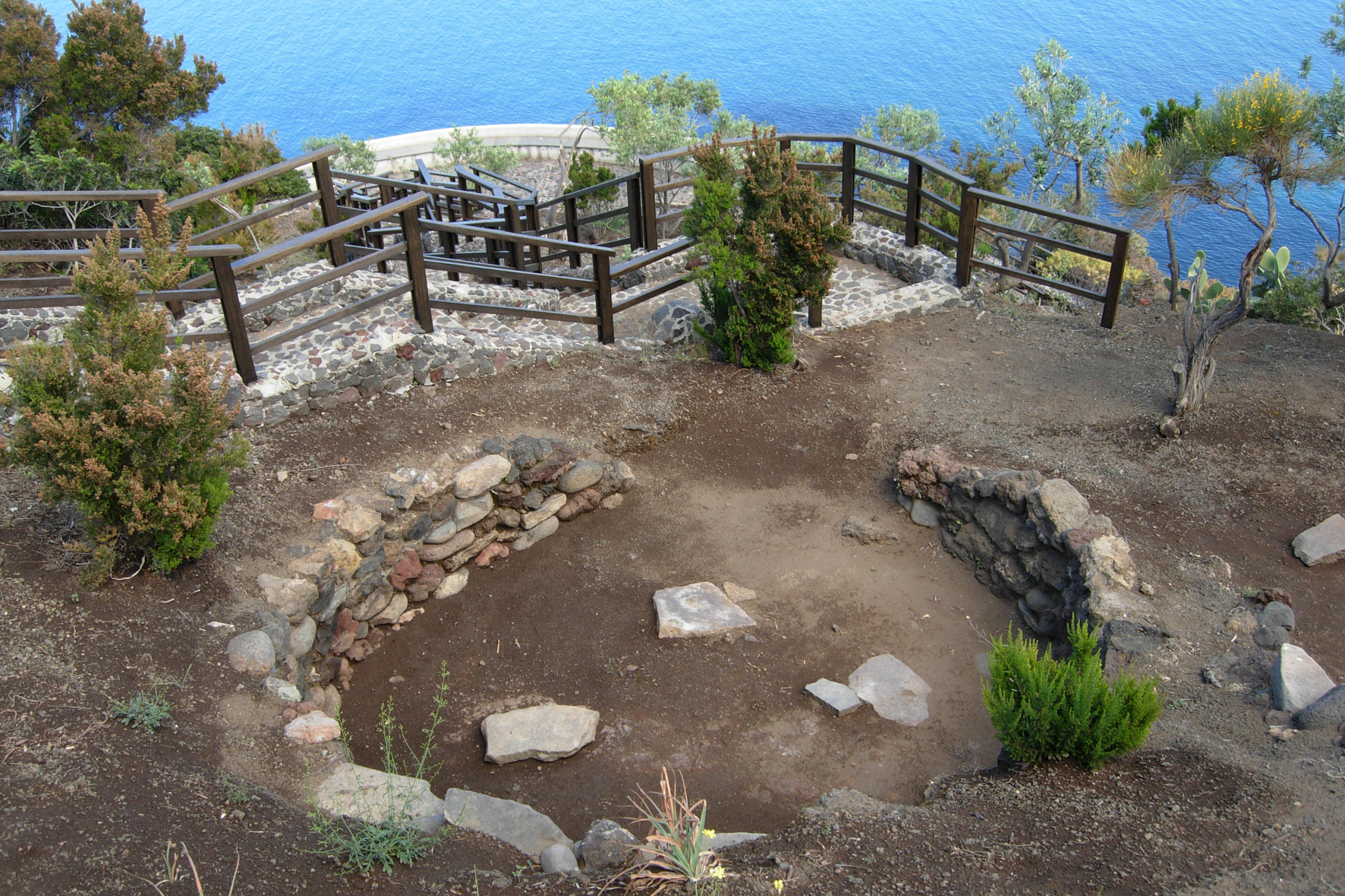
The Middle Bronze age village of Portella in the Salina Island (Martinelli excavation, 2000).
Between 1999 and 2008 M.C. Martinelli conducted new excavations, which explored the entire preserved part of the settlement, comprising 25 huts. The excellent state of preservation made it possible to recognise structures consisting of 4-5 rooms with different functions: living, working and storage. In almost all of the huts there was, among other things, a large ceramic vessel for storing water.
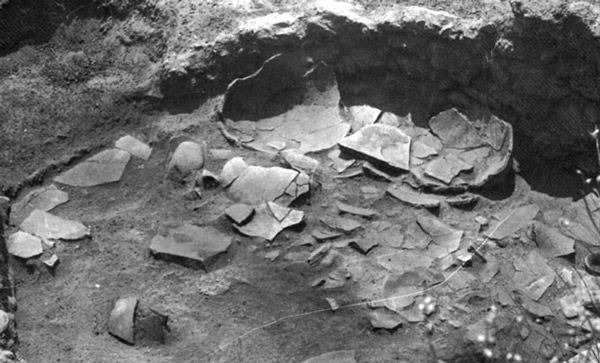
Middle Bronze Age settlement of La Portella (excavated in 1956) - Hut C
The structures of the village of Portella have been preserved in view and are part of the Archaeological Park of the Aeolian Islands.
The materials found are exhibited in the Museo Regionale Eoliano Luigi Bernabò Brea in Lipari.
Bibliografy:
- L. Bernabò Brea M. Cavalier, Meligunìs Lipàra III, 1968, pp. 144-180.
- M.C. Martinelli, (a cura di) Il villaggio dell'età del bronzo medio di Portella a Salina nelle Isole Eolie, con testi di: A.M. Bietti Sestieri, G. Calderoni, C. Ferlito, G. Fiorentino, R. E. Jones, S.T. Levi, P. Lo Cascio, L. Lopes, I. Martelli, R. Mazzarella; Origines. Studi e materiali pubblicati a cura dell'Istituto Italiano di Preistoria e Protostoria, Firenze, 2005, pp. 1-339.
- M.C. Martinelli, Archeologia delle Isole Eolie. Il villaggio dell’età del Bronzo medio di Portella a Salina. Scavi 2006 e 2008. Rebus Edizioni, Milano, 2010.
- M.C. Martinelli, Isole vicine. L’arcipelago delle Isole Eolie e le comunità umane nella preistoria mediterranea. Edizioni di Storia e studi sociali di Giovanna Corradini, Ragusa, 2020.
Panarea.
The village
of Punta Milazzese
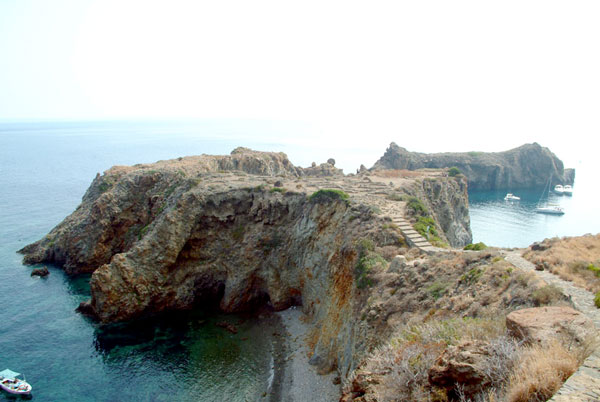
The promontory of Milazzese with the village of the middle Bronze Age
The excavation of the prehistoric village of Milazzese on the island of Panarea was the first to be conducted by Luigi Bernabò Brea in the Aeolian Bronze Age villages, in 1949-1950.
The village is situated on the rocky promontory of Punta Milazzese, formed by three successive rocky summits with a flat surface and almost vertical walls. Stretching into the sea in a crescent shape, and joined to the island only by a narrow isthmus, the promontory is a real natural fortress. It would have been easy to defend, simply by a barrier built across the isthmus; and it is just for this reason that it was chosen as the site of the middle Bronze Age village.
Communication between the three summits of the promontory, now impossible, cannot have been so in antiquity, since the rock has since then been heavily eroded.
On the first summit, which is the largest, apart from traces of the barrier across the isthmus, the excavation revealed a complex of 21 huts delimited by drystone walls. A further two huts were excavated at the far end of the last summit.
New investigations conducted in 2008-2009, identified new huts and revealed the access structure to the village, which included a square tower (Martinelli 2020, pp. 123-125).
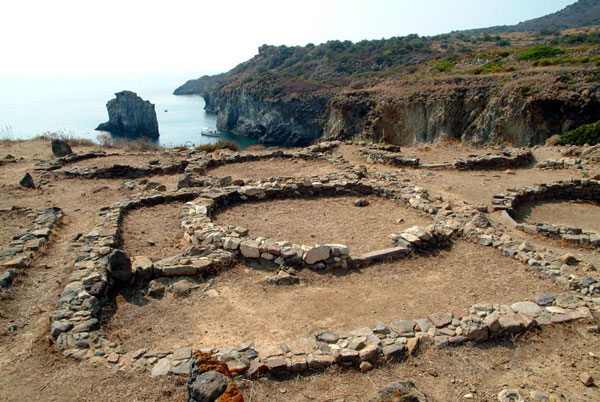
The village of Punta Milazzese. In the foreground one of the circular huts with quadrangular enclosure
The fact that pots and other objects were found in situ in many of the huts shows that the village suffered the same violent destruction that has been ascertained for all the Aeolian settlements during this period.
The material recovered characterises one of the phases of the Aeolian Bronze Age (Milazzese phase), which is dated by many imported Mycenaean objects to between the 14th and early 13th century BC.
The structures of the village have been preserved in view and are part of the Archaeological Park of the Aeolian Islands.
The materials found are exhibited in the Museo Regionale Eoliano Luigi Bernabò Brea in Lipari.
Bibliografy:
Island of Lemnos - Poliochni

Plan of the town
The prehistoric settlement of Poliochni is situated close to the seashore on the eastern coast of the island of Lemnos, overlooking a bay protected from the winds by a rocky promontory and forming a natural harbour. Like Troy and like Thermi, Poliochni can be considered a tell in the true sense: the present-day hill is essentially man-made; it is formed by the superimposition of the remains of houses that succeeded each other through many centuries, with the result that the stratigraphy of the site at some points reaches a depth of over 9 metres.
The site of the ancient city was excavated by the Scuola Archeologica Italiana in Athens from 1930 to 1936 under the direction of Alessandro Della Seta. Bernabò Brea began to work at Lemnos as a pupil of the School, and was later recalled by Doro Levi in the 1950s to resume the excavations, with the aim of verifying a series of data. He was further commissioned to establish the museum of Myrina and publish the Italian excavations on Lemnos in their entirely, with the aim of "salvaging the results of so much hard work by Italian scholars".
e completed his task with the publication of two important monographs (1962 and 1976), in which he proposed a division into periods of the long life of the city. Bernabò Brea’s periodization was based on the typological/morphological evolution of pottery and other artefacts. Not least of the results of his work was the finding of an important treasure of gold jewellery, during the campaign in 1956.
Bibliography:
- L. Bernabò Brea, Recenti scavi a Poliochni nell'isola di Lemnos, in Bollettino d'Arte del Ministero della Pubblica Istruzione, N. III-IV – Luglio Dicembre 1957, pp.193-217.
- L. Bernabò Brea, A Bronze Age House at Poliochni (Lemnos) in Proceedings of the Prehistoric Society for 1955, -Vol. XXI, pp.144-155.
- L. Bernabò Brea, Poliochni: Città preistorica nell'isola di Lemnos, Monografie della Scuola Archeologica di Atene e delle Missioni Italiane in Oriente, I, Roma,1962. Vol. I A (testo) pp. 1-705, vol. I B (tavole) tavv. I –CXC, e Atlante,tavv. 1-26.
- L. Bernabò Brea, Poliochni. Città preistorica nell'isola di Lemnos, Monografie della Scuola Archeologica di Atene e delle Missioni Italiane in Oriente, II, Roma, 1976.
- Chr. Doumas, V. La Rosa, a cura di, Poliochni e l'antica età del bronzo nell'Egeo settentrionale, Convegno Internzionale, Atene 22-25 Aprile, 1996; Scuola Archeologica di Atene, Atene 1997, pp. 1-691.
Download monographs
Download articles
- L. Bernabò Brea, Menadi Tarentine, Lekythos apula del Museo di Genova, 1941.
- L. Bernabò Brea, Di una stazione all'aperto nei pressi di Rossiglione e considerazioni sull'età del Ferro in Liguria, 1946.
- L. Bernabò Brea, Stazione di abitazione dell'età del Ferro nel Novarese, 1947.
- L. Bernabò Brea, Rinvenimenti nella Sicilia Orientale , 1947.
- L. Bernabò Brea, La Cueva Corruggi en el Territorio de Pachino, 1949.
- L. Bernabò Brea, Yacimientos paleoliticos del Sudeste de Sicilia, 1950.
- L. Bernabò Brea, Segni grafici e contrassegni sulle ceramiche dell'età del Bronzo delle Isole Eolie, 1952.
- L. Bernabò Brea, Civiltà preistoriche delle isole Eolie, 1952.
- L. Bernabò Brea, I rilievi tarantini in pietra tenera, 1952.
- L. Bernabò Brea, La Sicilia Prehistorica y sus relaciones con Oriente y con la Peninsula Iberica, 1954.
- L. Bernabò Brea, M. Cavalier, Civiltà preistoriche delle Isole Eolie e del territorio di Milazzo, 1956.
- L. Bernabò Brea, M. Cavalier, Stazioni preistoriche delle Isole Eolie, 1957.
- L. Bernabò Brea, Palikè. Giacimento paleolitico e abitato neolitico ed eneo, 1965.
- L. Bernabò Brea, Segnalazioni di rinvenimenti paleolitici in Sicilia, 1965.
- L. Bernabò Brea, Leggenda e Archeologia nella protostoria siciliana, 1965.
- L. Bernabò Brea, M. Cavalier, Ricerche paletnologiche nell'isola di Filicudi, 1966.
- L. Bernabò Brea, La necropoli di Longane, 1967.
- L. Bernabò Brea, Prefazione a E.Militello - S. La Piana, Mineo (Catania) La necropoli detta del Molino della Badia, 1969.
- L. Bernabò Brea, Xuthia e Hybla e la formazione della facies culturale di Cassibile, 1971.
- L. Bernabò Brea, L'età del Bronzo tardo e finale nelle isole Eolie, 1979.
- L. Bernabò Brea, Ricordi Acrensi, 1983.
- L. Bernabò Brea, M. Cavalier, Archeologia subacquea nelle Isole Eolie, 1985.
- L. Bernabò Brea, M. Cavalier, C. Albore Livadie, G. Kapitaen, C. Van Der Mersch, Discariche di scalo e relitti nei mari eoliani: Lipari, Vulcano, Panarea, Basiluzzo, Salina, Filicudi, 1985.
- L. Bernabò Brea, E. D'Angelo, Il tempio di Afrodite nell'antica Akrai, 1985.
- L. Bernabò Brea, Voce "Cassibile", 1987.
- L. Bernabò Brea, M. Cavalier, Voce "Filicudi", 1989.
- L. Bernabò Brea, M. Cavalier, Voce "Lipari", 1991.
- L. Bernabò Brea, La Sicilia e le Isole Eolie, 1992.
- L. Bernabò Brea, M. Cavalier, Voce " Milazzo", 1992.
- L. Bernabò Brea, La prehistoria de Sicilia y de las Islas Eolias cuaranta aňos despùes, 1993.
- L. Bernabò Brea, Voce "Pantalica", 1994.
- L. Bernabò Brea, M. Cavalier, Voce "Salina", 2001.
Link

Maria Bernabò Brea
Biographical profile
Born in Genoa in 1952, she graduated in Humanities at the University of Genoa in 1975. On the staff of the Soprintendenza per i Beni Archeologici dell'Emilia-Romagna since 1980, with particular responsibility for the Prehistory of Western Emilia (Piacenza, Parma, Reggio Emilia). Since 1991 she has been Director of the Museo Archeologico Nazionale in Parma.
Retired since 1 January 2017.
Member of the Board of Directors of the Italian Institute of Prehistory and Protohistory since 2003; President from 2012 to 2017; Director of the Journal of Prehistoric Sciences since 2024.
Her main fields of research concern:
- The Neolithic: exploration of some sites in the district of Matera in the 1970s; of sites in the Val Trebbia in the 1980s; of VBQ sites and cemeteries in Emilia (1995-2007) in collaboration with Loretana Salvadei from 1995 to 2007; and of the recently discovered Neolithic site of S. Andrea at Travo (Val Trebbia), in collaboration with Alain Beeching between 1995 and 2007;
- The Bronze Age: extensive excavations in the terramara (lake settlement) di S. Rosa at Poviglio (1984-2007) in collaboration with Mauro Cremaschi; research project on Emilian terramare, in collaboration with Andrea Cardarelli, Mauro Cremaschi and Angela Mutti (1989-1997); various excavations in terramare especially in the province of Parma, including the extensive site of Beneceto (2000-2004).
She has served as curator of various museums: the Antiquarium of the terramara of Poviglio (1996), the Museo Archeologico della Media Val Trebbia and the Parco Archeologico of the site of S. Andrea at Travo (1997, 1999, 2006), the prehistoric section of the Museo Archeologico Nazionale in Parma (1999), and the prehistoric section of the Museo Civico at Piacenza in collaboration with A.M. Carini (1998).
Among the organized temporary exhibitions:
- Le terramare si scavano per concimare i prati (Parma, 1994);
- Le terramare. Prima civiltà padana in collaborazione con A. Cardarelli e M. Cremaschi (Modena 1997)
- Antichi segni dell’uomo, in collaborazione con A. Revedin (Firenze, Museo Archeologico, 2004).
Co-Organization of the Conferences:
- XXXV Riunione Scientifica dell’Istituto Italiano di Preistoria e Protostoria - Le comunità della preistoria italiana. Studi e ricerche sul Neolitico e le età dei metalli, Lipari, 2-7 giugno 2000.
- Archeolologia ad Alta velocità, Parma, 9 giugno 2003.
- XXXIX Riunione Scientifica dell’Istituto Italiano di Preistoria e Protostoria - Materie prime e scambi nella preistoria italiana, Firenze, 25-27 novembre 2004.
- 5000-4300 a.C. Il pieno sviluppo del Neolitico in Italia, Finale Ligure, 8-10 giugno 2009.
- VL Riunione Scientifica dell’Istituto Italiano di Preistoria e Protostoria - Preistoria e Protostoria dell’ Emilia Romagna, Modena, 26-31 ottobre 2010.
- L Riunione Scientifica dell’Istituto Italiano di Preistoria e Protostoria - Preistoria del cibo, Roma ottobre 2015.
- LI Riunione Scientifica dell’Istituto Italiano di Preistoria e Protostoria - Italia tra mediterraneo ed Europa, Forlì ottobre 2016.
Bibliography
in chronological order
- Bernabò Brea M.,1977, Nuovi scavi nei villaggi di Serrra d'Alto e Tirlecchia, Atti XX Riun. Scient. IIPP in Basilicata, pp. 147-158.
- Bernabò Brea M.,1977, La ceramica graffita materana, in Le ceramiche graffite nel neolitico del Mediterraneo centro-occidentale, Atti del seminario di Genova, "Preistoria Alpina", 13, pp. 28-31.
- Tinè S., Bernabò Brea M., 1980, Il villaggio neolitico del Guadone di S.Severo (Foggia), Riv. Sc. Preist. XXXV, pp. 45-74.
Cremaschi M., Bernabò Brea M., Tirabassi J., D'Agostini A., Dall'Aglio
P.L., Magri S., Baricchi W., Marchesini A., Nepoti S., 1980, L'evoluzione della pianura emiliana durante l'età del bronzo, l'età romana e l'alto medio evo: geomorfologia ed insediamenti, in "Padusa", pp. 1-106 (estratto).
- Bernabò Brea M., Bonardi A., 1982, Nota preliminare sul rinvenimento di materiale dell'età del Bronzo a Torrechiara (Parma), "Preistoria Alpina", 18, pp.157-162.
- Bernabò Brea M., Steffè G., 1983, Insediamento neolitico a Savignano sul Panaro: appunti preliminari, Miscellanea di Studi Archeologici e di Antichità, Deput. St.Patria Provv. Modenesi, n.s., 72, pp. 1-8 estratto.
- Bernabò Brea M., 1984, L'insediamento neolitico di Tirlecchia (Matera), Riv. Sc. Preist. XXXIX, pp. 23- 84.
- Bernabò Brea M., 1984, Insediamento neolitico a Travo (Piacenza), in "Emilia Preromana", 9/10, pp. 287-288.
- Bernabò Brea M., Cattani M., Conversi R., Cremaschi M., Nisbet R., Ricci C., 1984, L'insediamento neolitico della Cassa di Risparmio a Travo, in Preistoria Alpina 20, pp. 59-80.
- Bernabò Brea M., 1986, Ricerche sugli insediamenti neolitici della media Val Trebbia, in Atti del Convegno Prospettive storico-antropologiche in Archeologia Preistorica, Roma 1986 Dialoghi di Archeologia, 2, pp. 173-177.
- Bernabò Brea M., 1986, La preistoria, in AA.VV., Momenti storici della Val Tolla, Piacenza, pp. 13-22.
- Bernabò Brea M., 1986, L'insediamento neolitico di Travo, Rivista di Storia Naturale, 1, pp. 21-34.
- Bernabò Brea M., Cattani M., Piana A.M., 1986, Siti neolitici della media Val trebbia (PC) in Preistoria Alpina 22, pp. 25-34.
- Bernabò Brea M., Cremaschi M., 1986, Insediamento terramaricolo di S.Rosa, in "Studi e Documenti di Archeologia, II, pp. 131-133.
- Bernabò Brea M.,1987, Il popolamento neolitico della Val Trebbia, in Atti XXVI Riunione Scientifica IIPP a Firenze, pp. 563-573.
- Bernabò Brea M.,1987, Appunti per una storia del territorio. Archeologia a Poviglio, Catalogo della mostra, Reggio Emilia.
- Bernabò Brea M., 1987, Saggio di scavo in un sito neolitico a S.Andrea di Travo (PC), Rivista di Storia Naturale, 2, pp. 25-43.
- Bernabò Brea M. (a cura di), 1987, Archeologia a Poviglio: Appunti per una storia del territorio, Catalogo della mostra a Poviglio, Reggio Emilia.
- Bernabò Brea M., Cardarelli A., Cremaschi M., 1987, Le Terramare dell'area centropadana: problemi culturali e paleoambientali, in « Preistoria e Protostoria nel bacino del basso Po », Atti del Convegno di Ferrara 1984, pp. 147-192.
- Bernabò Brea M., Cremaschi M., 1987, La terramara di Santa Rosa a Poviglio (RE), in G. Bermond Montanari (a cura di), La formazione della città in Emilia Romagna, Catalogo della mostra, Bologna, pp. 6-10.
- Accorsi C., Bernabò Brea M., Cremaschi M., Ferrari A., Scarpa G., Steffè G., 1987, Les communautés paysannes dans la vallée du Panaro pendant le V e IV millenaire a.J.C., in "Premières Communautés Paysanne en Méditerranée Occidentale", Atti del Convegno, Montpellier, pp. 451-469.
- Bernabò Brea M.,1988, Il territorio di Bondeno nel quadro dell'età del Bronzo emiliana, in F.Berti, S.Gelichi, G.Steffè (a cura di), Bondeno e il suo territorio dalle origini al Rinascimeno, pp. 89-102.
- Bernabò Brea M., Catarsi M., Dall'Aglio P.L.1988, L'Eneolitico nel territorio parmense e piacentino, in L'età del rame in Europa, Convegno di Viareggio 1987, "Rassegna di Archeologia", 7, p. 616.
- Bernabò Brea M., Steffè G., 1988, Savignano sul Panaro: l'insediamento del Neolitico antico, in Cardarelli A. (a cura di), Modena dalle origini all'anno Mille, catalogo della mostra, Modena, pp. 171-175.
- Bernabò Brea M., 1989, La terramara di Quingento nell'ambito dell'età del bronzo media e recente, in Quingento di S.Prospero fra II e I millennio a.C., Parma, pp. 29-40.
- Bernabò Brea M., Aleotti G.B., 1989, Il materiale proveniente da recenti ricerche di superficie nella terramara di Quingento, in Quingento di S.Prospero fra II e I millennio a.C., Parma, pp. 41-80.
- Bernabò Brea M., Bottazzi G., Bronconi L., Mutti A., 1989, Recenti ricerche nell'insediamento di Fodico di Poviglio, podere S.Rosa, in "Atti XI Conv.Arch.Benacense", Cavriana (MN) 1986, pp.255-311.
- Bernabò Brea M., Bruzzi G., Catarsi dall'Aglio M., 1989, Esempi di applicazioni di metodologie geofisiche in siti preistorici, Atti XXVII Riun. Scient. IIPP a Ferrara, pp.451-458.
- Bernabò Brea M., Cremaschi M., a cura di, 1989, La terramara di Poviglio. Le campagne di scavo 1985-1989, (ed. preliminare fuori commercio in occasione del Convegno di Viareggio), Castelnovo di Sotto (RE).
- Bernabò Brea M., 1990, Poviglio (Reggio Emilia), località Fodico, in Scavi e Scoperte, Bollettino di Archeologia, 5/6, Agosto-Dicembre 1990, pp. 126-130.
- Bernabò Brea M., Cremaschi M., Bronzoni L., Mutti A., 1990, Le indagini 1983-84 nella terramara S.Rosa a Fodico di Poviglio (RE), Padusa, XXV, pp.69-172.
- Bernabò Brea M., Ghiretti A., Polglase C., Visconti V., 1990, I siti neolitici lungo il torrente Cinghio (Parma), Preistoria Alpina, 24, pp. 103-164.
- Bernabò Brea M., Steffè G., Giusberti G., 1990, Il Neolitico antico a Savignano, in Nel segno dell'elefante. Geologia, Paleontologia e archeologia nel territorio di Savignano sul Panaro, Savignano s.P., pp. 77-134.
- Carini Sprocato A.M., Bernabò Brea M., 1990, Preistoria e Protostoria del Piacentino, in Piacenza nella Storia dalle origini al XX secolo, Piacenza, pp. 17-58.
- Bernabò Brea M., Steffè G., 1990, Il Nolitico antico a Savignano, in AA.VV., Nel segno dell'elefante, Savignano s. Panaro, pp. 77-134.
- Bernabò Brea M.,1991, La Val Trebbia dal Paleolitico all'età del Ferro, Bobbio.
- Bernabò Brea M., 1992, I primi agricoltori, guida breve della mostra di Parma, Piacenza e Bobbio, Piacenza.
-
Bernabò Brea M., Cardarelli A., Mutti A.,Bresciani R., Bronzoni L,
Catarsi M., Desantis P., Labate D., Macellari R, Morico G., Serges A.,
Tirabassi J., Zanasi C., 1992, Ambiti culturali e facies
archeologiche delle terramare emiliane in base alla revisione dei
vecchi complessi e ai nuovi dati di scavo, in « L'età del Bronzo in Italia nei secoli dal XVI al XIV a.C. », "Rassegna di Archeologia" 10, pp.341-373.
- Bernabò Brea M., Ghiretti A., 1992, Il popolamento dell'Appennino emiliano occidentale nell'età del bronzo media e recente, in « L'età del Bronzo in Italia nei secoli dal XVI al XIV a.C. », "Rassegna di Archeologia" 10, pp. 662-663.
- Bernabò Brea M., Tirabassi J., 1992, L'età del bronzo media nella stratigrafia di Cavazzoli in « L'età del Bronzo in Italia nei secoli dal XVI al XIV a.C. », Rassegna di Archeologia 10, pp.650-651.
- Bernabò Brea M., Catarsi Dall'Aglio M., Saronio P., Cesaretti M.P., Tarasconi C., 1992, Il Museo, le collezioni, le ricerche, l'interesse per l'archeologia in epoca ludoviciana, in Maria Luigia donna e sovrana. Una corte europea a Parma 1815-1847, Catalogo della mostra, Parma, pp. 80-90.
- Bernabò Brea M., Cremaschi M., 1992, Les terramares dans la plaine du Po, Actes du Colloque "L'habitat et l'occupation du sol à l'age du bronze en Europe", Lons -le-Saunier (France), pp. 407-417.
- Cardarelli A., Bernabò Brea M., 1992, Organizzazione sociale sulla base delle evidenze insediative e funerarie,. L'Italia settentrionale, Rassegna di Archeologia 10, pp. 257-264.
- Bernabò Brea M., Ghiretti A., 1993, L'insediamento dell'età del Bronzo al Groppo Predellara (Rocca Vecchia di Varsi), Archivio Storico per le Province Parmensi, XLIV, pp.175-183.
- Bernabò Brea M., Fornari C., 1993, Aeroporto di Parma. Rinvenimento di una struttura eneolitica, Studi e Documenti di Archeologia, VIII, pp. 308-309.
- Bernabò Brea M., Cattani M., Farello P., 1994, Una struttura insediativa del Neolitico superiore a S.Andrea di Travo (PC), Quaderni del Museo Archeologico Etnologico di Modena, I, pp. 55-87.
- Bernabò Brea M., Mutti A. (a cura di), 1994, Le terremare si scavano per concimare i prati, Catalogo della mostra tenuta a Parma, ed. Silva, Parma.
- La nuova scienza alla ricerca delle origini, pp. 13-20
- Le terremare, queste sconosciute: alla ricerca del tempo perduto, pp. 245-251.
- La vicenda delle terremare, a firma Bernabò Brea, Mutti, pp. 150-165.
- Schede alle pp.: 263-266, 267, 269, 289, 291, 320, 354, 358, 387, 389, 402, 420.
- Bernabò Brea M.,1995, La necropoli di Bismantova, in S.Farri (ed.) Bismantova, Parma, pp. 45-62.
- Bernabò Brea M., Cremaschi M., 1995, L'indagine archeologica nelle terramare: gli scavi 1991-1993 nel villaggio grande di S.Rosa a Poviglio (RE), Atti del Simposio " Modelli insediativi tra Alpi e Mar Nero dal V al II mill.a.C. ", Verona-Lazise, pp.309-323.
- Bernabò Brea M., 1996, Il Museo Archeologico Nazionale di Parma, in
Guide Archeologiche, Preistoria e Protostoria in Italia, 3. Emilia
Romagna, (libro guida per il Congresso UISPP 1996), pp. 235-236.
- Bernabò Brea M., Carini A.M., 1996, I pugnali di Castelsangiovanni (PC), in L' Antica età del Bronzo in Italia, Atti del Convegno di Viareggio, pp. 558-559.
- Bernabò Brea M. , Cremaschi M.,1996, Poviglio, terramara S.Rosa a Fodico,
in Guide Archeologiche, Preistoria e Protostoria in Italia, 3. Emilia
Romagna, (libro guida per il Congresso UISPP 1996), pp. 227-228.
- Bernabò Brea M. , Cremaschi M., 1996, Tredici anni di ricerche nella terramara S.Rosa a Fodico di Poviglio (RE), Pagine d'Archeologia, 3, pp.1-47.
- Bernabò Brea M., D'Amico C., Ghedini M., Ghiretti A., Occhi S., 1996, Gaione, loc. Case Catena, in M.Venturino (a cura di), Le vie della Pietra Verd", Catalogo della Mostra, Torino, pp.122-136.
- Bernabò Brea M., 1997, Die Terramaren in der Poebene, in Pfahlbauten rund um die Alpen, Archaologie in Deutschland, Sonderheft 1997, pp. 63-70.
- Bernabò Brea M., 1997, Voce "Terramaricola, civiltà", in Enciclopedia dell'Arte Antica, secondo supplemento, 1971-1994, vol. Vpp. 738-739.
- Bernabò Brea M., Cardarelli A., Cremaschi M. (a cura di), 1997, Le Terramare. La prima civiltà padana, Catalogo della mostra di Modena, ed. Electa, Bologna. Nel catalogo ha scritto i seguenti testi:
- Terramare. Cinque secoli di vita nella grande pianura (insieme a A.Cardarelli e Cremaschi M.) pp. 23-29.
- Le terramare "palafitte a secco" o "villaggi arginati" ? (insieme a Cremaschi M.) pp. 187-195.
- La terramara di S.Rosa di Poviglio: le strutture (insieme a Cremaschi M.) pp. 196-212.
- L'insediamento collinare e montano (insieme a A.Cardarelli e Cremaschi M.) pp. 275-281.
- Le terramare nel tempo (insieme a A.Cardarelli) pp. 295-301.
- Lo strato basale del villaggio piccolo di S.Rosa a Fodico di Poviglio (RE) (con altri Autori), pp. 340-342
- Lo strato a cumuli di cenere del villaggio grande di S.Rosa a Fodico di Poviglio (RE) (con altri Autori), pp. 345-347
- Lo strato sommitale del villaggio grande di S.Rosa a Fodico di Poviglio (RE) (con altri Autori), pp. 347-350.
- Datazioni radiometriche dalla terramara S.Rosa di Poviglio ( insieme a M. Cremaschi), p. 350.
- La stratigrafia di Cavazzoli (RE) negli scavi 1971( insieme a J Tirabassi) pp. 351-353
- Il limite sud-occidentale dell'area terramaricola e le facies culturali dell'Appennino emiliano occidentale. pp. 433- 435.
- Il sito della Piscina di Travo: 436-437.
- Il crollo del sistema terramaricolo (insieme a A.Cardarelli e Cremaschi M.) pp. 745-756.
- Bernabò Brea M., Bronzoni L., Ferrari P., Fornari C., 1997, Chiaravalle della Colomba, in Archeologia dell'Emilia Romagna, I,2, pp. 13-14.
- Bernabò Brea M., Castagna D., Occhi S., 1997, Travo, loc. S. Andrea, in Archeologia dell'Emilia Romagna, I, 2, pp. 15-16.
- Bernabò Brea M., Cremaschi M.., 1997, Poviglio, Terramara S.Rosa a Fodico, in Archeologia dell'Emilia Romagna, I,2, pp. 18-20.
- Bernabò Brea M., Mazzieri P., Ottomano C., 1997, Fidenza, loc. Ponte Ghiara, in Archeologia dell'Emilia Romagna, I,2, pp. 15-18.
- Bernabò Brea M., 1998, I
rapporti tra l'area terramaricola ele facies occidentali nei territori
a sud del Po durante l'età del bronzo media e recente, Atti XXXII Riun. Scient. IIPP ad Alba, Preistoria e Protostoria del Piemonte, Firenze, pp. 433-441.
- Bernabò Brea M., Castagna D., Occhi S., 1998 , Travo, loc. S. Andrea, in Archeologia dell'Emilia Romagna, II, 2, pp. 15-17.
- Bernabò Brea M., Cremaschi M., 1998, Poviglio, loc. Fodico, Terramara S.Rosa, in Archeologia dell'Emilia Romagna, II, 2, pp. 17-20.
- Bernabò Brea M., Ottomano C., Negrino F., Tramontano N., 1998, Rinvenimenti preistorici a Piacenza, Area IKEA, in "Archeologia dell'Emilia Romagna", pp. 11-15.
- Bernabò Brea M., Rast-Eicher A., 1998, Un frammento di tessuto dell'età del bronzo da Castione dei Marchesi (PR), in Archeologia dell'Emilia Romagna, II, 2, pp. 213-216.
- Bagolini B., Bernabò Brea M. 1999, Faciès culturels et structures d'habitat du Néolithique de l'Italie septentrionale: les recherches dans l'Emilie occidentale,
in J.Vaquer, a cura di, Le Néolithique du nord-ouest méditerranéen,
XXIV Congrès Préhistorique de France, Carcassonne 26-30 settembre
1994, Joué-Les-Tours, 1999, pp. 89-98.
- Bernabò Brea M., Bronzoni L., Cremaschi M., Costa S., 1999, Gli scavi nella terramara Santa Rosa a Fodico di Poviglio. Guida all'esposizione. Castelnovo di Sotto (RE).
- Bernabò Brea M., Castagna D., Occhi S., 1999, L'insediamento del Neolitico superiore a S. Andrea di Travo (PC), Padusa XXXIV, pp. 7-54.
- Bernabò Brea M., Battiston C., Mazzieri P., Ottomano C., 2000, Un gruppo di figurine fittili dal sito di Ponte Ghiara , in Pessina A., Muscio G., a cura di, La neolitizzazione tra Oriente e Occidente, Atti del Convegno di Udine 1999, Udine, pp. 269-287.
- Bernabò Brea M., Castagna D., Occhi S., 2000, Le strutture dell'abitato del Neolitico superiore a S. Andrea di Travo (PC), inA. Pessina, G. Muscio (a cura di) La neolitizzazione tra Oriente e Occidente, Atti del Convegno di Udine 1999, pp. 257-268.
-
Bernabò Brea M., D'Amico C., Ghedini M., Mazzieri P:, 2000, La pietra
verde di Ponte GHiara, Fidenza (PR), Miner. Petrogr. Acta, XLIII, pp.
233-243.
- Bernabò Brea M., 2002, Le indagini archeologiche in corso nei siti preistorici della provincia di Parma, Acta Naturalia de L'Ateneo Parmense, 38, 4, pp. 133-137.
- Cavalier M., Bernabò Brea M., a cura di, 2002, In memoria di Luigi Bernabò Brea, Palermo.
- Bernabò Brea M., Bianchi P., Lincetto S., 2003, La
produzione tessile nell'età del Bronzo. Fusaiole e pesi da telaio nelle
terramare emiliane: esempi di studio dai villaggi di S. Rosa di
Poviglio (RE) e Forno del Gallo a Beneceto (PR), in Bazzanella M.,
Mayr A., Moser L., Rast-Eicher A., a cura di, Textiles. Intrecci e
tessuti dalla preistoria europea, Catalogo della mostra di Trento, pp.
111-120.
- Bernabò Brea M., Carini A., 2003, Piacenza 6500 anni fa. La necropoli neolitica a Le Mose, quaderno della mostra, Piacenza.
- Bernabò Brea M., Castagna D., Occhi S., 2003 , Le strutture dell'abitato Chassey-Lagozza a S. Andrea di Travo, in Le comunità della preistoria italiana. Studi e ricerche sul neolitico e sulle età dei metalli, Atti XXXV Riunione Scientifica IIPP a Lipari, 2000, pp. 785-789.
- Bernabò Brea M., Cremaschi M., 2003 , Il villaggio piccolo nella terramara S. Rosa di. Poviglio (RE): le strutture abitative, in Le comunità della preistoria italiana. Studi e ricerche sul neolitico e sulle età dei metalli, Atti XXXV Riunione Scientifica IIPP a Lipari, 2000, pp.
- Bernabò Brea M., Cremaschi M., Pizzi C., 2003, Le strutture abitative del Villaggio Grande – fase su palafitta - della terramara di S. Rosa di Poviglio, in Peretto C., a cura di, Analisi informatizzata e trattamento dati delle strutture di abitato di età preistorica e protostoria in Italia, Origines, Firenze, pp. 271-285.
- Bernabò Brea M., Cremona M.G., Fenu P., Maffi M., Occhi S., Pizzaiolo G., Viti S., 2003, L'insediamento
del neolitico superiore di S. Andrea a Travo: analisi informatizzata
delle strutture e della distribuzione dei materiali, in Peretto C., a cura di, Analisi informatizzata e trattamento dati delle strutture di abitato di età preistorica e protostoria in Italia, Origines, Firenze, pp. 203-215.
- Barfield L.H., Bernabò Brea M., Maggi R., Pedrotti A.L., 2003, Processi di cambiamento culturale nel neolitico dell'Italia settentrionale, in Le comunità della preistoria italiana. Studi e ricerche sul neolitico e sulle età dei metalli, Atti XXXV Riunione Scientifica IIPP a Lipari, 2000, pp. 665-685.
- Bernabò Brea M., 2004, La valle Trebbia dal Neolitico all'età del Bronzo, in Venturino Gambari M. (a cura di), Alla conquista dell'Appennino, Le prime comunità delle valli Curone, Grue e Ossona, Torino, pp. 95-114.
- Bernabò Brea M., 2004, Il Bronzo Medio-Recente nell'Appennino emiliano occidentale, in de Marinis R.C., Spadea G., a cura di, I Liguri. Un antico popolo europeo tra Alpi e Mediterraneo, Catalogo della mostra di Genova, pp. 131-133.
- Bernabò Brea M., 2004, Pugnale a manico fuso; Rasoio finestrato tipo Castellaro di Gottolengo; Quattro montanti laterali di morsi per cavallo, in Marzatico F., Gleirscher P., a cura di, Guerrieri, Principi ed Eroi fra il Danubio e il Po dalla Preistoria all'Alto Medioevo, Catalogo della mostra di Trento, pp. 569; 579-580; 599-600;
Bernabò Brea M., Cremaschi M., a cura di, 2004, Il villaggio piccolo della terramara di S. Rosa di. Poviglio. Scavi 1987-1992, Origines, Firenze.
- Bernabò Brea M., Cremaschi M., 2004, La terramara di S. Rosa a Poviglio (Reggio Emilia) nel corso del Bronzo Recente in Cocchi Genick D. (a cura di), L'età del Bronzo Recente in Italia, Atti del congresso di Lido di Camaiore, 2000, Viareggio, pp. 101-110.
- Bernabò Brea M., Ghiretti A., 2004, Strategie insediative nell'Appennino emiliano, in de Marinis R.C., Spadea G., a cura di, I Liguri. Un antico popolo europeo tra Alpi e Mediterraneo, Catalogo della mostra di Genova, pp. 69-73.
- Bernabò Brea M., Miari M., 2004, Preistoria e Protostoria del Piacentino, in Passeggiate Archeologiche Piacentine, Guide Belvedere, ed. Diabasis, pp.
- Bernabò Brea M., Revedin A., 2004, Antichi segni dell'uomo, Guida alla mostra di Firenze, Firenze.
- Visentini P., Bernabò Brea M., Kromer B., Fasani L., Salzani L. Salzani P.,Talamo S., 2004, Preliminari
considerazioni sulle ultime fasi del neolitico dell'Italia
settentrionale alla luce dei recenti ritrovamenti e delle nuove
datazioni assolute, Bollettino del Museo di Storia Naturale di Verona, 28, pp. 133-146.
- Bernabò Brea M., Maffi M., Ferrari E., Guarisco F., 2005, Preistoria a Piacenza: I siti mesolitici e neolitici di Le Mose, Bollettino Storico Piacentino, C, pp. 11-52.
-
Bernabò Brea M., Miari M., Bianchi P., Bronzoni L., Ferrari P.,
Guarisco F., Lari E., Lincetto S., Maggioni S., Occhi S., Sassi B. 2005, Le prime fasi del sito dell'età del Bronzo di Forno del Gallo a Beneceto (Parma), Padusa, XL, pp. 81-115.
- Miari M.,Bernabò Brea M., Maffi M., Mazzieri P., 2005, L'insediamento preistorico di Vignola (Fiorenzuola, Piacenza), Bollettino Storico Piacentino, C, pp. 53-85.
- Bernabò Brea M., 2006, L'ultima scoperta: la statuina neolitica di Vicofertile, in Ligabue G., Rossi-Osmida G., Dea Madre, Milano, pp. 92-97.
- Bernabò Brea M., 2006, Una statuina femminile da un contesto funerario neolitico nel parmense, R.S.P., LVI, pp. 197-202.
-
Bernabò Brea M., Albanese Procelli R.M., Bailly M., Bellintani P.,
Battelli M., Bianchi P., De Santis A., Giumlia-Mair A., Levi S.T., Lo
Schiavo F., Maggi R., Martinelli M.C., Pacciarelli M., Pétrequin P.,
Schiappelli A., 2006, Organizzazione della produzione e modalità dello scambio dal Neolitico al Bronzo finale, Atti XXXIX Riunione Scientifica IIPP a Firenze, 2004, pp. 75-108.
- Bernabò Brea M., Miari M., Bianchi P., Ghiretti A., Micheli R., Tirabassi J., 2006, Manufatti litici d'adorno in Emilia tra Neolitico ed età del Bronzo: tipologia, tecnologia e distribuzione, Atti XXXIX Riunione Scientifica IIPP a Firenze, 2004, pp. 697-712.
- Bernabò Brea M., 2007, Una statuina neolitica da una sepoltura VBQ a Vicofertile (Parma), Origini, n.s. IV, XXVIII, pp. 37-47.
- Bernabò Brea M., Liseno M.G., Mazzieri P., 2007, Il Primo Neolitico del Parmense,
in Preistoria dell'Italia settentrionale. Studi in ricordo di
Bernardino Bagolini, Atti del Convegno, Udine, 2005, pp. 407-418.
- Bernabò Brea M., Salvadei L., Maffi M., Mazzieri P., Mutti A., Sandias M., 2007, Le necropoli VBQ dell'Emilia occidentale: rapporti con gli abitati, rituali, corredi, dati antropologici, in Preistoria dell'Italia settentrionale. Studi in ricordo di Bernardino Bagolini, Atti del Convegno, pp. 169-186.
- Bernabò Brea M., Salvadei L., Maffi M., Mazzieri P., Sandias M., 2007, Les
sépultures du Néolithique moyen de l'Emilie occidentale: rituels,
rapports avec les habitats, données anthropologiques, Actes du Colloque « Les cistes de Chamblandes et la place des coffres dans les pratiques funéraires du Néolithique moyen occidental », Losanna, 12-13 maggio 2006, pp. 325-335.
- Miari M., Bernabò Brea M., Maffi M., Mazzieri P., 2007, L'insediamento tardoneolitico di Fiorenzuola, loc. Vignola (Piacenza), in Preistoria dell'Italia settentrionale. Studi in ricordo di Bernardino Bagolini, Atti del Convegno, Udine, 2005, pp. 529-534.
- Mantini S., Marini M., Del Monte S., Mazza D., Primicerio P., Bernabo Brea M., Salvadei L., cds, Early Dentistry Practice in Italian Neolitic site of Gaione (Parma), Journal of Anthropological Sciences.
- Bernabò Brea M., Bronzoni L., Cremaschi M., Trombino L., Valsecchi V., 2008, Lo scavo estensivo nel sito neolitico di Razza di Campegine (RE), Atti Convegno - Archeologia ad Alta Velocità, Parma, 9 giugno 2003, Quaderni di Archeologia dell’Emilia Romagna, 22, Edizioni del Giglio, Firenze, pp. 41-86.
- Bernabò Brea M., Miari M., Bianchi P., Bronzoni L., Ferrari
P.,
Guarisco F., Lari E., Lincetto S., Maggioni S., Occhi S., Sassi B.,
2008, La Terramara di Forno del Gallo a Beneceto (Parma), Atti Convegno
“Archeologia ad Alta Velocità”, Parma, 9 giugno 2003, Quaderni di
Archeologia dell’Emilia Romagna , 22, Edizioni del Giglio, Firenze, pp.
87-112.
- Bernabò Brea M., 2008, L’età del Bronzo tra i corsi del
Parma e dell’Enza, in Una storia in Comune, Atti della giornata di
studio (9.11.2006, Sorbolo), Parma, pp. 95-112.
- Bernabò Brea M., 2009, Parma tra il VI e il II millennio prima
di Cristo, in D. Vera, a cura di, Parma romana, Ed. MUP, Parma, pp.
43-109.
- Bernabò Brea M., Cremaschi M., a cura di, 2009, Acqua e
civiltà nelle terramare. La vasca votiva di Noceto, Ed. Skirà, Milano.
Nel volume:
- Le terramare nell’età del Bronzo, pp. 5-16;
- Oggetti miniaturistici e altri reperti fittili (con altri Autori), pp. 206-211;
- Conclusioni (con M. Cremaschi), pp. 242-244.
- Beeching A., Bernabò Brea M., Castagna D., 2009, Le village de Travo
près de Piacenza (Emilie-Romagne, Italie) et les structures d’habitat
du Néolithique d’Italie septentrionale, Actes Table Ronde 23-24 mai
2003 à Marseille, Mémoire XLVIII Soc. Préhist. Franc., pp. 123-141
- Bernabò Brea M., Mazzieri P., 2009, Oggetti e contesti rituali nella cultura VBQ dell’Emilia occidentale, Padusa XLIV, pp. 7-41.
- Bernabò Brea M., Mazzieri P., Micheli R., 2010, People, dogs
and wild game: evidence of the human-animal relation from burials of
the Middle Neolithic of Northern Italy, XXVI Neolithic Seminar,
Ljubljana 2009, Ljubljana, pp. 125-145.
- Bernabò Brea M., Maffi M., Mantini S., Mazzieri P., Salvadei
L., 2010, Testimonianze funerarie della gente dei Vasi a Bocca Quadrata
in Emilia occidentale. Archeologia e antropologia, Rivista di Scienze
Preistoriche, LX, 63-126.
- Bernabò Brea M., Bianchi P., Bronzoni L., Mazzieri P. 2011,
Abitati dell’età del rame nel Parmense, AttiIIPP XLIII., L’età del Rame
in Italia, pp. 233-239.
- Bernabò Brea M., Maffi M. 2011, Una struttura del IV millennio
a.C. a Le Mose (Piacenza), AttiIIPP XLIII., L’età del Rame in Italia,
pp. 581-586.
- Bernabò Brea M., Maffi M., Mantini S., Mazzieri P., Salvadei
L., 2011, Le sepolture eneolitiche alle Mose, Piacenza, Atti IIPP
XLIII. L’età del Rame in Italia, pp. 703-710.
- Bronzoni L., Alfieri M., Bernabò Brea M., Mazzieri P. 2011,
L’insediamento eneolitico di via Guidorossi a Parma, AttiIIPP XLIII.,
L’età del Rame in Italia, pp. 593-598.
- Bronzoni L., Alfieri M., Bernabò Brea M., Mazzieri P. 2011,
Via Guidorossi a Parma: i due edifici maggiori, AttiIIPP XLIII., L’età
del Rame in Italia, pp. 599-604.
- Bernabò Brea M., Cremaschi M., Bronzoni L., Pavia F., Rovesta
C., 2011, Soil use from the Late Chalcolithic to the Early Middle
Bronze Age in the central Po plain (northern Italy): new data from
buried soils, in Hidden Landscapes of Mediterranean Europe.
Cultural and methodological biases in pre- and protohistoric landscape
studies, a cura di van Leusen M., Pizzaiolo G., Sarti L., Proceedings
of the international meeting, Siena, May 25-27 2007, BAR International
Series, pp. 207-214.
- Bernabò Brea M., Cultraro M. 2012, La statuetta femminile di
Vicofertile (PR) nel contesto neolitico italiano e transadriatico:
confronti tipologici e significati simbolici, AttiIIPP XLII, Preistoria
Alpina 46, pp. 185-193.
- Bianchi P.A.E., Bernabò Brea M. 2012, Rappresentazioni
mobiliari zoomorfe, antropomorfe e simboliche dell'età del Bronzo.
Nuovi ritrovamenti dalle terramare emiliane, AttiIIPP XLII, Preistoria
Alpina 46, pp. 299-308.
- Mazzieri P., Bernabò Brea M., 2012, Stilemi decorativi e
significati simbolici nella decorazione vascolare VBQ, AttiIIPP XLII,
Preistoria Alpina 46, pp. 195-202.
- Bernabò Brea M., 2012, Riflessione sulla circolazione di
elementi immateriali nell’Europa neolitica, Atti del Congrés
Internacional Xarxes al Neolític – Neolithic Networks, Gavà 2-4.2.2011,
Rubricatum. Revista del Museu de Gavà, 5, pp. 487-498.
- Mazzieri P., Colombo M., Bernabò Brea M., Grifoni Cremonesi R.
2012, Contatti e scambi tra la cultura Serra d’Alto e i Vasi a Bocca
Quadrata: il caso delle ollette tipo San Martino, Atti del Congrés
Internacional Xarxes al Neolític – Neolithic Networks, Gavà 2-4.2.2011,
Rubricatum. Revista del Museu de Gavà, 5, pp. 351-362.
- Bernabò Brea M., Errera M., Mazzieri P., Occhi M., Petrequin
P. 2012, Les haches alpines dans la culture des VBQ en Emilie
occidentale: contexte, typologie, chronologie et origine des matières
premières, in Jade. Inégalités sociales et espace européen au
Néolithique: la circulation des grandes haches en jades alpines, Atti
del Convegno, Besançon 2009, pp. 822-871.
- Pizzi C., Cremaschi M., Mazzieri P., Bernabò Brea M., 2012, Il
contesto archeologico di San Pancrazio (PR). Uso del suolo e
insediamento tra Bronzo antico e Bronzo medio, Padusa, XVIII, pp. 7-40.
- Bernabò Brea M., Beeching A Maffi M., Salvadei L., 2013, Prima
dell’età del Rame: linee di continuità e di discontinuità con il
Neolitico, in De Marinis R.C., a cura di, L’età del Rame. La Pianura
Padana e le Alpi al tempo di Ötzi, Catalogo della Mostra, Brescia, pp.
503-524.
- Bernabò Brea M., Bertolotti P., Bronzoni L., Miari M. 2013,
Gli insediamenti di pianura a sud del Po, in De Marinis R.C., a cura
di, L’età del Rame. La Pianura Padana e le Alpi al tempo di Ötzi,
Catalogo della Mostra, Brescia, pp. 251-266.
- Bernabò Brea M., Mazzieri P. 2013, Nuovi dati sul Campaniforme
in Emilia, in De Marinis R.C., a c. di, L’età del Rame. La Pianura
Padana e le Alpi al tempo di Ötzi, Catalogo della Mostra, Brescia, pp.
503-524.
- Bernabò Brea M., Miari M. 2013, Oltre il grande fiume: le
necropoli dell’età del Rame in Emilia e Romagna, in De Marinis R.C., a
cura di, L’età del Rame. La pianura padana e le Alpi al tempo di Ötzi,
Catalogo della mostra, Brescia, pp. 353-374.
- Bernabò Brea M., Cremaschi M., 2013, la vasca lignea di Noceto
(PR), in De Grossi Mazzorin J., Curci A., Giacobini G., Economia e
ambiente nell’Italia padana dell’età del Bronzo, Bari, pp. 183-188.
- Bernabò Brea M., Bronzoni L., Cremaschi M., Salvadei L., 2013,
I tumuli dell’antica età del bronzo di via S. Eurosia (Parma), in De Grossi Mazzorin J., Curci A., Giacobini G., Economia e ambiente
nell’Italia padana dell’età del Bronzo, Bari, pp. 173-177.
- Bernabò Brea M., Gambari F.M., Giumlia-Mair A., 2014, Note
preliminari sulla tazza d’oro da Montecchio Emilia, in De Marinis R.C.,
a cura di, Le manifestazioni del sacro e l’età del Rame, Atti del
Convegno 23-24 maggio 2014, Brescia, pp. 321-341.
- Bernabò Brea M., Gambari F.M., Giumlia-Mair A., 2014,
Preliminary remarks on the gold cup from Montecchio Emilia, northern
Italy, in: Metalle der Macht – Frühes Gold und Silber / Metals of power
– Early gold and silver, 6. Mitteldeutscher Archäologentag vom 17 bis
19. Oktober 2013 in Halle (Saale), Herausgeber H. Meller, R. Risch und
E. Pernicka, Tagungen des Landesmuseums für Vorgeschichte Halle,
495-504.
- Bernabò Brea M., Maggi R., Manfredini A. a c. di, 2014, Il
pieno sviluppo del Neolitico in Italia. Atti del Convegno (Finale
Ligure, 8-10.6.2009), RSL LXXVII-LXXIX. Nel volume:
-
Bernabò Brea M., Maffi M., Mazzieri P., Salvadei L, Tirabassi I., Le necropoli VBQ in Emilia (con), pp. 303-313;
-
Cannavò V., Bernabò Brea M., Levi S.T., Mazzieri P., Dati
archeologici e analisi archeometrica di vasetti tipo “San Martino”
rinvenuti in Emilia, pp. 187-199.
-
Bernabò Brea M., Mazzieri P., Osservazioni sulla sfera rituale del mondo VBQ in baseai dati forniti dagli insediamenti dell’Emilia occidentale, pp. 311-318.
- Maffi M., Bernabò Brea M., Garbasi F., Simoncelli A., Smaldone
A., 2014, Il sito tardo Neolitico di Botteghino, Le Ghiaie (Parma),
Padusa, 50, pp. 33-63.
- Bernabò Brea M., 2016, Da un capo all’altro d’Europa.
Circolazione di simboli, oggetti e modelli tra VI e III millennio a.C.,
in “Eurasia”, Catalogo della mostra, Cagliari.
- Bernabò Brea M., Maffi M., Mazzieri P., 2016, Uso e significato dei monili nel V millennio a.C. in base ai dati dalle sepolture VBQ in Emilia, in “Ornarsi per
comunicare con gli uomini e con gli Dei. Gli oggetti di ornamento come
status symbol, amuleti,richiesta di protezione”;, Atti XII PPE
(12-14.9.2014)
- Bernabò Brea M., a cura di, 2017, Preistoria e Protostoria
dell’Emilia Romagna, vol. I (Modena, 26-31 ottobre 2010), in Studi di
Preistoria e Protostoria, 3, Firenze. Nel volume:
-
Bernabò Brea M., Miari M., Steffé G., Il Neolitico dell’Emilia Romagna, pp. 119-138;
-
Bernabò Brea M., Maffi M., Mazzieri P., Salvadei L., Sepolture
anomale nei contesti VBQ dell’Emilia occidentale, pp. 211-218;
-
Bernabò Brea M., Dal Santo N., Mazzieri P.,
Gli ultimi secoli del VI millennio a.C. in Emilia occidentale, pp.
183-192;
-
Bernabò Brea M., Maffi M., Mazzieri P., La
fase tardo-neolitica in Emilia centro-occidentale, pp. 257-266;
-
Bernabò Brea M., Bronzoni L., Miari M., Steffé G., Edifici eneolitici in Emilia Romagna, pp.287-294;
-
Bernabò Brea M., Mazzieri P., Salvadei L., Alfieri M., Due sepolture della cultura campaniforme in via Guidorossi a
Parma, pp. 443-448;
-
Miari M., Bernabò Brea M., Steffé G., Bertoldi F., Salvadei L., Sepolture eneolitiche in fossa dell’ Emilia Romagna,
pp.295-304;
-
Steffé G., Miari M., Bernabò Brea M., L’Eneolitico dell’Emilia Romagna, pp. 139-158.
- Bernabò Brea M., 2017, L’habitat dans son territoire, in Actes
du Colloque «Le Chasséen, des Chasséens. Retour sur une culture
nationale et ses parallèles, Sepulcres de fossa, Cortaillod, Lagozza»,
Paris 18-20 novembre 2014, pp. 285-288.
- Maffi M., Beeching A., Bernabò Brea M., 2017, Les maisons du
Néolithique récent d’Emilie, Italie. Nouvelles données et incidences
sur les mouvements culturels entre mondes centre-européen et occidental
au Vème milénaire et début du IVème millénaire av. J.-C., in Actes du
Colloque «Le Chasséen, des Chasséens. Retour sur une culture nationale
et ses parallèles, Sepulcres de fossa, Cortaillod, Lagozza», Paris
18-20 novembre 2014, pp.303-316.
- Bernabò Brea M., a cura di, 2018, Preistoria e Protostoria dell’Emilia Romagna, vol. II (Modena, 26-31ottobre 2010), in Studi di Preistoria e Protostoria,3, II. Firenze. Nel volume:
- Bernabò Brea M., Cardarelli A., Cremaschi M., L’età del Bronzo in Emilia, pp. 9-32
- Bernabò Brea M., Bronzoni L., Cremaschi M., Salvadei L., I tumuli del Bronzo Antico rinvenuti in via Sant’Eurosia a Parma, pp. 53-63.
- Bernabò Brea M., Tavolette enigmatiche da alcune terramare emiliane, pp. 415-420.
- Ferrari P., Bernabò Brea M., Bronzoni L., Basile C., Bianchi P.A.E., Guarisco F., L’area abitativa della prima fase nella terramara di Forno del Gallo a Beneceto (Parma), pp. 93-100.
- Bernabò Brea M., Maggioni S., Pavia F., La terramara della Roncina: dati preliminari da uno scavo preventivo, pp. 409-414.
- Pizzi C., Cremaschi M., Bernabò Brea M., Mazzieri M., Tracce di coltivazione e di incendio in un suolo dell’antica e media eta del Bronzo a San Pancrazio (Parma), pp. 375-382.
- Pizzi C., Bronzoni L., Bernabò Brea M., Pavia F., Un tratto di campagna strutturata dell’inizio del Bronzo medio a Parma, località Cortile San Martino, pp. 389-394.
- Beeching A., Bernabò Brea M., Bertolotti P., Bronzoni L., Maffi M., 2018, Bâtiments néolithiques et chalcolithiques dans la plaine du Pô. Questions d'architecture autour du plan quadrangulaire, in Actes des Deuxièmes Rencontres Nord-Sud de Préhistoire Récente. Habitations et habitat du Néolithique à l’âge du Bronze en France et ses marges » Dijon 19-21 novembre 2015. Dijon, pp. 269-280.
- Bernabò Brea M., Boccuccia P., Miari M. 2018, Cacciatori e guerrieri. I corredi di armati nelle sepolture neo-eneolitiche dell’Emilia Romagna, in Negroni Catacchio N. ed., Armarsi per comunicare con gli uomini e con gli Dei. Le armi come strumento di attacco e di difesa, status symbol e dono agli Dei, Atti XIII incontro di studi, Preistoria e Protostoria in Etruria. Milano, pp. 41-56.
- Beeching A., Bernabò Brea M., Bertolotti P., Bronzoni L., Maffi M., 2018, Bâtiments néolithiques et chalcolithiques dans la plaine du Pô. Questions d'architecture autour du plan quadrangulaire, in Actes des Deuxièmes Rencontres Nord-Sud de Préhistoire Récente «Habitations et habitat du Néolithique à l’âge du Bronze en France et ses marges » Dijon, 19-21 novembre 2015, pp. 269-280.
- Bernabò Brea M.,, Cultraro M., Gras M., Martinelli M.C., Pouzadoux C., Spigo U., a cura di, 2018, A Madeleine Cavalier, Collection du Centre Jean Bérard, 49, Napoli. Nel volume:
- Bernabò Brea M., L’attività scientifica di Madeleine Cavalier Bernabò Brea, pp. 15-20
- Bernabò Brea M., Martinelli M.C., Madeleine Cavalier – Bibliografia, pp. 21-25
- Bernabò Brea M., Intrecci di aspetti culturali nell’Emilia occidentale fra VI e II millennio a.C., pp. 101-109.
- Bernabò Brea M. Giumlia-Mair A. 2018, La tazza d’oro dell’antica età del Bronzo di Montecchio Emilia (Reggio Emilia), in Cupitò M., ed., Metalli preziosi, semipreziosi e inconsueti nell’età del Rame e nell’età del Bronzo italiana, Abstract book, V Incontro Annuale di Preistoria e Protostoria, Padova, 29 maggio 2018: IIPP, pp. 46-47.
- Bernabò Brea M.,, Cardarelli A. 2018, Introduzione all’edizione dei diari di Fernando Malavolti, in Pellegrini S., Zanasi C. a cura di, Fernando Malavolti. I diari delle ricerche 1935-1948, Firenze. Ed. Del Giglio, pp. 13-16.
- Anghinetti C., Bernabò Brea M., Boccucia P., Bonometti P., Gabusi R., Maffi M., Miari M., (2019) - Le strutture di combustione del Neolitico tardo da Cave Spalletti (Montecchio Emilia, RE), in Peinetti A., Cattani M., Debandi F. eds. - Focolari, forni e fornaci tra Neolitico ed Età del Ferro. Comprendere le attività domestiche e artigianali attraverso lo studio delle installazioni pirotecnologiche e dei residui di combustione, Abstract book, Incontri Annuali di Preistoria e Protostoria (IAPP) 6, Bologna, 29 marzo 2019. Firenze: Istituto Italiano di Preistoria e Protostoria, 36-39.
- Bernabò Brea M., Bertolotti P., Maffi M., 2019, Analisi architettonica e funzionale delle case neolitiche di S. Andrea a Travo, Archivio Storico per le Province Parmensi, IV serie LXX (2018) Parma, Deputazione di Storia Patria per Le Province Parmensi, pp. 217-227.
- Bernabò Brea M., Bronzoni L., Miari M., Steffè G., 2019 - The Chalcolithic buildings of Parma (western Emilia) within the framework of the settlement structures of the southern Po Plain (Italy), in Meller H., Friederich S., Küßner M., Risch R., Stäuble H., eds. - Late Neolithic and early Bronze Age Settlement Archaeology, Proceedings of the 11th Archaeological Congress of Central Germany, Halle, 18-20 October 2018. Halle: Landesmuseums für Vorgeschichte: 1043-1066.
- Bernabò Brea M., 2020 - Oltre la cultura materiale. Il ruolo dei simboli nell’Europa neolitica, in Amato R., Barbera G., Ciurcina C., eds. - Siracusa, la Sicilia, l’Europa. Scritti in onore di Giuseppe Voza, Siracusa, pp. 53-57.
- Bernabò Brea M., a cura di, 2020, Italia tra Mediterraneo ed Europa. Mobilità, interazioni e scambi (Atti della Riunione Scientifica dell’Istituto Italiano di Preistoria e Protostoria, Forlì, 12-15 ottobre 2016), Rivista di Scienze Preistoriche LXX, S.1 (numero speciale 1).
- Bernabò Brea M., Bestetti F., Boccuccia P., Maffi M., Mazzieri P., Miari M., 2020, Intrecci di elementi culturali dal tardo Neolitico alla piena età del Rame nella pianura a sud del Po, in Italia tra Mediterraneo ed Europa. Mobilità, interazioni e scambi (Atti della Riunione Scientifica dell’Istituto Italiano di Preistoria e Protostoria, Forlì, 12-15 ottobre 2016), Rivista di Scienze Preistoriche, LXX S.1: 147-160.
- Bernabò Brea M., Maffi M., Mazzieri P., 2020, Condivisioni di tratti culturali nella pianura emiliana del V millennio BC, in Italia tra Mediterraneo ed Europa. Mobilità, interazioni e scambi (Atti della Riunione Scientifica dell’Istituto Italiano di Preistoria e Protostoria, Forlì, 12-15 ottobre 2016), Rivista di Scienze Preistoriche LXX S.1: 443-450.
- Maffi M., Ferrari P., Bernabò Brea M., 2020, Le strutture e l’industria ceramica del sito tardoneolitico Ex-Vighi a Parma, Rivista di Scienze Preistoriche LXX: 29-56.
- Bernabò Brea M., Maffi M., Mazzieri P., 2021, Il cibo e gli antenati. Agricoltura e sfera simbolica nel Neolitico padano, in Damiani i., Cazzella A., Copat V., eds. - Preistoria del cibo. L’alimentazione nella Preistoria e nella Protostoria. Studi di Preistoria e Protostoria 6. Firenze: Istituto Italiano di Preistoria e Protostoria: 673- 682.
- Bernabò Brea M., 2021, Recensione al volume: Claude Albore Livadie, Giuseppe Vecchio (eds.) - Nola-Croce del Papa. Un villaggio sepolto dall’eruzione vesuviana delle Pomici di Avellino, Rivista di Scienze Preistoriche LXXI: 281-284.
- Bernabò Brea M., Maffi M., Mazzieri P., 2022, Una riflessione sulla tradizione funeraria emiliana del V Millennio BC, in Arbogast R.-M., Denaire A., Grando-Valeckova Š., Lefranc P., Mauvilly M., van Willigen S. eds, Hommage à Christian Jeunesse, Mémoires d’Archéologie di Grand-Est 8, Strasbourg : 277-292.
- Bernabò Brea M, Bronzoni L., Bertolotti P., Cremaschi M, Costanzo S., Basile C., 2022, The Buildings Outside the Terramara of Forno del Gallo in Beneceto (Parma-Italy), Origini, 46: 137-203.
- Bernabò Brea M., 2023, Economia e Società nelle Terramare, in Perra M., a cura di, Studi sulla Sardegna e il Mediterraneo del II millennio a.C. in onore di Fulvia Lo Schiavo, Atti del I, II e III Festival della Civiltà Nuragica (Orroli, Cagliari). Cagliari, ed. Arkadia: 411-450.
- Bernabò Brea M., 2024, The Bronze Age “Terramare” in the central Po plain – an overview, in Whitehouse R., a cura di, Accordia Research Papers, Special Issue, vol.16.
- Bernabò Brea M., Mutti A. (in stampa), La distribuzione dei manufatti in bronzo nel villaggio grande di Poviglio in relazione alle fasi insediative e alle strutture, in Cremaschi M., a cura di, La periferia delle terramare, Atti del Convegno di Poviglio, 31 agosto-1 settembre 2005.
- Bernabò Brea M, Bronzoni L., Cavazzuti C., Cremaschi M, Cenci L, Salvadei L. (in stampa), La struttura principale nel complesso funerario di via Sant’Eurosia a Parma: il Tumulo A, in Studi in onore di Andrea Cardarelli, Collana Archeologie. Temi, contesti, materiali. Napoli, ed. Naus.
- Bernabò Brea M., Maffi M. (in stampa), Il sito della media età del Bronzo della Piscina di Travo (Piacenza), in Atti del Convegno “CONNESSIONI. Oggetti, saperi, parole, culture e civiltà”, nel ricordo di Filippo Maria Gambari. Roma, 16-18.novembre 2022, Bullettino di Paletnologia Italiana.
- Bernabò Brea M., Revedin A., (in stampa), La presidenza di Anna Maria Bietti Sestieri e i nuovi impulsi nella vita dell'Istituto Italiano di Preistoria e Protostoria, Atti della Giornata di Studi in ricordo di Anna Maria Bietti Sestieri, Roma, 7 dicembre 2023.
- Conversi R., Bernabò Brea M., a cura di (in stampa), Il sito dell'età del bronzo di Albareto (Parma), Origines, Firenze.
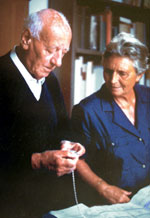
Madeleine Cavalier
Biographical profile
Madeleine Cavalier, born at Vacquières Hérault (France) on 27 June 1928, began her career in archaeology as a pupil of M. Louis, Professor of Prehistory at the University of Montpellier.
From 1948 to 1952 she was secretary and vice-president of the Section Languedocienne of the Istituto Internazionale di Studi Liguri, for which she participated in 1949 in the excavations in the Arene Candide cave at Finale Ligure, and in 1950 in those of Tindari (ancient Tyndaris) in Sicily that the Soprintendenza alle Antichità in Syracuse had entrusted to the Istituto Internazionale di Studi Liguri directed by N. Lamboglia.
She then began her collaboration with the Soprintendenza of Syracuse directed by L. Bernabò Brea, who assigned to her the direction of the excavations of Milazzo in the years 1951-52.
In 1951, as personal assistant of L. Bernabò Brea, she assumed the scientific direction of the excavations in Lipari and of all archaeological activity in the Aeolian Isles. She excavated at Salina in 1955, at Filicudi in 1956, at Filicudi again in 1959, in the prehistoric villages of Capo Graziano and Filo Braccio, at Stromboli in 1978, when she excavated the Greek necropolis of Ficogrande, again in Stromboli in 1980 (the prehistoric village of San Vicenzo). She also conducted an exploratory campaign on the island of Alicudi.
In the meantime she was called by the Soprintendenza of Syracuse also to direct the excavations of Tyndaris, Milazzo Abaceanum, Aluntium etc. and to superintend the restoration of the ancient Greek theatre and Basilica of Tyndaris.
In 1956 she received a bursary from the French Research Council (C.N.R.S.) at the Institut Français in Beirut (Lebanon) and at the Ecole Française d'Athènes to conduct explorations in Lebanon, Turkey, Cyprus and Greece. The main result of her period of research in Greece was the study of the relation between the prehistoric cultures of the Aeolian Isles and those of the Aegean.
She then assumed the post of Director at the Museo Archeologico Eoliano and was also appointed Honorary Conservator and Honorary Inspector for the Aeolian Isles.
Hired as Attaché de Recherche at the Centre National de la Recherche Scientifique, she was successively promoted from the rank of Chargé to Directeur de Recherche de 1ère classe. She was then appointed affiliate member of the Centre Jean Bérard in Naples (URA.18) and seconded to Lipari in the framework of the fruitful cultural collaboration between Italy and France.
In 1953 she was called by Italy's Scuola Archeologica in Athens, directed by D. Levi, to assist L. Bernabò Brea in the publication of the prehistoric excavations at Poliochni (Lemnos), conducted between 1930 and 1936. As part of this posting she collaborated in the organization of the Museum of Lemnos at Myrina in 1960.
She directed all the excavations conducted in the Aeolian Isles, and constantly strove to reinvigorate the Museo Archeologico Eoliano through the display of new finds and the data of new excavations conducted both in Italy and in the Aegean. After the death of L. Bernabò Brea at Lipari in February 1999, Madeleine Cavalier did not slacken in her efforts, but continued his work by publishing all the works that he had begun, namely:
On the excavations of Lipari:
- Meligunìs Lipàra X, Rome 2000 (explorations in the urban and suburban area of Lipari).
- Meligunìs Lipàra XI, in two volumes, Palermo 2001 (necropolis of Contrada Diana).
- Meligunìs Lipàra XII, with Lorenzo Campagna (Greek and Latin lapidary inscriptions found in the necropolis).
- Il monastero normanno di Lipari e il suo chiostro, in Quaderni dell'Università di Messsina, Messina 2001 (the Norman monastery in Lipari and its cloister).
- Terrecotte teatrali e buffonesche della Sicilia Orientale e Centrale, Palermo 2002 (theatrical and burlesque terracottas in Eastern and Central Sicily.
On the terrecottas of Lipari:
- I ritratti greci nelle terrecotte liparesi della prima metà del III sec. a C., Rome 2000 (Greek terracotta portraits of the first half of the 3rd century BC).
- Maschere e personaggi del teatro greco nelle terrecotte liparesi, Rome 2001 (masks and characters of the Greek theatre in the terracottas of Lipari).
- Terrecotte teatrali e buffonesche della Sicilia Orientale e Centrale, Palermo 2002 (theatrical and burlesque terracottas in Eastern and Central Sicily.
The activity of Madeleine Cavalier continues on a daily basis, both in the help she gives to young scholars who wish to deepen their knowledge of the archaeological materials of Lipari, and in her personal commitment to study and publication. Of the excavation reports now in preparation one of the main ones is the publication of the excavations of insula IV at Tyndaris, conducted between 1950 and 1961.
Honorary posts
- 1957. Medaglia di bronzo dal Ministero della Pubblica Istruzione per i benemeriti della Cultura e dell'Arte.
- 1962. Membro Straniero dell'Istituto di Studi Etruschi e Italici.
- 1963. Membro Corrispondente dell'Istituto Archeologico Germanico.
- 1986. Médaille d'argent du Centre National de la Recherche Scientifique.
- 1995. Médaille de bronze de la ville de Montpellier
- 1996. Cittadinanza onoraria delle isole Eolie (Comuni di Leni, Lipari, Malfa e Santa Marina Salina).
- 1997. Medaglia d'oro Associazione Nazionale Musei Italiani - Sezione Sicilia.
- 1997. Médaille d'argent Centre National de la Recherche Scientifique Paris (Témoignage rayonnement scientifique CNRS).
- 1999. Commendatore dell'Ordine «al merito della Repubblica italiana».
- 2006. Chevalier de l'Ordre des Arts et des Lettres
Bibliography
- Sobre la distribuciòn de la ceramica decorada con "botones" en relieve, in Ampurias XI, 1949, pp. 186-190, figg. 1-5.
- con L. Bernabò Brea, Civiltà preistoriche delle Isole Eolie e del territorio di Milazzo, in Bullettino di Paletnologia italiana, vol. LXV, 1956, pp. 7-99.
- Salina. A prehistoric village in the Aeolian Islands, in Antiquity, n°121, March 1957.
- Civilisations préhistoriques des Iles Eoliennes et du territoire de Mylazzo, en Revue Archéologiques, 1957, pp.123-147.
- con L. Bernabò Brea, Stazioni preistoriche delle isole Eolie I. La stazione stentinelliana di Castellaro Vecchio presso Quattropani (Lipari); II. Stazioni preistoriche di Piano Conte sull'altipiano di Lipari, in Bullettino di Paletnologia Italiana, vol. LXVI , 1957, pp. 97-151.
- con L. Bernabò Brea, Il Castello di Lipari e il Museo Archeologico Eoliano, S.F. Flaccovio, Palermo 1958, pp. 105; 2 ème ediz. 1977 pp. 215; ristampa 1979 (Ivi una lunga nota bibliografica).
- con L. Bernabò Brea, Mylai, Storia Patria per la Sicilia Orientale, 1959, pp.1-136; tavv. I-LVIII
- La grotte de la Zinzulusa et la stratigraphie de Lipari, in Mélanges d'Archéologie et d'Histoire, Ecole Française de Rome, 1960, pp.1-32.
- con L. Bernabò Brea, Meligunìs Lipàra, vol. I, La stazione preistorica della contrada Diana e la necropoli prorostorica di Lipari, Palermo 1960, pp.1-172, tavv.I-XLIV.torna all'inizio della pagina
- Les cultures préhistoriques des Iles Eoliennes et leur rapport avec le monde égéen, in Bulletin de Correspondance hellénique, LXXXIV, 1960-1961, pp.319-346.
- con L. Bernabò Brea, Meligunìs Lipàra vol. II, La necropoli greca e romana della contrada Diana, Palermo 1965, pp.1-380, tavv. I-CCXXXIII.
- con L. Bernabò Brea, Scavi in Sicilia. Lipari, Zona archeologica del Castello, in Bollettino d'Arte, L, 1965, pp.202-205.
- Filicudi. Villaggio preistorico del Capo Graziano, in Bollettino d'Arte, LI, 1966, pp.99-100.
- Lipari. Scavo XXVII in contrada Diana, in Bollettino d'Arte, 1966, p.102.
- Panarea (Messina) Villaggio dell'età del bronzo sul promontorio del Milazzese, in Bollettino d'Arte, LI, 1966, p.102.
- con L. Bernabò Brea, Ricerche paletnologiche nell'isola di Filicudi, in Bullettino di Paletnologia Italiana vol. LXXV, 1966, pp.143-173.
- L'épave de Capo Graziano, in "Archeologia", n°17, 1967, pp. 39-41.
- con L. Bernabò Brea, Meligunìs Lipàra, vol. III, Stazioni preistoriche delle isole Panarea, Salina e Stromboli, Palermo 1968, pp.1-279, tavv. I-XCVII.
- La tomba della bambola, in Sicilia Archeologica, n°16. 1971, pp.9-12.
- Necropoli a incinerazione della cultura di Capo Graziano, in Magna Graecia, Anno VI, N. 7-8, 1971,pp.5-6.
- Il riparo della Sperlinga di San Basilio (Novara di Sicilia), con appendice di I. BIDDITTU, in Bullettino di Paletnologia italiana, N.S. XXII,- vol. 80- 1971, pp.1-63.
- Nuove sistemazioni nel Museo Eoliano di Lipari, in Musei e Gallerie d'Arte d'Italia, N.47, Maggio-Agosto 1972, pp. 3-10.
- La stazione preistorica di Tindari, in Bullettino di Paletnologia italiana, vol. 79 - 1970, Roma 1972, pp.61-94.
- Mura greche e Aggere romano scoperti a Lipari, in Magna Graecia , Anno VII. N. 7-8, Luglio-Agosto 1972, pp. 7-8.
- Nouveaux documents sur l'art du Peintre de Lipari, (Préface de L. Bernabò Brea), Bibliothèque de l'Institut français de Naples; Publications du Centre Jean Bérard, III, Napoli 1976.
- L'uomo e i vulcani nelle isole Eolie, in Magna Graecia, Anno XIII, N. 5-6, 1978.
- Necropoli greca di Stromboli, in Sicilia Archeologica, Anno XII, N. 40, 1979, pp.7-26.
- Ricerche preistoriche nell'arcipelago eoliano, in Rivista di Scienze preistoriche, vol. XXXIV, Fasc. 1-2, 1979, pp.45-136.
- con L. Bernabò Brea, Meligunìs Lipàra, vol. IV, L'acropoli di Lipari nella preistoria, Palermo, 1980, (volume di testo pp.1-875, volume di tavole tavv. I- CCCXXII e Atlante).
- La necropoli a incinerazione dell'età di Capo Graziano nella contrada Diana, Appendice I in Meligunìs Lipàra IV, Palermo 1980, pp. 721-731.
- con O. Ragusi, Il Museo Eoliano di Lipari, Milano 1980 pp.1-63.
- Le terrecotte liparesi di argomento teatrale e la ceramica. I dati di rinvenimento. Appendice II al libro di L. Bernabò Brea, Menandro e il teatro greco nelle terrecotte liparesi, Genova, 1981, pp.259-310.
- Villaggio preistorico di San Vincenzo. Stromboli, in Sicilia Archeologica, 1981, pp. 27-54.
- con L. Vagnetti, Filicudi in La Sicilia e le Isole Eolie, in Magna Grecia e il Mondo miceneo, Taranto, Ottobre 1982.
- con L. Bernabò Brea, Le terme di San Calogero, in Arcipelago , VII, 1983, n.3, p.5.
- con L. Vagnetti, Frammenti di ceramica "Matt painted" policroma di Filicudi (Isole Eolie) in Mélanges de l'Ecole Française de Rome, Tome 95, 1983.
- Alicudi, Voce in Bibliografia topografica della colonizzazione greca in Italia e nelle isole tirreniche, diretta da G. Nenci et G. Vallet, Scuola Normale superiore di Pisa, Ecole Française de Rome, Pisa Roma, 1984, vol.III, pp.171-173.
- con L. Bernabò Brea, Il neolitico delle Isole Eolie in "Problemi attuali di Scienze e cultura" Quaderno n°257, Rapporti tra i Balcani e l'Italia Meridionale nel neolitico; Atti del Convegno Italo Jugoslavia tenutosi a Lipari dal 10 al 13 Maggio 1978, Accademia Nazionale dei Lincei, Roma 1984, pp.29-40.
- con L. Vagnetti, Materiali micenei vecchi e nuovi dall'Acropoli di Lipari, in Studi Micenei ed Anatolici, fasc. XXV, 1984,pp. 143-154.
- Attività archeologica nelle isole Eolie, (1980-1984) in Kokalos, XXX-XXXI, 1984-1985, tome 112, pp.695-709.
- Les amphores du VIème au IVème siècle avant J.C., dans les fouilles de Lipari, Cahiers du Centre Jean Bérard, XI, Naples 1985, pp.1-91.
- La céramique polychrome de Lipari, in Actes du 3éme Colloque d'Histoire et d'Archéologie de Bastia, 7-10 Mai 1985, pp. 155-168.
- Basiluzzo, voce in Bibliografia topografica della colonizzazione greca in Italia e nelle isole tirreniche, Pisa-Roma, 1985, vol. IV, pp.14-18
- con L. Bernabò Brea, A cura di. Archeologia subacquea nelle Isole Eolie, in Bollettino d'Arte, suppl. al n° 29 , 1985, pp. 11-127.
- Archeologia marina nell'isola di Filicudi. In appendice alla riproduzione litografica dall'originale con traduzione in italiano a cura di P.Paino, Lipari 1985, del quinto volume, Filicuri, dell'opera Die Liparischen Inseln di L.S. d'Austria.
- Nuovi rinvenimenti sul Castello di Lipari, in Rivista di Scienze preistoriche, Volume XL - 1985-1986 , Fascicolo 1-3, pp. 225-254.
- Salina nella preistoria e nell'età greca e romana, in appendice alla riproduzione dell'opera, Salina, Die Liparischen Inslen di S.L. d'Austria, vol. II, Lipari, 1986.
- con L. Bernabò Brea, La ceramica policroma liparese di età ellenistica, Muggiò (Milano), 1986, pp.1-112.
- con A. Brugnone, I bolli delle tegole della necropoli di Lipari, in Kokalos,XXXII, 1986, pp.181-282.
- con L. Vagnetti, Arcipelago Eoliano, in Traffici Micenei nel Mediterraneo. Problemi storici e documentazione archeologica, Istituto Gramsci siciliano, Taranto 1986, pp.141-143.
- Lo scavo intorno alla tholos di San Calogero, in Atti del Convegno internazionale "Momenti precoloniali nel Mediterraneo antico" Roma 1985, Edizioni del Consiglio nazionale delle Ricerche, Roma, 1988, pp.109-111.
- Archeologia e vulcanologia nelle isole Eolie, in PACT 25, 1990, Actes des Ateliers Européen de Ravello, 19-27 Novembre 1987 et 30-31 Mars 1989, pp.25-48.
- con L. Bernabò Brea, Filicudi, Voce in Bibliografia topografica della colonizzazione greca in Italia e nelle isole tirreniche, vol. VII, siti, Pisa-Roma 1989, pp.457-464.
- con L. Bernabò Brea, La tholos termale di San Calogero nell'isola di Lipari in Studi Micenei ed Egeo-Anatolici, n.XXVIII, 1990, pp.7-84.
- con L. Bernabò Brea, Sulla rotta di Ulisse, Kalos, Arte in Sicilia, 3, maggio-giugno, Palermo, 1990, pp.52-55.
- Lisca Bianca, voce in Bibliografia topografica della colonizzazione greca in Italia e nelle isole tirreniche, Pisa Roma, 1991, vol. IX, p.186.
- con L. Bernabò Brea, Voce Lipari in Bibliografia topografica della colonizzazione greca e delle isole tirreniche, Pisa Roma 1991, vol. IX, pp.80-185
- con L. Bernabò Brea, Meligunìs Lipàra vol. V, Scavi nella necropoli greca di Lipari, Roma 1991, pp.1-192, tavv. I-CLXXXVII.
- con L. Bernabò Brea, Meligunìs Lipàra vol. VI, Filicudi, insediamenti dell'età del bronzo, Palermo 1991, pp.1-354, tavv. CVII.
- con L. Bernabò Brea, Isole Eolie: vulcanologia, archeologia, Muggiò (Milano) 1991, pp.1-192.
- Dix années de recherches archéologiques aux Iles Lipari, in Bulletin de la Société Française d'Archéologie classique, XXV, 1991-1992, pp.205-213.
- con L. Bernabò Brea, Milazzo, voce in Bibliografia Topografica della colonizzazione greca in Italia e nelle isole tirreniche, vol. X, Pisa-Roma, 1992, pp. 115-140.
- Twenty years of archaeological Islands, in Mediterranean Archaeology, vol.56, 1992-1993, pp.5-13.
- con L. Bernabò Brea, Sulla rotta di Ulisse, in Kalos, Luoghi di Sicilia, Palermo 1993, pp.52-55.
- con L. Bernabò Brea, Attività della Soprintendenza: Isole Eolie in Kokalos XXXIX-XL 1993-1994, pp.989-1000.
- Les thermes de San Calogero à l'époque grecque et romaine, in L'eau, la santé et la maladie dans le monde grec, Bulletin de Correspondance Hellenique, supplément 28, 1994, pp.183-192.
- Isole Eolie. Anfore per l'esportazione. Individuata una fornace che produceva in età romana imperiale contenitori da trasporto, in Archeo, anno IX, 1994, n°3, (109), pp. 8-9.
- Les amphores Richborough 527. Découverte d'un atelier à Portinenti (Lipari Italie) in S.F.E.C.A.G. «Actes du Congrès de Millau», 1994, pp.189-195.
- Voce Panarea in Bibliografia topografica della colonizzazione greca in Italia e nelle isole tirreniche, Pisa Roma, vol. XIII, pp.321-329.
- con L. Bernabò Brea, Meligunìs Lipàra, vol. VII. Lipari. Contrada Diana. Scavo XXXVI in proprietà Zagami (1975-1984), Palermo, 1994.
- con L. Bernabò Brea e U. Spigo, Lipari. Museo Eoliano. Palermo 1994, pp.1-150.
- Scoperta dei primi vasi delle Tre Nikai, in « Hommage à Georges Vallet «Centre culturel français de Palerme et de Sicile, Palermo 24-25 Octobre 1995, pp.30-47.
- Il Museo Archeologico di Lipari, in Nuove Effemeridi, rassegna trimestrale di cultura, Anno VIII , N.30, 1995, pp.178-182.
- New Greek and Roman discoveries from Lipari, in Mediterranean Archaeology , vol.8, 1995, 83-88, Plat. V-VIII.
- con L. Bernabò Brea, Meligunìs Lipàra, vol. VIII, Parte Prima. Salina . Ricerche Archeologiche (1989-1993), Palermo 1995, pp.1-193; tavv. I-XXXVI. Parte II. A. PAGLIARA, Fonti per la storia dell'arcipelago eoliano in età greca con appendice sull'epoca romana, Palermo 1995, pp.1-131
- con L. Bernabò Brea, Isole Eolie, in Preistoria e Protostoria. Guide Archeologiche n° 12, Sicilia Orientale e Isole Eolie, Forlì 1995, pp.11-153.
- Il pittore delle Tre Nikai, Nuovi rinvenimenti, in Quaderni del Museo Archeologico Regionale Eoliano I, 1996, pp.113-122.
- Obsidian and the Aeolian Islands in S.G. Pandala (a cura di) Volcanism and Archaeology in Mediterranean Area Trivandrum (Kevala State Idia), 1997, pp.101-106.
- con L. Bernabò Brea, La ceramica figurata della Sicilia e della Magna Grecia nella Lipari del IV sec. a.C. Muggiò (Milano) 1997, pp.1-191.
- L'atelier du Peintre de Lipari au cours du IIIème siècle av. J.C. in «L'Italie méridionale et les premières expériences de la peinture hellenistique» Actes de la table ronde organisée par l'Ecole Française de Rome, 18 Février 1994. Collection de l'Ecole Française de Rome, N.244, Rome 1998, pp.191-202.
- Gli scavi del Barone Mandralisca ed altre ricerche del XIX secolo nella necropoli di Lipari, in Enrico Pirajno di Mandralisca, umanità, scienza e cultura in una grande collezione siciliana, Palermo 1998, pp.25-26.
- con L. Bernabò Brea, Meligunìs Lipàra vol. IX, Topografia di Lipari in età greca e romana , Palermo 1998. Parte I,con F. Villard L'acropoli, pp. 1-265, tavv.I- CXXXII; Parte II, La città bassa, pp.1-421, tavv. CXXXIII-CCXXXVI.
- La fondazione della Lipàra cnidia. In "La colonisation grecque en Méditerranée" Actes de la rencontre scientifique en Hommage à G. Vallet, Rome Naples 15-18 Novembre 1995, Collection de l'Ecole Française de Rome N.2, 1999, pp. 293-302.
- con L. Bernabò Brea, Meligunìs Lipàra vol. X, Scoperti e scavi archeologici nell'area urbana e suburbana di Lipari, Roma 2000, pp.1-486.
- con L. Bernabò Brea, Il ritratto di Euripide nella coroplastica liparese, in Damarato, Studi di antichità classici offerti a Paola Pelagatti, Milano, 2000, pp.261-264.
- con L. Bernabò Brea, I ritratti greci nelle terracotte liparesi della prima metà del III secolo a.C., Roma 2000, pp.1-56.
- con L. Bernabò Brea, A. Tagliacozzo, La Grotta del santuario della Madonna (Praia a Mare – Cosenza), Memorie dell’ Istituto Italiano di Paleontologia Umana, anno IV, 6, Roma, 2000, pp. 1-150.
- con L. Bernabò Brea e F. Villard, Meligunìs Lipàra vol. XI, Gli scavi nella necropoli greca e romana di Lipari nell'area del terreno vescovile, Roma 2001, Parte I, pp.1-453, tavv. I-CLXXXIX; Parte II, pp.454-870, tavv. CXC-CCCXXXVI.
- con L. Bernabò Brea, Maschere e personaggi del teatro greco nelle terracotte liparesi, Roma 2001, pp.1-316, figg.1-380.
- con L. Bernabò Brea, Voce Salina Bibliografia topografica della colonizzazione greca e nelle isole tirreniche, Pisa-Roma 2001, pp.226-234.
- con L. Bernabò Brea, Terracotte teatrali e buffonesche della Sicilia Orientale e Centrale, Palermo, 2002, pp.1-204, figg.1-169.
- con L. Bernabò Brea, Il Monastero normanno di Lipari e il suo chiostro. Ricerche e scavi, 1980-1985, in Quaderni dell'Università di Messine, n°2, 2002, pp.171-269.
- A cura di M. Cavalier e di M. Bernabò Brea, In memoria di Luigi Bernabò Brea, Regione Siciliana, Assessorato Beni Culturali ed Ambientali e della Pubblica Istruzione, Palermo 2002.
- Luigi Bernabò Brea. Note biografiche, Atti XXXV Riunione Scientifica dell’Istituto Italiano di Preistoria e Protostoria, Lipari 2-7 giugno 2000, Firenze 2003, pp. 33-59.
- con L . Bernabò Brea, Lipari. Il complesso archeologico delle terme di San Calogero, Quaderni di Archeologia dell’Università di Messina, 4, 2003, pp. 5-51.
- con L. Bernabò Brea e L. Campagna, Meligunìs Lipàra XII, Le iscrizioni lapidarie greche e latine delle isole Eolie, Palermo, 2003, pp.1-575, tavv. I- CCIX.
- con M. Bernabò Brea, Bibliografia di Luigi Bernabò Brea, in P. Pelagatti, G. Spadea (a cura di), Dalle Arene Candide a Lipari. Scritti in onore di Luigi Bernabò Brea, Atti del Convegno di Genova, 3-5- febbraio 2001, Bollettino d’Arte, volume speciale, 2004, pp. 217-224.
- Le isole Eolie e la navigazione preistorica nel Mediterraneo, in "Tra due Mari" a cura di Mario Primo Cavaleri, Provincia Regionale di Messina, Assessorato Beni Culturali, Messina 2005, pp.42-50.
- Rinvenimenti archeologici nei comuni di Leni e Malfa (Isola di Salina - Messina), Sicilia Antiqua II, Pisa-Roma, 2005, pp. 157-172.
- Stromboli, voce in Bibliografia topografica della colonizzazione greca in Italia e nelle isole tirreniche, Pisa-Roma, XIX, 2005, pp. 672-680.
- con L. Bernabò Brea, Bellezza ed eleganza femminile nella Lipari greca ed ellenisrica, Roma, 2005, pp.1-129.
- con A Depalmas, Materiali sardi nel villaggio di Lipari. I frammenti ceramici e le correlazioni, Rivista di Scienze Preistoriche 58, 2008, pp. 281-300.
- con G.M. Bacci, M.G. Vanaria, Isole Eolie. Il termalismo nell’antichità, Regione Siciliana, Assessorato dei Beni Culturali, Palermo, 2008.
- La necropoli di Lipari e l’evoluzione degli artigianati locali, riflessi di una vita artistica nella Lipàra greca (fine VI-III sec.a.C.), in Artisanats antiques d’Italie et de Gaule, Mélanges offerts à Maria Francesca Bonaiuto, Collection du Centre Jean Bérard, 32, 2009, pp. 69-86.
- con M. Cultraro, L’insediamento eneolitico sul Poggio dell’Aquila (Adrano): risultati preliminari, in G. Lamagna (a cura di), Tra Etna e Simeto. La ricerca archeologica ad Adrano e nel suo territorio, Atti dell’incontro di studi per il 50° anniversario dell’istituzione del Museo di Adrano, Adrano, 8 giugno 2005, Giarre (CT), 2009, pp. 49-64.
- La produzione delle terrecotte teatrali ( Lipari ed altri siti) in Philotechnia.Studi sulla coroplastica della Sicilia greca, a cura di M. Albertocchi e A. Pautasso, Monografie IBAM 5, Catania 2012,pp.211-225.
- La Lipàra cnidia, in La Sicilia in Età arcaica. Dalle apoikiai al 480 a.C, a cura di R.Panvini e L.Sole, III, Atti del Convegno Internazionale (Caltanisetta, Museo Archeologico, 27-29 marzo 2008), I, Caltanisetta 2012, pp. 173-178.
- con M. C. Martinelli, E. Procelli, M. Pacciarelli, L'età del Bronzo antica e media nella Sicilia orientale e nella zona dello Stretto di Messina, in Dai Ciclopi agli Ecisti. Società e territorio nella Sicilia preistorica e protostorica, Atti XLI Riunione Scientifica dell’Istituto Italiano di Preistoria e Protostoria, San Cipirello (PA),16 -19 novembre 2006, Firenze, 2012, pp. 157-186.
- Vacquières. Histoire et évolution de la propriété des « Cavalier » de 1530 à nos jours (2012), Roma, 2013.
- con A. Ollà, S.Paparoni, Tindari (ME) in D.Malfitana, M.Bonifay, a cura di, La ceramica africana nella Sicilia romana, Monografie dell’Istituto per i Beni Archeologici e Monumentali, C.N.R., 12, Catania, 2016, pp. 66-69.
Maria Clara Martinelli
BIOGRAPHICAL PROFILE
Maria Clara Martinelli was born in Bari in 1959, graduated in Literature from the University of Bari in 1983 and specialised in Prehistoric Archaeology at the University of Pisa in 1986. Later, she held a Foreign Ministry scholarship to Croatia and Dalmatia at the University of Zadar, where she developed a research project on Neolithic lithic industries and raw material exchanges in the Mediterranean. This study led her to Lipari to further the study of obsidian.
Since 2014 she has been qualified as an associate professor in Archaeology.
In 2017, she obtained a 2nd level university master's degree at the University of Roma Tre, in Cultural Mediation in Museums: didactic, experimental and evaluation aspects. She has lectured in various Italian Universities in courses on cultural heritage, prehistoric archaeology and museology.
Since 1990 she has lived in Lipari, where she carries out studies and research in the Aeolian archipelago. After an intense professional activity conducted through collaborations and assignments with different Archaeological Superintendencies – of Apulia, Calabria, Tuscany, Latium - and of the Sicily Region for archaeological investigations and the cataloguing of cultural heritage, in 2000 she won the competition for Dirigente Tecnico Archeologo of the Sicilian Region. In 2005 he took up service, with the title of Funzionario Direttivo, at the Soprintendenza Beni Culturali ed Ambientali di Messina and since 2011 at the Parco Archeologico delle Isole Eolie.
She has constantly carried out her scientific activity at the Luigi Bernabò Brea Archaeological Museum on Lipari since 1990, collaborating in the study of Aeolian archaeology with its founders: Luigi Bernabò Brea and Madeleine Cavalier. Today she is curator of the Museum's collections, continuing the teaching she received. She is particularly involved in didactics and museum communication.
She has participated as coordinator and scientific officer in numerous archaeological excavation campaigns at prehistoric sites in various Italian regions, including S. Martin de Corleans in Aosta, the Paglicci Cave in Apulia, the Serratura Cave in Campania, the San Sebastiano Cave in Calabria, La Consuma in Arezzo, the settlements in Sesto Fiorentino. In Sicily, she worked in Messina, where she coordinated investigations at the Casa dello Studente, Via La Farina and Camaro; in Milazzo, in Piazza XXV Aprile and Via XX Settembre, and in the Milazzo’s province, in sites discovered during the methane pipeline works in 2006-2008.
In the Aeolian Islands, she directed archaeological investigations in the Bronze Age settlements of Panarea, Salina and Filicudi. She is part of the research group on the San Vincenzo site in Stromboli, coordinated by prof. Sara T. Levi, of the University of Modena and Reggio Emilia.
She has collaborated on curating exhibitions and catalogues and on museum layouts. Among the latter, she has designed the layout of the archaeological part of the Santa Marina Salina Civic Museum and that of the Minor Islands section of the Lipari Museum.
She collaborates with the Italian Institute of Prehistory and Protohistory based in Florence, of which she is a member and in 2021 and 2024 was elected a member of the Board of Directors.
She is the author of 140 publications including articles in specialist journals and conference proceedings in the archaeological sector, archaeological guides and scientific books.
In addition, from 1997 to 2004 she edited the series "Quaderni del Museo Archeologico Eoliano" and in 2018, with others colleagues, the volume in homage to Madeleine Cavalier, by the Centre Jean Berard of Naples.
In her volume Isole vicine. L'arcipelago delle isole Eolie e le comunità umane nella preistoria mediterranea, 2020, she proposes a summary and updated overview of the knowledge of the first human communities that inhabited the Aeolian islands in comparison with the Mediterranean area.
Bibliography
(Scientific publications from the most recent)
- Bettelli M., Martinelli M.C., 2024, Le Eolie e la Grecia micenea, in Crispino A., Jung R., (eds.), Il regno di Ahhijawa, L’erma di Bretschneider, Roma: 125-130.
- Martinelli M.C., Giordano L., Speciale C., Triolo M., 2023, Filo Braccio, insediamento di facies Capo Graziano a Filicudi nelle Isole Eolie: spazi e attività quotidiane nella casa fattoria (household), in Bianchi P.A.E., Saracino M., (eds.), Spazi domestici nell’età del Bronzo: dall’individuazione alla restituzione, Memorie del Museo Civico di Storia Naturale di Verona, serie 2, sezione Scienze dell’Uomo n. 16: 113-126
- Armetta F., Giuffrida D., Martinelli M.C., Nardo V.M., Saladino M.L., Ponterio R.C., 2023, Non-invasive investigation on pigments of the Aeolian Islands Neolithic pottery, Materials Letters, doi: https://doi.org/10.1016/j.matlet.2023.133854
- Bonizzoni L., Martinelli M.C., Coltelli M., Manni M., Balestrieri M.L., Oddone M., Guglielmetti A., 2022, New perspectives on an “old” technique: Lipari obsidian and Neolithic communities investigated by Fission Track Dating, Journal of Physics, Conference series, Metroarchaeo 2021, n. 2204, https://iopscience.iop.org/article/10.1088/1742-6596/2204/1/012032
- Martinelli M.C., Manni M., Coltelli M., 2021, Resilience and adaptation to volcanoes in Late Middle Ages in Lipari island (Aeolian, Italy), Annals of Geophysics, 64,5: https://www.annalsofgeophysics.eu/index.php/annals/article/view/8648
- Martinelli M., Dawson H., Lo Cascio P., Levi S.T. e Fiorentino G., 2021,Blowin’in the wind: Settlement, Landscape and Network in the Prehistory of the Aeolian Islands, Journal of Mediterranean Archaeology, 34.1: 28-57 https://doi.org/10.1558/jma.43201
- Martinelli M.C., Levi S.T., 2021, I contrassegni eoliani. Classificazione e distribuzione. Rivista di Scienze Preistoriche, LXXI-2021: 169-192 https://DOI 10.32097/1152 Supplementary data open access in: https://www.openprehistory.org/prodotto/m-c-martinelli-s-t-levi-i-contrassegni-eoliani-classificazione-e-distribuzione/
- Martinelli M.C., 2020, Isole vicine. L’arcipelago delle isole Eolie e le comunità umane nella preistoria mediterranea. Ragusa: Edizioni di Storia e Studi sociali.
- Levi S.T., Cannavò V., Martinelli M.C., Bettelli M., Brunelli D., Di Renzoni A., Williams J.Ll., 2020, Tradition and innovation: pre and protohistoric pottery at Lipari in a wider environmental and cultural perspective. Rivista di Scienze Preistoriche LXX- Early edition. Istituto Italiano di Preistoria e Protostoria, Firenze. DOI 10.32097/1106
- Levi S.T., Bettelli M., Cannavò V., Di Renzoni A., Ferranti F., Martinelli M.C., Vertuani P., Zaghetto L., 2020, Looking for codes and paths into the Capo Graziano decoration. In J. Driessen and A. Vanzetti (eds.) Communication Uneven. Aegis 20. Louvain: Presses universitaires de Louvain: 17-37.
- Martinelli M.C., 2020, Isole Eolie e relazioni con la Sicilia nella metà del II millennio /a.C., in: Palio O., Todaro S., Turco M. (a cura di), Vivere all’ombra del Vulcano. Studi in memoria di Enrico Procelli, Quasar, Roma: 391-400.
- Martinelli M.C., Coltelli M., Manni M. , Bonizzoni L., Balestrieri M. L., Guglielmetti A., Oddone, 2020, Prehistorical obsidian sources in the island of Lipari (Aeolian Islands), Open Archaeology, 6: 393-402 https://doi.org/10.1515/opar-2020-0119
- Martinelli M.C., Levi S. T., Bettelli M., 2020, Isole Eolie ed Egeo nell’età del Bronzo, in: Bernabò Brea M. (a cura di), Italia tra Mediterraneo ed. Europa: mobilità interazioni e scambi, Rivista di Scienze Preistoriche, LXX-S1, Istituto Italiano di Preistoria e Protostoria, Firenze: 523-529.
- Martinelli M.C., Tykot R.H., Vianello A., 2019, Lipari (Aeolian Islands) Obsidian in the Late Neolithic. Artifacts, Sup/ply and Function, Open Archaeology 2019, 5: 46–64. https://www.degruyter.com/view/journals/opar/5/1/opar.5.issue-1.xml
- Quero T., Martinelli M.C., Giordano L., 2019, The Neolithic Site of San Martino — Sicily: Working and Circulation of Obsidian from Lipari, Open Archaeology 2019, 5: 65-82.
- Bavastrelli S., Gambino R., Capostagno F., Martinelli M.C.,Vilardo R.,2019, Museo archeologico regionale di Lipari Luigi Bernabò Brea. I restauri del cratere di Ippolito e l’evoluzione delle metodologie d’intervento, XVII Congresso Nazionale IGIIC – Lo Stato dell’Arte – Chiesa di Cristo Flagellato dell’ex Ospedale San Rocco, Matera, 10-12 ottobre 2019: 435-442. https://www.igiic.org/
- Manni M., Coltelli M., Martinelli M.C., 2019, Volcanic events that have marked the anthropic history of the Aeolian Islands, Annals of Geophysics, 62,Nu.1 (2019), Istituto Nazionale di Geofisica e Vulcanologia, https://www.annalsofgeophysics.eu/index.php/annals/article/view/7716
- Martinelli M.C., 2018, The Tale of the Sea. The Bronze Age Cup of Filicudi (Aeolian Islands), in Bettelli M., Del Freo M., van Wijngaarden G.J. (eds) Mediterranea Itinera, Studies in Honour of Lucia Vagnetti, CNR Istituto di Sudi sul Mediterraneo Antico, Incunabula Graeca, CVI, Roma: 369-380.
- Martinelli M.C., 2018, Madeleine Cavalier e le Isole Eolie, in Bernabò Brea M., Massimo Cultraro M., Gras M., Martinelli M.C., Pouzaudoux C., Spigo U., (a cura di), 2018, A Madeleine Cavalier, CNRS Collection du Centre Jean Berard, 49, Centre Jean Berard, Napoli: 51-54.
- Martinelli M.C., Lo Cascio P., 2018, Topografia della preistoria nelle Isole Eolie, in Bernabò Brea M., Massimo Cultra/ro M., Gras M., Martinelli M.C., Pouzaudoux C., Spigo U., (a cura di), A Madeleine Cavalier, CNRS Collection du Centre Jean Berard, 49, Centre Jean Berard, Napoli: 65-78.
- Italiano F., Correale A., Di Bella M., Foresta Martin F., Martinelli M.C., Sabatino G., Spatafora F., 2018, The Neolithic obsidian artifacts from Roccapalumba (Palermo, Italy); first characterization and provenance determination, Mediterranean Archaeology and Archaeometry, Vol. 18, No 3: 151-167
- Ollà A., Sardella A., Spigo U., Martinelli M.C., Giordano L., 2018, Nuovi dati e materiali dalla necropoli di Lipari: la campagna di scavo 2012-2013, in Atti convegno Ollus leto datus est. Architettura, topografia e rituali funerari nelle necropoli dell'Italia meridionale e della Sicilia fra antichità e medioevo. Reggio Calabria 22-25 ottobre 2013, vol. I-046, MarRC edizioni scientifiche, Reggio Calabria: 387-398
- Marcella Di Bella M., Francesco Italiano F., Martinelli M.C., Mazzoleni P., Quartieri S., Tigano G., Tripodo A., Sabatino G., 2017, Archeometric characterization of prehistoric grindstones from Milazzo Bronze Age settlement (Sicily, Italy), in Archaeological Anthropological Science, Springer ed.: 1-15 DOI 10.1007/s12520-017-0483-8 ISSN 1866-9557
- Cannizzaro F., Martinelli M.C., Muntoni I.M..2017, Fosse di combustione del Neolitico in Sicilia. III IAPP Incontro annuale di preistoria e protostoria “Pozzetti, buche, piccole fosse, silos…” Le strutture in negativo neolitiche di piccole dimensioni: metodi di indagine e problemi interpretativi. Istituto Italiano di Preistoria e Protostoria, 8-9 maggio 2017, Firenze. Abstract online
- Muntoni I.M., Radina F., Martinelli M.C., Lemorini C., 2017, Abitati e produzioni nella bassa Murgia barese: le ricerche negli insediamenti neolitici del Pulo di Molfetta e Balsignano in F. Radina (a cura di), Preistoria e Protostoria della Puglia, Studi di Preistoria e Protostoria – 4, Firenze: 261-275.
- Martinelli M.C., Giordano L., 2017, La facies di Capo Graziano a Lipari nelle Isole Eolie: nuove scoperte, Rivista di Scienze Preistoriche LXVII - 2017, Istituto Italiano di Preistoria e Protostoria, Firenze: 255-272.
- Martinelli M.C., Speciale C., 2017, Classificazione della ceramica e analisi dei contesti all’inizio dell’età del Bronzo: la capanna F del villaggio di Filo Braccio (Filicudi, Isole Eolie), Ipotesi di Preistoria 9: 1-36. https://ipotesidipreistoria.unibo.it/article/view/7591/7375. Data di accesso: 27 mag. 2020 doi:https://doi.org/10.6092/issn.1974-7985/7591.
- Levi S.T., Bettelli M., Cannavò V., Di Renzoni A., Ferranti F., Martinelli M.C., Ollà A., Tigano G., 2017, Stromboli: gateway for early Mycenaean connections through the Strait of Messina, in Fotiadis M., Laffineur R., Lolos Y., Vlachopoulos A, (eds), 2017, Hesperos, the Aegean seen from the West, Proceedings of the 16th International Aegean Conference, University of Ioannina, Department of History and Archaeology, Unit of Archaeology and Art History,18-21 May 2016, Leuven-Liege: 147-154
- Martinelli M.C., 2016, Updates on the cultural and chronological framework of the prehistory and protohistory of the Aeolian Islands: from the first settlement to the end of the villages, in Cazzella A., Guidi A., Nomi F. (eds) Convegno di studi in memoria di Giorgio Buchner “Ubi minor.. le isole minori del Mediterraneo centrale dal Neolitico ai primi contatti coloniali”, Capri – Anacapri - Ischia 27-29 ottobre 2013, Scienze dell'Antichità 22, Roma: 263-279.
- Bettelli M., Cannavo V., Di Renzoni A., Ferranti F., S. T. Levi, Martinelli M.C., Ollà A., Tigano G., Vidale M., 2016, L’età del Bronzo a Stromboli: il villaggio terrazzato di San Vincenzo come avamposto Nord-orientale dell’arcipelago Eoliano, Atti del convegno “Ubi Minor… Le isole minori del Mediterraneo centrale dal Neolitico ai primi contatti coloniali”, Anacapri, Capri, Ischia 27-29 ottobre 2014, Scienze dell'Antichità 22, Roma: 297-313.
- Di Renzoni A., Lopes L., Martinelli M.C., Photos-Jones E., 2016, The relationship between early settlements in arid environments and sources of water supply: the case of the Bronze Age site of San Vincenzo, Stromboli, Italy in Photos-Jones E. (ed.), Proceedings of the 6th Symposium of the Hellenic Society for Archaeometry, Craft-based cultural influences in the Med/iterranean, Athens 16-18 May 2013 (Athens 2013), BAR S2780: 187-193.
- Martinelli M.C., Photos Jones E., Levi S.T., 2016, Did copper actually arrive in Aeolian Islands in the early third millennium BC? The evidence from a small but iconic fragment of vitreous material thought to be copper slag, in Photos-Jones E. (ed.), Proceedings of the 6th Symposium of the Hellenic Society for Archaeometry, Craft-based cultural influences in the Mediterranean, Athens 16-18 May 2013 (Athens 2013), BAR S2780: 73-79.
- Martinelli M.C., 2016, Gli albori della coltivazione della vite nelle isole Eolie. Dalla preistoria all'età romana, in La Greca G., Passolina, uva passa e malvasia. L'economia vitivinicola delle Eolie”, Centro Studi Eoliano. Lipari: 17-23
- Martinelli M.C., 2016, Le isole Eolie al centro del Mediterraneo 4000 anni fa, in Eolie Arcipelago Unesco, collana Le Sicilie, Erre produzioni ed., Siracusa: 49,54,58.
- Matarese I., Crispino A., Jung R., Martinelli M.C., Pallante P., Pacciarelli M.,2015, Vaghi e pendenti litici dell'età del Bronzo dalla Sicilia e dalle Eolie, in Archaeologica Austriaca, band. 99, Wien: 111-153
- Martinelli M.C., 2015, Isole Eolie. Filicudi nell’età del Bronzo, Assessorato dei Beni Culturali e dell’Identità siciliana, Palermo, (italiano e inglese)
- Martinelli M.C., Mastelloni M.A., 2015, Isole Eolie. Il museo archeologico, Assessorato beni Culturali e dell’Identità siciliana, Palermo. (italiano, inglese, francese, tedesco)
- Martinelli M.C., Lo Cascio P., 2015, Isole Eolie. Vulcanologia. Sezione Territorio, uomo e ambiente, Assessorato beni Culturali e dell’Identità siciliana, Palermo (italiano, inglese)
- Martinelli M.C., Mastelloni M.A., 2015, Isole Eolie. Lipari. Archeologia e storia nella contrada Diana, Assessorato beni Culturali e dell’Identità siciliana, Palermo
- Levi S.T., Martinelli M.C., Vertuani P., Williams J.LI, 2015, Old or new waves in Capo Graziano decorative styles ?, Origini, XXVI-2014, Roma: 213-244.
- Cannizzaro F., Martinelli M.C., 2015, An analytical study of Neolithic combustion structures in the province of Messina, SOMA 2011 Identity and Connectivity, Proceedings of the 15th Symposium on Mediterranean Archaeology, University of Catania, Italy 3-5 march 2011, BAR International Series 2595 (I): 175-183.
- Martinelli M.C., Spigo U., 2015, Le isole Eolie dalla fondazione del Museo Archeologico “Luigi Bernabò Brea” alla istituzione del Parco Archeologico delle Isole Eolie: problemi di tutela e valorizzazione, in 150 anni di Preistoria e Protostoria in Italia, Atti XLVI Riunione scientifica Istituto Italiano Preistoria e Protostoria, Roma, 23-26 novembre 2011: 559-565
- Martinelli M.C., Cannizzaro F., Gusmano M., 2014, Considerazioni sulla facies di Malpasso nella cuspide orientale della Sicilia e nelle isole Eolie, Rivista di Scienze Preistoriche LXIV, Istituto Italiano di Preistoria e Protostoria, Firenze: 151-192
- Martinelli M.C., 2014, Uno strumento musicale in bronzo nelle collezioni del Museo Archeologico “Luigi Bernabò Brea” a Lipari, in Bellia A. (a cura di) Musica, culti e riti nell’Occidente Greco, Telestes I Studi e ricerche di archeologia musicale nel mediterraneo, Pisa-Roma, Istituti editoriali e poligrafici internazionali: 145-
- Martinelli M.C., Mangano G., 2014, Caves from the Tyrrhenian side of the Messina province (North-Eastern Sicily), in Gullì D. (ed) From cave to Dolmen. Ritual and symbolic aspects in the prehistory between Sciacca, Sicily and central Mediterranean, Archaeopress Archaeology, Oxford: 127-135
- Martinelli M.C., 2013, Cronologia assoluta della tarda età del rame nella Sicilia orientale tirrenica e Isole Eolie, in Cocchi Genick D. (a cura di) Cronologia assoluta e relativa dell’età del rame in Italia, Atti dell’incontro di studi, Università di Verona 25 giugno 2013, Quiedit: 192-193
- Martinelli M.C., Quero T., 2013, Cultural and trade networks in Western Mediterranean during the Neolithic period: a testimony from Northern Sicily. The S. Martino Spadafora (ME) site, in SOMA 2012 Identity and Connectivity, Proceedings of the 16th Symposium on Mediterranean Archaeology, Florence, Italy 1-3 march 2012, BAR International Series 2581(II): 814-822
- Martinelli M.C., Levi S.T., 2013, Eolie un’età dell’oro, ARCHEO, anno XXIX, n. 11 (345), 2013: 49-60
- Benfari M., Martinelli M.C., 2013, Lipari disvela i suoi tesori archeologici. Cronaca di un recente scavo in c.da Diana nel cuore del paese, I Beni Culturali, anno XX, n. 6, Viterbo: 66- 72
- Brunelli D., Levi S.T., Fragnoli P., Renzulli A., Santi P., Paganelli E., Martinelli M.C., 2013, Bronze Age pottery from the Aeolian Islands: definition of Temper Compositional Reference Units by an integrated mineralogical and microchemical approach, in Applied Physics A, 113, 4, pp. 855-863. http://link.springer.com/article/10.1007/s00339-013-7775-3
- Spigo U., Benfari M., Martinelli M.C., 2013, Il Museo Archeologico Regionale Luigi Bernabò Brea Lipari, in Archeomusei, Musei archeologici in Italia 2001-2011, Atti del convegno, Adria Museo Archeologico Nazionale 21-22 giugno 2012, Quaderni Archeologia del Veneto 1, All’insegna del Giglio: 106-109.
- Triolo C., Fragnoli P., Levi S.T., Martinelli M.C., Eneolithic revival: the discovery of an unexpected pottery circulation the Aeolian Islands, EMAC - 12th European Meeting on Ancient Ceramics – Proceedings September 19th - 21st, 2013 Università di Padova, poster online
- Bellamy Postiglione M., Martinelli M.C., Benfari M., 2012, Contaminazioni, dall’età del Bronzo alle collezioni artistiche eoliane moderne e contemporanee, Catalogo della mostra , Museo Archeologico regionale Luigi Bernabò Brea, 14 aprile 2012 . chiesa di Santa Caterina, Lipari 2012
- Martinelli M.C., 2012, L’età del Bronzo. La tazza di Filicudi, in Pino Pinelli catalogo della mostra Museo Archeologico di Lipari, Chiesa di Santa Caterina 1 giugno-8 luglio 2012, Il Mito contemporaneo, II Rassegna internazionale di scultura e pittura in Sicilia, Assessorato Turismo, Sport e spettacolo, regione Siciliana, Pontedera giugno 2012: 20-25
- Fiorentino G., Caracuta V., Martinelli M.C., 2012, Plant remains and ams: a new tool for dating palaeoclimate change in the Aeolian Islands (N-E Sicily) during the II millennium BC, Radiocarbon, University of Arizona, USA: 689-700
- Lentini M.C., Martinelli M.C., 2012, Gli Ausoni sulla costa tirrenica della provincia di Messina: Capo d’Orlando, Atti XLI Riunione Scientifica dell’Istituto Italiano di Preistoria e Protostoria “Dai Ciclopi agli Ecisti. Società e territorio nella Sicilia preistorica e protostorica” San Cipirello (PA)16 -19 novembre 2006 CD-ROM: 1291-1294
- Martinelli M.C., Tigano G., 2012, L’impianto indigeno dell’età del ferro e Bronzo finale nell’abitato di Gioiosa Guardia (Gioiosa Marea -ME), Atti XLI Riunione Scientifica dell’Istituto Italiano di Preistoria e Protostoria “Dai Ciclopi agli Ecisti. Società e territorio nella Sicilia preistorica e protostorica” San Cipirello (PA) 16 -19 novembre 2006 CD-ROM: 1341-1344
- Martinelli M.C., G. Tigano, 2012, Milazzo (ME) – via XX settembre. Un villaggio in pianura dell’età del Bronzo medio, in Dai Ciclopi agli Ecisti. Società e territorio nella Sicilia preistorica e protostorica, Atti XLI Riunione Scientifica dell’Istituto Italiano di Preistoria e Protostoria, San Cipirello (PA)16 -19 novembre 2006, CD-ROM: 1295-1300
- Martinelli M. C., Tigano G., 2012, Milazzo (ME) – piazza XXV aprile. Un sistema di approvvigionamento idrico nell’età del Bronzo, in Dai Ciclopi agli Ecisti. Società e territorio nella Sicilia preistorica e protostorica, Atti XLI Riunione Scientifica dell’Istituto Italiano di Preistoria e Protostoria, San Cipirello (PA)16 -19 novembre 2006, CD-ROM: 1301-1304
- Martinelli M.C., Procelli E., Pacciarelli M., Cavalier M., 2012, L'età del Bronzo antica e media nella Sicilia orientale e nella zona dello Stretto di Messina, in Dai Ciclopi agli Ecisti. Società e territorio nella Sicilia preistorica e protostorica, Atti XLI Riunione Scientifica dell’Istituto Italiano di Preistoria e Protostoria, San Cipirello (PA)16 -19 novembre 2006: 157-186
- Martinelli M.C., 2012, Distribuzione delle ceramiche non locali nei villaggi dell’età del Bronzo delle isole Eolie, in Dai Ciclopi agli Ecisti. Società e territorio nella Sicilia preistorica e protostorica, Atti XLI Riunione Scientifica dell’Istituto Italiano di Preistoria e Protostoria, San Cipirello (PA)16 -19 novembre 2006, CD-ROM: 1029-1040
- Bonfiglio L., Mangano G., Martinelli M.C., 2012, I depositi Epigravettiani della Grotta di S. Teodoro alla luce delle recenti campagne di scavi paleontologici, in Dai Ciclopi agli Ecisti. Società e territorio nella Sicilia preistorica e protostorica, Atti XLI Riunione Scientifica dell’Istituto Italiano di Preistoria e Protostoria, San Cipirello (PA)16 -19 novembre 2006, CD-ROM: 367-378
- Levi S. T., Bettelli M., Di Renzoni A., Ferranti F., Martinelli M.C., 2011, 3500 anni fa sotto il vulcano. La ripresa delle indagini nel villaggio protostorico di San Vincenzo a Stromboli, Rivista di Scienze Preistoriche LXI, Istituto Italiano di Preistoria e Protostoria, Firenze: 157-172
- Martinelli M.C., Procelli E., 2011, L’età del Rame in Sicilia: dalla facies ceramica alla facies archeologica, una strada difficile, in L’età del rame in Italia, Atti XLIII Riunione Scientifica dell’Istituto Italiano di Preistoria e Protostoria, Università di Bologna 26-29 novembre 2008:113-120
- Gusmano M., Martinelli M.C., 2011, Una cava di calcare e gesso della facies di Malpasso a Venetico (Messina), in L’età del rame in Italia, Atti XLIII Riunione Scientifica dell’Istituto Italiano di Preistoria e Protostoria, Università di Bologna 26-29 novembre 2008: 679-684
- Cannizzaro F., Martinelli M.C. 2011, Testimonianze della facies Malpasso sul versante tirrenico della provincia di Messina nella località Grangiara (com. di Spadafora in L’età del rame in Italia, Atti XLIII Riunione Scientifica dell’Istituto Italiano di Preistoria e Protostoria, Università di Bologna 26-29 novembre 2008: 453-457
- Martinelli M.C., Fiorentino G., Prosdocimi B., d’Oronzo C., Levi S.T., Mangano G., Stellati A., Wolff N., 2010, Nuove ricerche nell’insediamento sull’istmo di Filo Braccio a Filicudi. Nota preliminare sugli scavi 2009, Origini XXXII, n.s. IV, Roma: 285-314
- Martinelli M. C., 2010, Archeologia delle isole Eolie. Il villaggio dell’età del Bronzo Medio di Portella a Salina. Ricerche 2006-2008. In omaggio a Luigi Bernabò Brea nel centenario della nascita, Rebus edizioni, Milazzo.
- Martinelli M.C., 2010, Archeologia a Spadafora e Venetico, in P. Pandolfo Spadafora San Martino, storia di una comunità e del suo territorio, Messina: 153-187.
- Martinelli M.C., 2010, I livelli preistorici in Lentini M.C., Vanaria M.G., Messina Stratigrafia di una città. Resti dell’antico tessuto urbano in piazza Duomo (campagna di scavi 2005-2006), Notizie degli scavi di antichità, serie IX, vol. XIX-XX, 2008-2009, Roma: 411-412.
- Martinelli M.C., Prosdocimi B., 2009, Insediamento stagionale degli inizi dell’età del Bronzo sul Monte Bammina (630 s.l.m), EIΣ AKPA. Insediamenti di altura in Sicilia dalla preistoria al III sec. a.C., Sciascia editore: 101-116
- Martinelli M.C., 2009, curatrice del piano scientifico e redazione testi della Guida Archeologica delle Isole Eolie Regione Siciliana, Assessorato Beni Culturali e Ambientali, Soprintendenza BCA di Messina, Servizio per i Beni Archeologici, Palermo 2009
- Martinelli M.C. (a cura di), 2009, Museo Civico e aree archeologiche nel Comune di Santa Marina Salina, Comune di Santa Marina Salina, Soprintendenza BCA di Messina, Servizio per i Beni Archeologici, Messina
- Martinelli M.C., 2009, L’insediamento specializzato in Piazza XXV Aprile a Milazzo (ME), in Tigano G. (a cura di), Milay II, Regione Siciliana, Assessorato Beni Culturali e Ambientali, Soprintendenza BCA di Messina, Servizio per i Beni Archeologici, Sicania-Messina: 175-186
- Martinelli M.C., 2009, Milazzo (Me) – I reperti della capanna dell’ età del Bronzo Medio di via XX settembre, in Tigano G. (a cura di), Milay II, Regione Siciliana, Assessorato Beni Culturali e Ambientali, Soprintendenza BCA di Messina, Servizio per i Beni Archeologici, Sicania-Messina: 187-191
- Martinelli M.C., L’industria litica dell’insediamento protostorico di viale dei Cipressi a Milazzo (ME), in G. Tigano (a cura di), Milay II, Regione Siciliana, Assessorato Beni Culturali e Ambientali, Soprintendenza BCA di Messina, Servizio per i Beni Archeologici, Sicania-Messina: 137-14
- Martinelli M.C., 2009, Le asce martello e altri manufatti in pietra levigata conservati nel Museo di Adrano, in Lamagna G. (a cura di), Tra Etna e Simeto. La ricerca archeologica ad Adrano e nel suo territorio, Biblioteca della Provincia Regionale di Catania: 69-74
- Martinelli M.C., 2008, I rapporti tra le isole Eolie e il basso Tirreno durante l’età del Bronzo antico e medio: il caso della grotta San Sebastiano (Bagnara Calabra-RC), Atti La Calabria tirrenica nell’antichità, Aula magna dell’Università della Calabria, 23-25 novembre 2000, Ed. Rubbettino: 96-111
- Martinelli M. C., G. Fiorentino, 2008, L’”incendio” dei villaggi eoliani alla fine dell’età del Bronzo medio: il caso di Portella nell’isola di Salina (Messina), 3rd International Meeting of Anthracology on “CHARCOALS FROM THE PAST”, Cavallino (Lecce), Università, 28 giugno 2004 – 1 luglio 2004, BAR International Series 1807, G. Fiorentino e D. Magri (ed.), Oxford: 177-181
- Iovino M.R., Martinelli M. C., 2008, Production and function(s) of obsidian tools at the Neolithic site of Contrada Diana (Aeolian Islands, Sicily), in Longo L., Skakun N. (ed.), Prehistoric Technology 40 years later: functional studies and the Russian Legacy, BAR International Series 1783, Oxford: 439-444
- Martinelli M. C., 2008, I materiali di età preistorica del Museo (Appendice: Bibliografia sui siti preistorici della provincia di Messina), in Mastelloni M.A. (a cura di), Quaderni dell’attività didattica del Museo Regionale di Messina, 11, Regione Siciliana, Assessorato Beni Culturali e Ambientali: 9-24
- Tigano G., Coppolino P., Martinelli M.C., 2008 Gioiosa Guardia. L’Antiquarium e il sito archeologico. Introduzione alla visita, Regione Siciliana, Assessorato Beni Culturali e Ambientali, Soprintendenza BCA di Messina, Servizio per i Beni Archeologici. Ed. Rubbettino
- Tykot R.H., Iovino M.R., Martinelli M.C., Beyer L., 2006, Ossidiana da Lipari: le fonti, la distribuzione, la tipologia e le tracce d’usura, in Materie prime e scambi nella preistoria italiana, Atti XXXIX Riunione Scientifica dell’Istituto Italiano di Preistoria e Protostoria, Firenze 25-27 novembre 2004: 592-597
- Bernabò Brea M., Albanese Procelli R.M., Bailly M., Bellintani P., Bettelli M., Bianchi P., De Santis A., Giumlia Mair A., Levi S.T., Lo Schiavo F., Maggi R., Martinelli M.C., Pacciarelli M., Pétrequin P., Schiappelli A., 2006, Organizzazione della produzione e modalità dello scambio dal Neolitico al Bronzo finale, in Materie prime e scambi nella preistoria italiana, Atti XXXIX Riunione Scientifica dell’Istituto Italiano di Preistoria e Protostoria, Firenze 25-27 novembre 2004: 75-108.
- Martinelli M.C., 2006, L’industria litica delle capanne di Capo Graziano del villaggio di viale dei Cipressi (Milazzo-ME), in Studi di protostoria in onore di Renato Peroni, All’Insegna del Giglio, Firenze: 154-157
- Martinelli M.C., 2006, La Grotta San Sebastiano: strati preistorici, in Agostino R. (a cura di), Tasselli di storia di Bagnara Calabra “Museo Versace”, Iiriti editore, Reggio Calabria: 28-40
- Martinelli M.C. (a cura di), 2005, Il Villaggio dell’età del Bronzo medio di Portella a Salina nelle Isole Eolie, Collana Origines, Istituto Italiano di Preistoria e Protostoria, Firenze.
- Martinelli M.C., 2005, I luoghi del più antico popolamento nella provincia di Messina, in Cavaleri M.P. (a cura di), Tra due Mari, Marevivo Sicilia, Provincia Regionale di Messina, pp.31-39
- Martinelli M.C., 2005, L'insediamento preistorico dell'età del Bronzo, in Spigo U. (a cura di) Tindari. L'area archeologica e l'antiquarium, Regione Siciliana Assessorato BCA e PI, Soprintendenza di Messina, Rebus ed.: 11-14
- Martinelli M.C., 2004, I villaggi preistorici di Filicudi, Panarea e Salina, Fascicolo, in Progetto Scuola Museo2, “Le isole Eolie in età greca e romana” Regione Siciliana, Assessorato dei Beni Culturali, Ambientali e della P.I., Museo Archeologico Regionale Eoliano “Luigi Bernabò Brea”, Messina
- Martinelli M.C., Agostino R., Fiorentino G., Mangano G., 2004, La Grotta San Sebastiano a Bagnara Calabra (RC): Primi risultati, in Preistoria e Protostoria della Calabria, Atti della XXXVII Riunione Scientifica Istituto Italiano di Preistoria e protostoria, Scalea, Papasidero, Praia a Mare, Tortora “9 settembre- 4 ottobre 2002, vol. I-II, Firenze: 259-273
- Martinelli M.C. 2004, Le isole Eolie nella preistoria. Breve sintesi sulle culture e la recente ricerca, in Ingravallo E. (a cura di), Il fare e il suo senso. Tecniche saperi e culture dai cacciatori paleolitici agli agricoltori, Atti Ciclo seminariale del Dipartimento Beni Culturali, Università di Lecce 2002, Congedo, Lecce: 89-112
- Albanese R.M., Lo Schiavo F., Martinelli M.C., Vanzetti A., 2002, La Sicilia: Articolazioni culturali e differenziazioni locali, in Cocchi Genick D. (a cura di), L’età del bronzo recente in Italia, Atti del Congresso Nazionale 26-29 ottobre 2000, ed. M. Baroni, Viareggio:313-326
- Bacci Spigo G.M., Martinelli M.C., 2004, Campagne di scavo (1992 e 1996) nell’insediamento neo-eneolitico di Camaro (ME): notizia preliminare, Atti del I Congresso Internazionale di preistoria e protostoria siciliane, Corleone 17-20 luglio 1997: 329-342
- Martinelli M.C., 2004 La preistoria dell’isola di Salina e la stratigrafia di Lipari, Atti del I Congresso Internazionale di preistoria e protostoria siciliane, Corleone 17-20 luglio 1997: 3-14
- Cavalier M., Martinelli M.C., 2003, Catalogo in Sea routes..from Sidon to Huelva. Interconnections in the Mediterranea 16th-6th c. BC., Ed. Nicholas Chr Stampolidis, Museum of Cycladic Art, Athens 2003, schede catalogo nn. 193 p.273; 202 p. 275; 217-219 p.280; 242 p.288; 552 p.377; 1072 p.543; 1115 p.560
- Spigo U., Martinelli M.C., 2003, L’insediamento della tarda età del Bronzo e prima età del Ferro di Monte Tidora (Peloritani – ME), in Le Comunità della Preistoria italiana: studi e ricerche sul Neolitico e le età dei Metalli in memoria di Luigi Bernabò Brea, Atti XXXV Riunione Scientifica dell’istituto Italiano di Preistoria e Protostoria, Lipari 2000: 899-902
- Bacci G.M., Caramuta J., Martinelli M.C., 2003, L’insediamento Neo-eneolitico di Camaro (ME), in Le Comunità della Preistoria italiana: studi e ricerche sul Neolitico e le età dei Metalli in memoria di Luigi Bernabò Brea, Atti XXXV Riunione Scientifica dell’istituto Italiano di Preistoria e Protostoria, Lipari 2000: 839-844
- Martinelli M.C., Lopes L., Calabria M.T., Calderoni G., Fiorentino G., Levi S.T., 2003, Nuove ricerche sul sito dell’età del Bronzo di Portella nell’isola di Salina, in Le Comunità della Preistoria italiana: studi e ricerche sul Neolitico e le età dei Metalli in memoria di Luigi Bernabò Brea, Atti XXXV Riunione Scientifica dell’istituto Italiano di Preistoria e Protostoria, Lipari 2000: 883-888
- Martinelli M.C., 2002, La strumentazione in pietra nelle fasi più antiche del Neolitico nella Puglia centrale, in Radina F. (ed.), La preistoria della Puglia. Paesaggi, uomini e tradizioni di ottomila anni fa, Adda, Bari: 195-208
- Martinelli M.C., Baroni I., Lopes L., Minniti C., Recchia G., 2002, Salina (Isole Eolie). La Portella, analisi funzionale delle strutture L e P, in Peretto C. (ed.), Analisi informatizzata e trattamento dati delle strutture di abitato di età preistorica e protostorica in Italia, Origines 1, Atti Riunione Ferrara 26-27 novembre 2001, Istituto Italiano di Preistoria e Protostoria, Firenze: 477-488.
- Martinelli M.C., 2001, Le isole Eolie nella preistoria (schede didattiche), Progetto Scuola Museo, Regione Siciliana, Assessorato dei Beni Culturali, ambientali e della P.I., Museo Archeologico Regionale Eoliano “Luigi Bernabò Brea”, Messina 2001
- Martinelli M.C., 2001, Un’altra capanna nella località Spatarella a Lipari (Messina)?, in Martinelli M.c., Spigo U. (a cura di), Studi di preistoria e protostoria in onore di L. Bernabò Brea, Quaderni del Museo Eoliano 4, Messina: 89-112
- Martinelli M.C., 2001, Isolato 145. Via dei Mille. Saggio di scavo (livelli preistorici), in Bacci G.M., Tigano G. (a cura di), da Zancle a Messina, vol. II, Soprintendenza Beni Culturali ed Ambientali di Messina, ed. Sicania, Messina: 25; 27-28
- Martinelli M.C., 2001, Camaro. Località S. Anna – L’insediamento neo-eneolitico. Primi dati dello scavo, in Bacci G.M., Tigano G. (a cura di), da Zancle a Messina, vol. II, Soprintendenza Beni Culturali ed Ambientali di Messina, ed. Sicania, Messina:169-181
- Martinelli M.C., 2001, Monte Tidora- L’insediamento di Monte Tidora relativo all’età del Bronzo finale prima età del ferro. Alcune considerazioni sul materiale archeologico in Bacci G.M., Tigano G. (a cura di), da Zancle a Messina, vol. II, Soprintendenza Beni Culturali ed Ambientali di Messina, ed. Sicania, Messina: 187-191
- Martinelli M.C., 2000-2001a – Grotta San Sebastiano (Bagnara Calabra. Prov. Reggio Calabria), Notiziario, Rivista Scienze Preistoriche LI, Istituto Italiano di Preistoria e Protostoria: 526-527
- Martinelli M.C., 2000-2001b – Portella (Santa Marina Salina, Isole Eolie. Prov. Messina), Notiziario, Rivista di Scienze Preistoriche LI, Istituto Italiano di Preistoria e Protostoria: 527-528
- Bacci Spigo G.M., Martinelli M.C., (a cura di), 2000, L’insediamento dell’età del Bronzo in via La Farina Is. 158 a Messina: lo scavo 1992, Origini XXII (1998-2000):195-250
- Martinelli M.C., 2000, Il parco archeologico a Santa Marina Salina e le nuove ricerche, Arcipelagoin, periodico d’attualità informazione turismo sport politica storia cultura arte, anno XIV, numero 1, gennaio/febbraio 2000, Messina: 9-10
- Martinelli M.C., 2000, Analisi dell’industria in selce e in pietra proveniente dallo strato pertinente alla cultura di Diana, della Contrada Diana a Lipari, Quaderni del Museo Archeologico Regionale Eoliano, 3, Messina: 9-28
- Martinelli M.C., Spigo U., (a cura di), 2000, Tra i Peloritani e i Nebrodi prima dei Greci. Ricerche promosse e condotte da L. Bernabò Brea nei siti preistorici e protostorici della Sicilia Nord-Orientale, catalogo della mostra, Lipari Chiesa di Santa Caterina 2 giugno-30 settembre 2000, Messina.
- Martinelli M.C., 1999, L’insediamento di Parco San Nicola: l’industria litica, pp. 75 – 81; L’Annunziata: l’industria litica, in Damato A. (a cura di), Ambiente Archeologia Storia Segni della Lama dell’Annunziata, Ministero per i Beni e le Attività Culturali, Soprintendenza Archeologica della Puglia, Regione Puglia, Comune di Rutigliano, Ed. Liantonio, Palo del Colle (BA): 96-99
- Adamo O., Agodi S., Albanese R.M., D’Agata A.L., Martinelli M.C., Nicostra S., Palio O., Procelli E., Sapuppo L., 1999, 10. l’età del bronzo e del ferro in Sicilia, in D. Cocchi Genick (a cura di), Criteri di nomenclatura e di terminologia inerente alla definizione delle forme vascolari del neolitico/eneolitico e del bronzo/ferro, vol. I-II, ed. Octavo, Firenze: 475-495
- Martinelli M.C., 1999, Isolato 158. Via La farina- ex mercato coperto. Livelli preistorici e considerazioni sul materiale ceramico e litico, in Bacci G. M., Tigano G. (a cura di), da Zancle a Messina, Soprintendenza Beni Culturali e Ambientali di Messina, Ed. Sicania, Messina: 63-65; 75-81
- Martinelli M.C., 1999, Isolato Z. Via Torino. Catalogo, in Bacci G. M., Tigano G. (a cura di), da Zancle a Messina, Soprintendenza Beni Culturali e Ambientali di Messina, Ed. Sicania, Messina: 117-119
- Martinelli M.C., 1999, Isolato 141. Via Cesare Battisti-Casa dello Studente. Il deposito preistorico: il villaggio, la necropoli e prime considerazioni sui materiali ceramici e litici, in Bacci G. M., Tigano G. (a cura di), da Zancle a Messina, Soprintendenza Beni Culturali e Ambientali di Messina, Ed. Sicania, Messina: 161-170; 191-200
- Martinelli M.C., 1998, L’attrezzatura da lavoro in pietra, in Cinquepalmi A., Radina F. (a cura di), Documenti dell’età del Bronzo. Ricerche lungo il versante adriatico pugliese, Ministero per i Beni Culturali e Ambientali, Soprintendenza Archeologica della Puglia, Museo Nazionale di Egnazia, Ed. Schena, Brindisi: 253-264
- Bacci Spigo G.M., Martinelli M.C., 1996, Considerazioni sulla cultura di Rodì-Tindari nel territorio di Messina, in Cocchi Genick D. (a cura di), Atti del Congresso L’antica età del Bronzo, Viareggio 9-12 gennaio 1995, Ed. Octavo: 175-183
- Tigano G., Martinelli M.C., Coop. Antropos, 1996, Messina: necropoli ad enchytrismos del Bronzo antico (isolato 141), in Cocchi Genick D. (a cura di), Atti del Congresso L’antica età del Bronzo, Viareggio 9-12 gennaio 1995, Ed. Octavo: 594-595
- Bacci G.M., Coop. Antropos, Mangano G., Martinelli M.C., 1996, Messina: scavo del sito di via La Farina isolato 158, in Cocchi Genick D. (a cura di), Atti del Congresso L’antica età del Bronzo, Viareggio 9-12 gennaio 1995, Ed. Octavo: 596-597
- Martinelli M.C., 1996, Lo scavo della trincea XXVIII nella contrada Diana (Lipari), Quaderni del Museo Archeologico Regionale Eoliano, 1, Messina: 77-94
- Martinelli M.C., 1995, L’industria litica di Rinicedda, appendice II in Bernabò Brea L., Cavalier M., Salina. Ricerche archeologiche (1989-1993), Meligunis Lipara VIII, Accademia di Scienze, Lettere e Arti, Palermo: 167-182
- Martinelli M.C., 1995, Osservazioni sull’industria litica degli insediamenti di Monopoli e di Punta Le Terrare, in Radina F. (a cura di), L’età del Bronzo lungo il versante adriatico pugliese, Atti del Seminario di studi, Bari Santa Teresa dei Maschi 26-28 maggio 1995, Taras XV,2: 477-
- Martinelli M.C., 1994, L’industria litica degli strati del neolitico superiore dello scavo XXXVI in proprietà Zagami, appendice V in Bernabò Brea L., Cavalier M., Lipari Contrada Diana. Scavo XXXVI in proprietà Zagami (1975-1984), Meligunis Lipara VII, Accademia di Scienze, Lettere e Arti, Palermo: 257-269
- Castelletti L., Martinelli M.C., Maspero A., Moroni A., 1992, Il sito neolitico della Consuma 1 (Pieve S. Stefano, Arezzo), Rivista di Scienze Preistoriche XLIV, Istituto Italiano di preistoria e Protostoria, Firenze: 43-114
- Martinelli M.C., 1991, L’industria litica della Montagnola (Filicudi), appendice I in Bernabò Brea L., Cavalier M., Filicudi, insediamenti dell’età del Bronzo, Meligunis Lipara VI, Accademia di Scienze, Lettere e Arti, Palermo: 231-235
- Calattini M., Cuda M.T., Martinelli M.C., 1991, Contributo alla conoscenza della facies eneolitica di Malanotte nel gargano: 1 le stazioni di Arciprete “B” e di Torre Sfinale, 2 L’industria litica su scheggia e lama e la ceramica, Atti del 12 Convegno sulla Preistoria, Protostoria e Storia della Daunia, San Severo 14-16 dicembre 1990, San Severo: 85-103
- Martinelli M.C., 1990, L’industria litica di Cala Scizzo (Torre a Mare-Bari), Archivio Storico Pugliese, anno XLIII, fasc. I-IV, gennaio-dicembre, Bari: 97-127
- Martinelli M.C., 1990, Le industrie litiche di alcuni siti neolitici della Dalmazia e loro raffronti con contemporanee industrie della Italia sud-adriatica e delle Isole Eolie, Rassegna di Archeologia 9, Piombino: 125-152
- Calattini M., Cuda M.T., Martinelli M.C., 1988, Contributo alla conoscenza della facies eneolitica di Malanotte nel gargano: le stazioni di Arciprete “B” e Torre Sfinale. L’industria litica bifacciale, Atti dell’8 Convegno sulla Preistoria, Protostoria e Storia della Daunia, San Severo 12-14 dicembre 1986, San Severo: 85-110
- Martinelli M.C., 1987, Distribuzione del Neolitico a ceramiche impresse nel territorio di Polignano a mare (Bari): nota topografica, Atti della XXV Riunione Scientifica dell’Istituto Italiano di Preistoria e Protostoria, Monopoli (Bari) 16-19 ottobre 1984: 170-177
- Martinelli M.C., Palma di Cesnola A., 1987, Ritrovamenti paleo-eneolitici presso Barletta (Bari), Atti della XXV Riunione Scientifica dell’Istituto Italiano di Preistoria e Protostoria, Monopoli (Bari) 16-19 ottobre 1984: 143-154
- Martinelli M.C., 1987, Nuove stazioni neolitiche in terra di Bari, Atti del 5 Convegno sulla Preistoria, Protostoria e Storia della Daunia, San Severo 9-11 dicembre 1983, San Severo, 1987; 59-65
- Martinelli M.C., 1984, Cala Scizzo (Torre a Mare-Bari), Archivio di Tipologia Analitica, Dipartimento di Archeologia e Storia delle Arti dell’Università di Siena, Sezione di Preistoria, n. 12, Siena: 141-150




 Luigi Bernabò Brea with his wife Chiara Chighizola (on the right) and Ginetta Chiappella (on the left), in front of the Arene Candide cave, 1942 (after Cavalier, Bernabò Brea M. 2002, detail).
Luigi Bernabò Brea with his wife Chiara Chighizola (on the right) and Ginetta Chiappella (on the left), in front of the Arene Candide cave, 1942 (after Cavalier, Bernabò Brea M. 2002, detail).
 Poliochni (Lemnos). Gold pin and earrings from the treasure. Athens, National Archaeological Museum. Hellenic Ministry of Culture/ARF. Scuola Archeologica Italiana di Atene (ed.), Lemnos. Ipolitis Poliochnis, Hellenic Ministry of Culture-ARF, Athens 1987, cover picture and p. 6. © Hellenic Ministry of Culture.
Poliochni (Lemnos). Gold pin and earrings from the treasure. Athens, National Archaeological Museum. Hellenic Ministry of Culture/ARF. Scuola Archeologica Italiana di Atene (ed.), Lemnos. Ipolitis Poliochnis, Hellenic Ministry of Culture-ARF, Athens 1987, cover picture and p. 6. © Hellenic Ministry of Culture.
 Luigi Bernabò Brea in Thapsos with a Mycenaean vase from excavations in the 1970s (photo G. Voza. After Cavalier, Bernabò Brea M. 2002, detail).
Luigi Bernabò Brea in Thapsos with a Mycenaean vase from excavations in the 1970s (photo G. Voza. After Cavalier, Bernabò Brea M. 2002, detail).
 Superintendent Luigi Bernabò Brea on a survey in Rodì, 1968 (after Cavalier, Bernabò Brea M. 2002).
Superintendent Luigi Bernabò Brea on a survey in Rodì, 1968 (after Cavalier, Bernabò Brea M. 2002).
 Luigi Bernabò Brea and Ginetta Chiappella on the excavation of the Montagnola di Capo Graziano site, on Filicudi, 1952 (after Cavalier, Bernabò Brea M. 2002).
Luigi Bernabò Brea and Ginetta Chiappella on the excavation of the Montagnola di Capo Graziano site, on Filicudi, 1952 (after Cavalier, Bernabò Brea M. 2002).
 A lesson by Luigi Bernabò Brea to the students of the University of Catania's School of Specialisation, in the theatre he built on the Castle of Lipari on a Greek model.1983 (after Cavalier, Bernabò Brea M. 2002).
A lesson by Luigi Bernabò Brea to the students of the University of Catania's School of Specialisation, in the theatre he built on the Castle of Lipari on a Greek model.1983 (after Cavalier, Bernabò Brea M. 2002).
 Luigi Bernabò Brea during excavations in the contrada Diana necropolis, 1984 (after Cavalier, Bernabò Brea M. 2002).
Luigi Bernabò Brea during excavations in the contrada Diana necropolis, 1984 (after Cavalier, Bernabò Brea M. 2002).
 Luigi Bernabò Brea describes a group of statuettes found in a tomb in the necropolis in the contrada Diana. 1993 (after Cavalier, Bernabò Brea M. 2002).
Luigi Bernabò Brea describes a group of statuettes found in a tomb in the necropolis in the contrada Diana. 1993 (after Cavalier, Bernabò Brea M. 2002).
 Luigi Bernabò Brea affixes a plaque to the temporary volcanological section of the Lipari Museum. 1995.
Luigi Bernabò Brea affixes a plaque to the temporary volcanological section of the Lipari Museum. 1995.
 The cover of the volume on Ukiyo-e prints published by Luigi Bernabò Brea and Eiko Kondo in 1979.
The cover of the volume on Ukiyo-e prints published by Luigi Bernabò Brea and Eiko Kondo in 1979.
 Aerial view of the Lipari Castle.
Aerial view of the Lipari Castle.

 Neolithic vases of Diana style and obsidian cores. – fine V mill. a.C.
Neolithic vases of Diana style and obsidian cores. – fine V mill. a.C.
 Adrasto divides Tideo and Polinice. Crater of Sicilian style, middle of the 4th century B.C.
Adrasto divides Tideo and Polinice. Crater of Sicilian style, middle of the 4th century B.C.
 Mask-characters of the new comedy: the young man (first half of the 3rd century B.C.
Mask-characters of the new comedy: the young man (first half of the 3rd century B.C.
 Amphoras from Capo Graziano of Filicudi, wreck A. 2nd century B.C.
Amphoras from Capo Graziano of Filicudi, wreck A. 2nd century B.C.
 Kawanabe Kyōsai (1831–1889). Station 58 of the series: "Famous Places of the Tōkaidō" Around 1863 (L. Bernabò Brea collection).
Kawanabe Kyōsai (1831–1889). Station 58 of the series: "Famous Places of the Tōkaidō" Around 1863 (L. Bernabò Brea collection).
 Utamaro hitsu (1753-1806) - The oiran Hana Murasaki is about to write a letter. She holds a roll of paper in one hand and the paintbrush to her lips with the other. Around 1790 (L. Bernabò Brea collection).
Utamaro hitsu (1753-1806) - The oiran Hana Murasaki is about to write a letter. She holds a roll of paper in one hand and the paintbrush to her lips with the other. Around 1790 (L. Bernabò Brea collection).

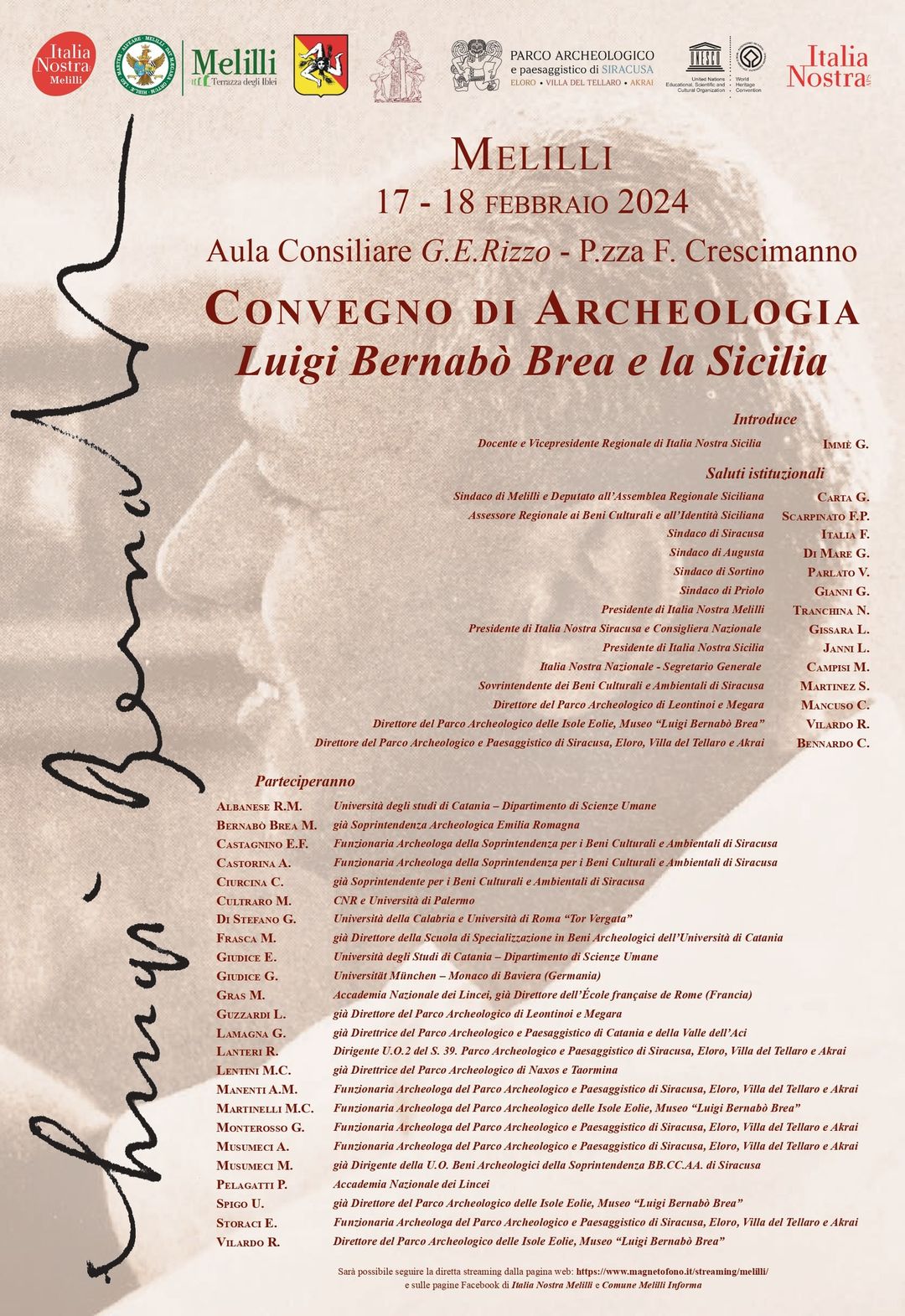
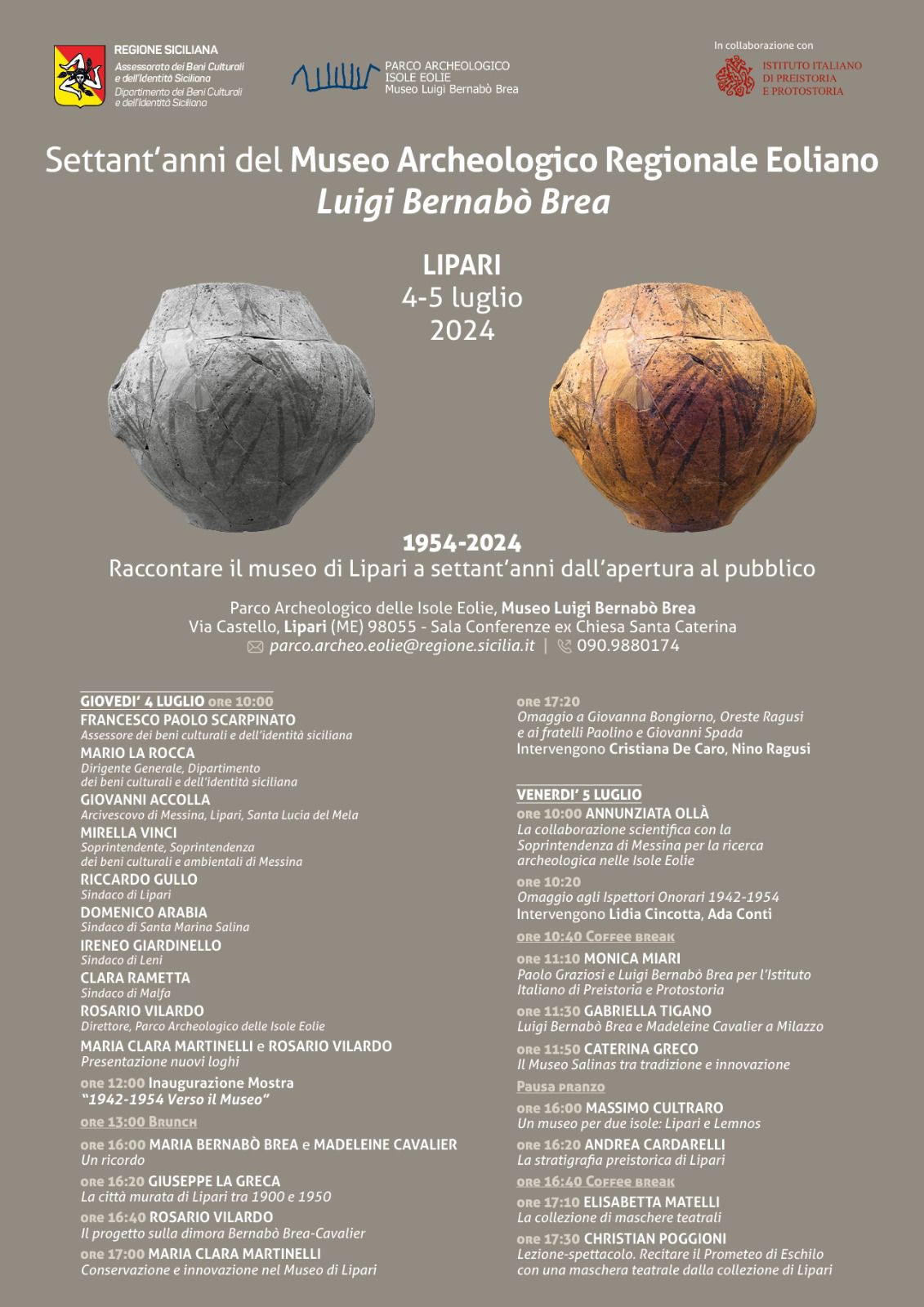
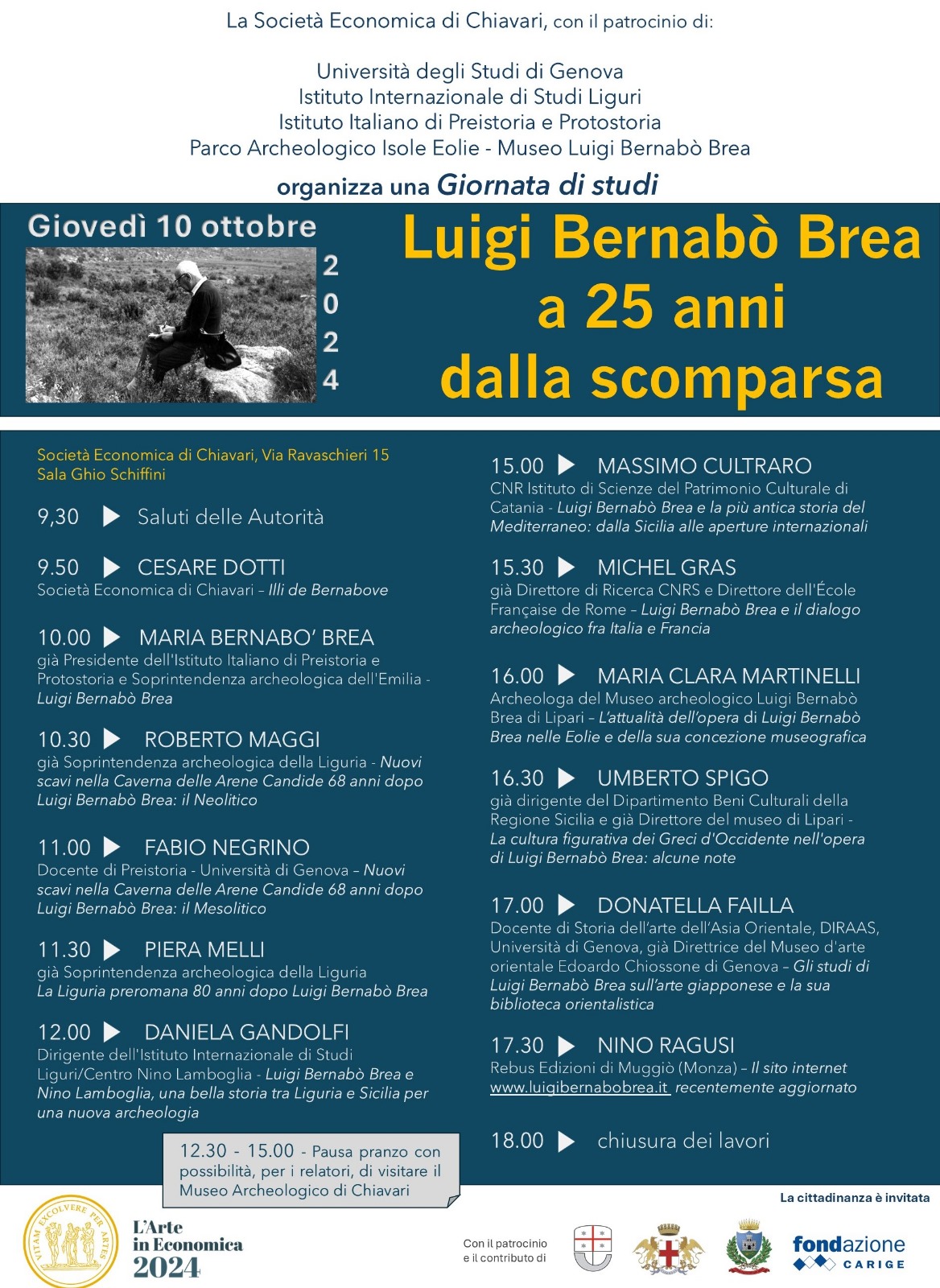




















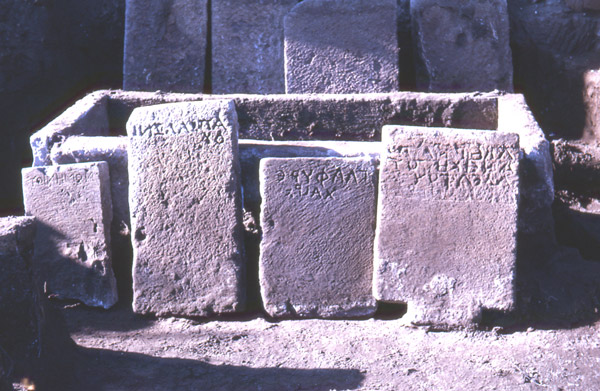
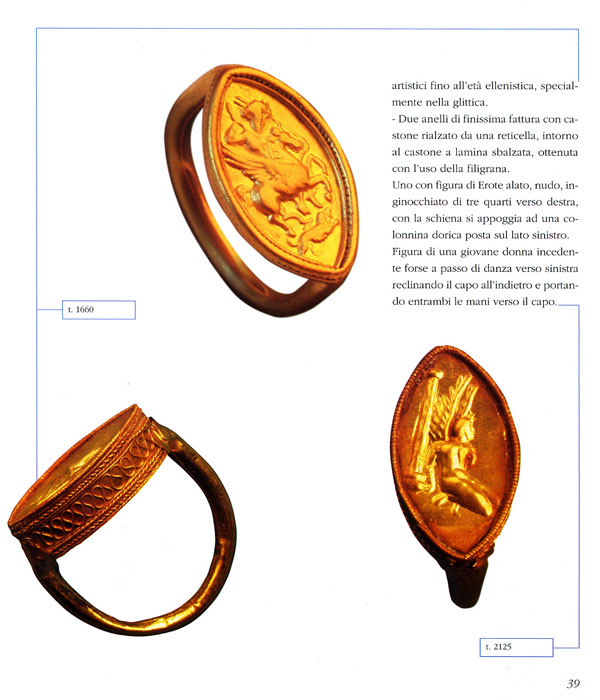



 The Arene Candide cave. The trench of the excavation during the first campaign, 1942.
The Arene Candide cave. The trench of the excavation during the first campaign, 1942.
 Arene Candide. The stratigraphic section revealed by the excavation in 1948-50.
Arene Candide. The stratigraphic section revealed by the excavation in 1948-50.
 The theatre of Akrai seen from the air
The theatre of Akrai seen from the air
 Il teatro di Akrai - Particolare dell'orchestra e della scena
Il teatro di Akrai - Particolare dell'orchestra e della scena
 Domenico Ryolo and Madeleine Cavalier on the excavation of the necropolis on the Isthmus of Milazzo in 1950
Domenico Ryolo and Madeleine Cavalier on the excavation of the necropolis on the Isthmus of Milazzo in 1950
 The anaktoron of Pantalica
The anaktoron of Pantalica
 The Greek theatre of Syracuse
The Greek theatre of Syracuse
 A view of the monumental zone of Syracuse
A view of the monumental zone of Syracuse
 Tyndaris. A stretch of the ancient circuit of walls
Tyndaris. A stretch of the ancient circuit of walls
 The teathre
The teathre
 The north side of the "basilica" reconstructed in the 1950s
The north side of the "basilica" reconstructed in the 1950s
 Insula IV. View from the South-East
Insula IV. View from the South-East
 Lipari. The Castello seen from the sea
Lipari. The Castello seen from the sea
 The Castello of Lipari. Detail of the huts of the middle Bronze Age superimposed over those of the early Bronze Age
The Castello of Lipari. Detail of the huts of the middle Bronze Age superimposed over those of the early Bronze Age
 Lipari. View of the excavation of the Piazza Monfalcone burial site, with a stretch of the first Greek circuit of walls
Lipari. View of the excavation of the Piazza Monfalcone burial site, with a stretch of the first Greek circuit of walls
 The exterior of the Greek walls with the square tower that protected the city gatewa
The exterior of the Greek walls with the square tower that protected the city gatewa
 The Greek walls. Detail of the facing in ashlared blocks laid in isodomic courses
The Greek walls. Detail of the facing in ashlared blocks laid in isodomic courses
 Lipari. Necropolis excavation XXIII, 1985
Lipari. Necropolis excavation XXIII, 1985
 The thermal complex of San Calogero on Lipari, in a veduta painted by Jean Houel in 1776
The thermal complex of San Calogero on Lipari, in a veduta painted by Jean Houel in 1776
 The interior of the thermal Tholos
The interior of the thermal Tholos









